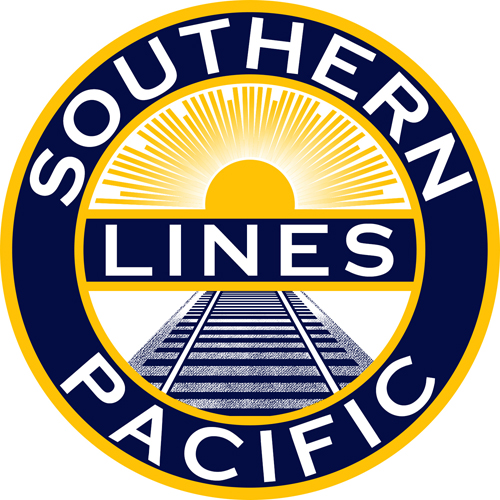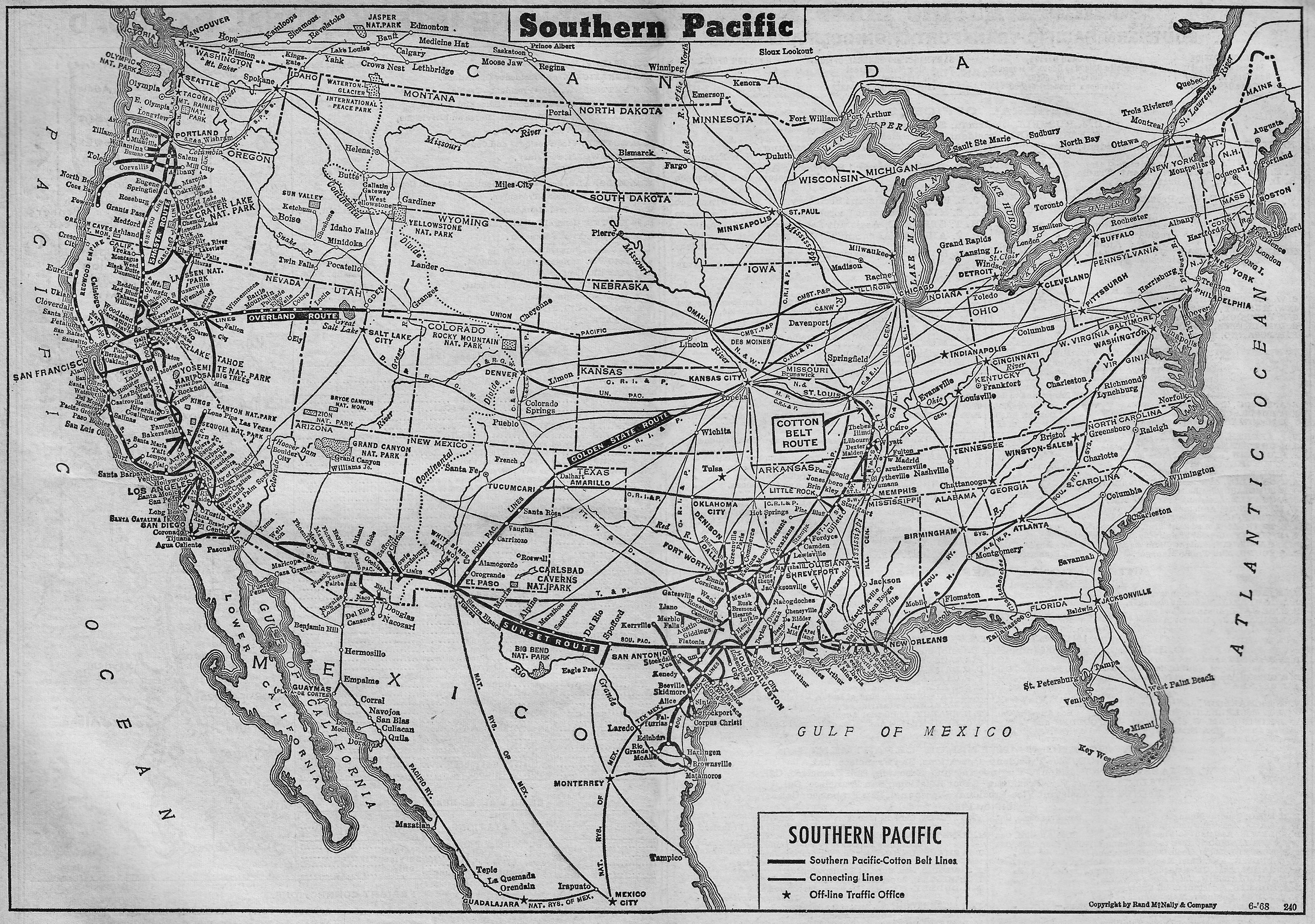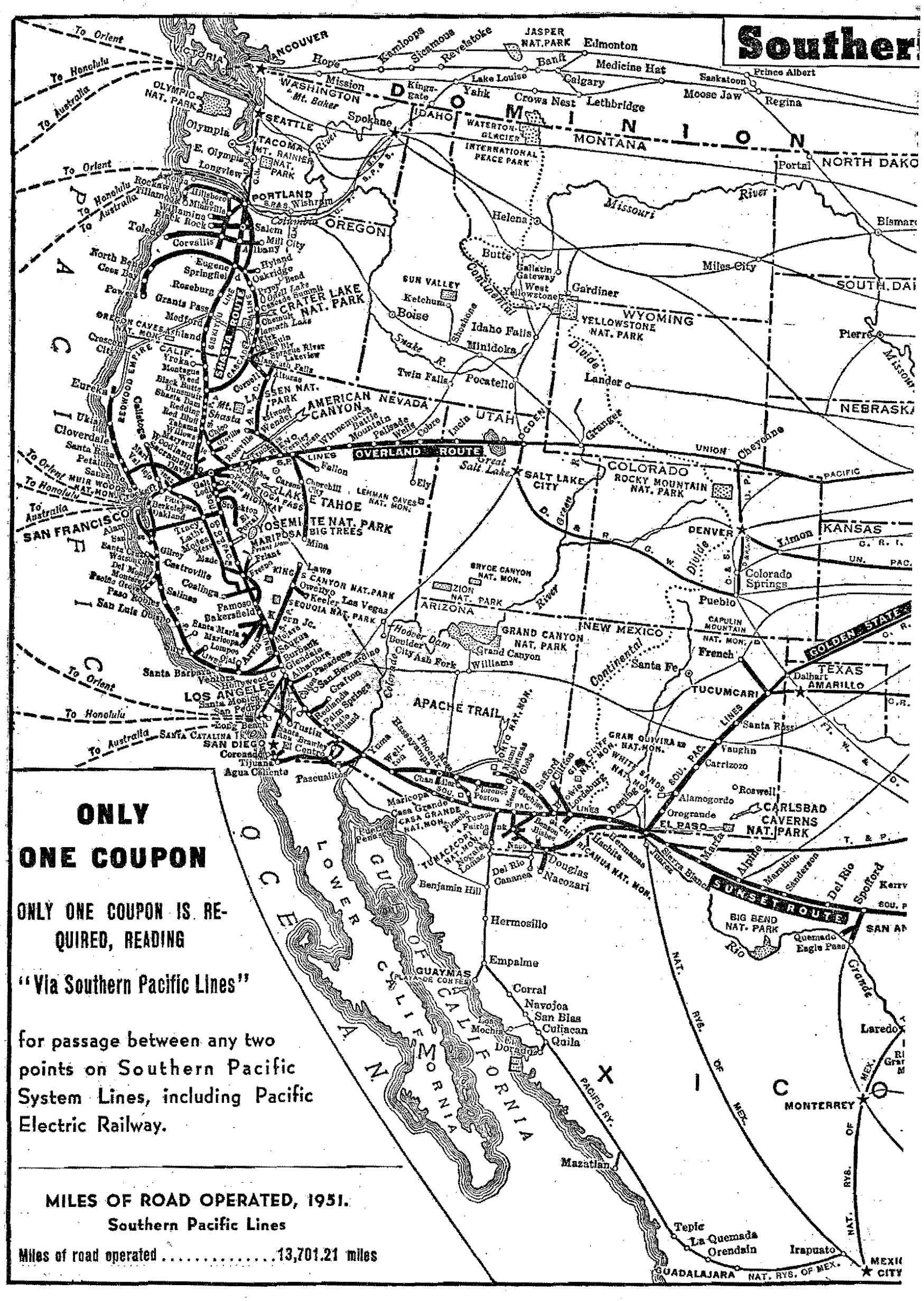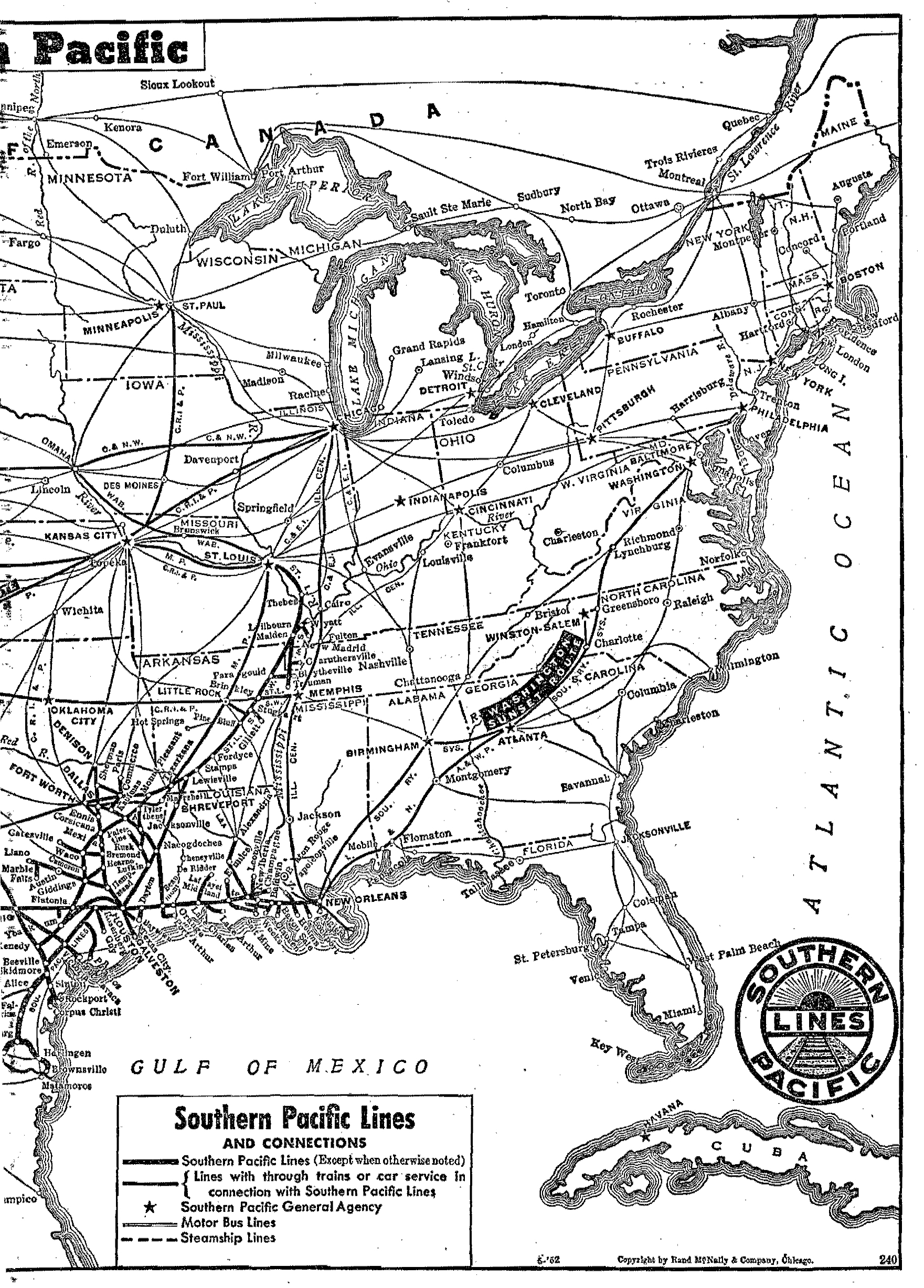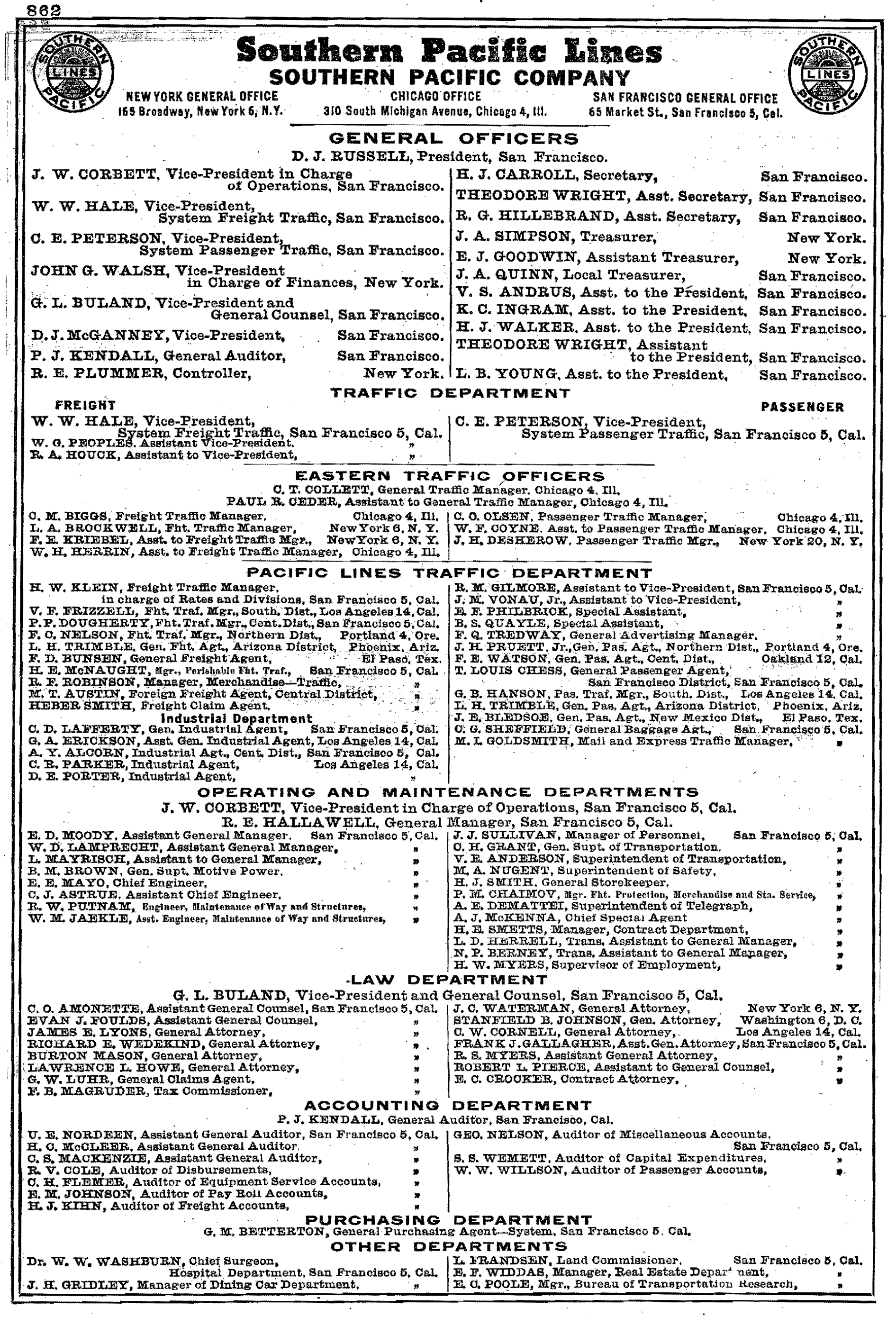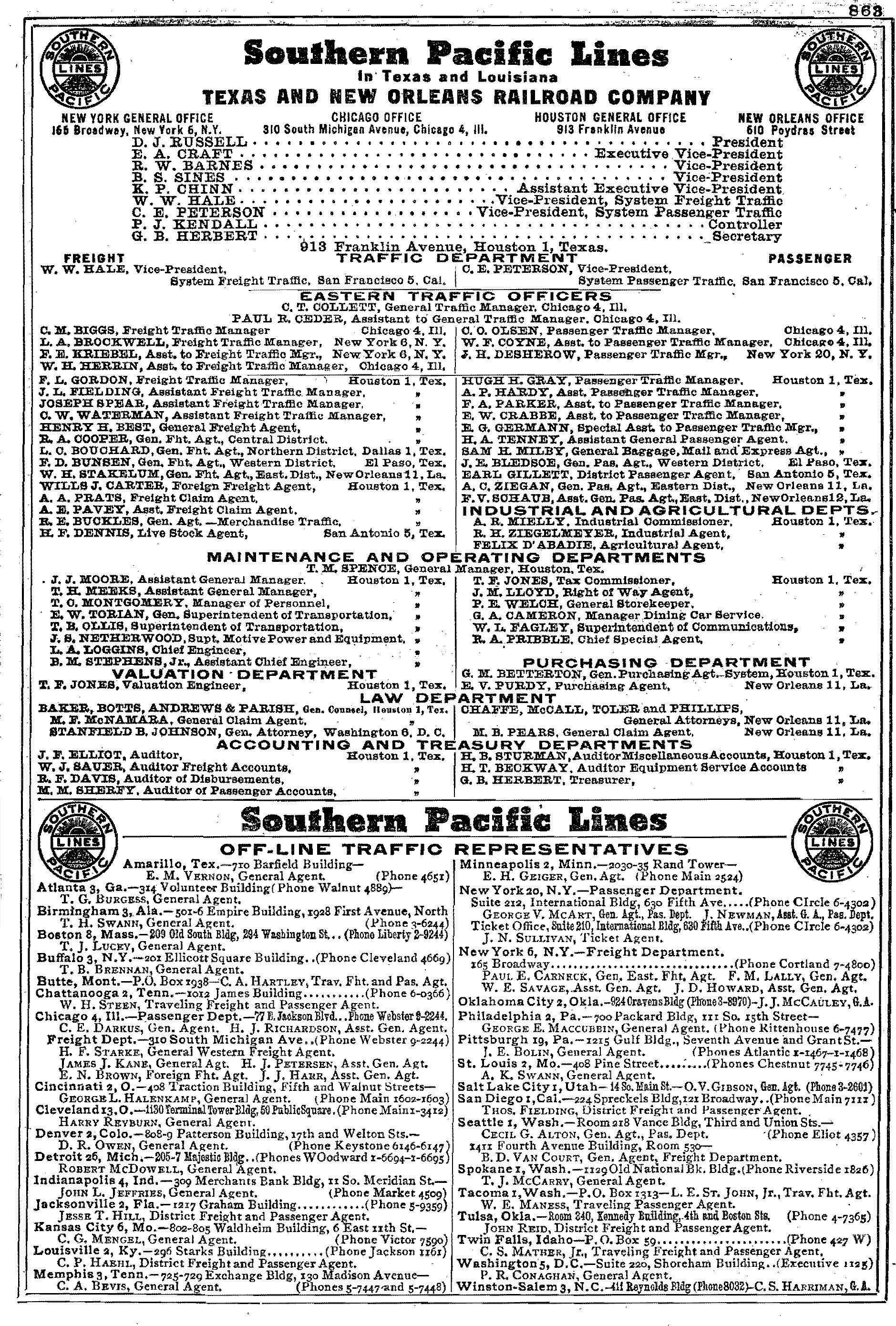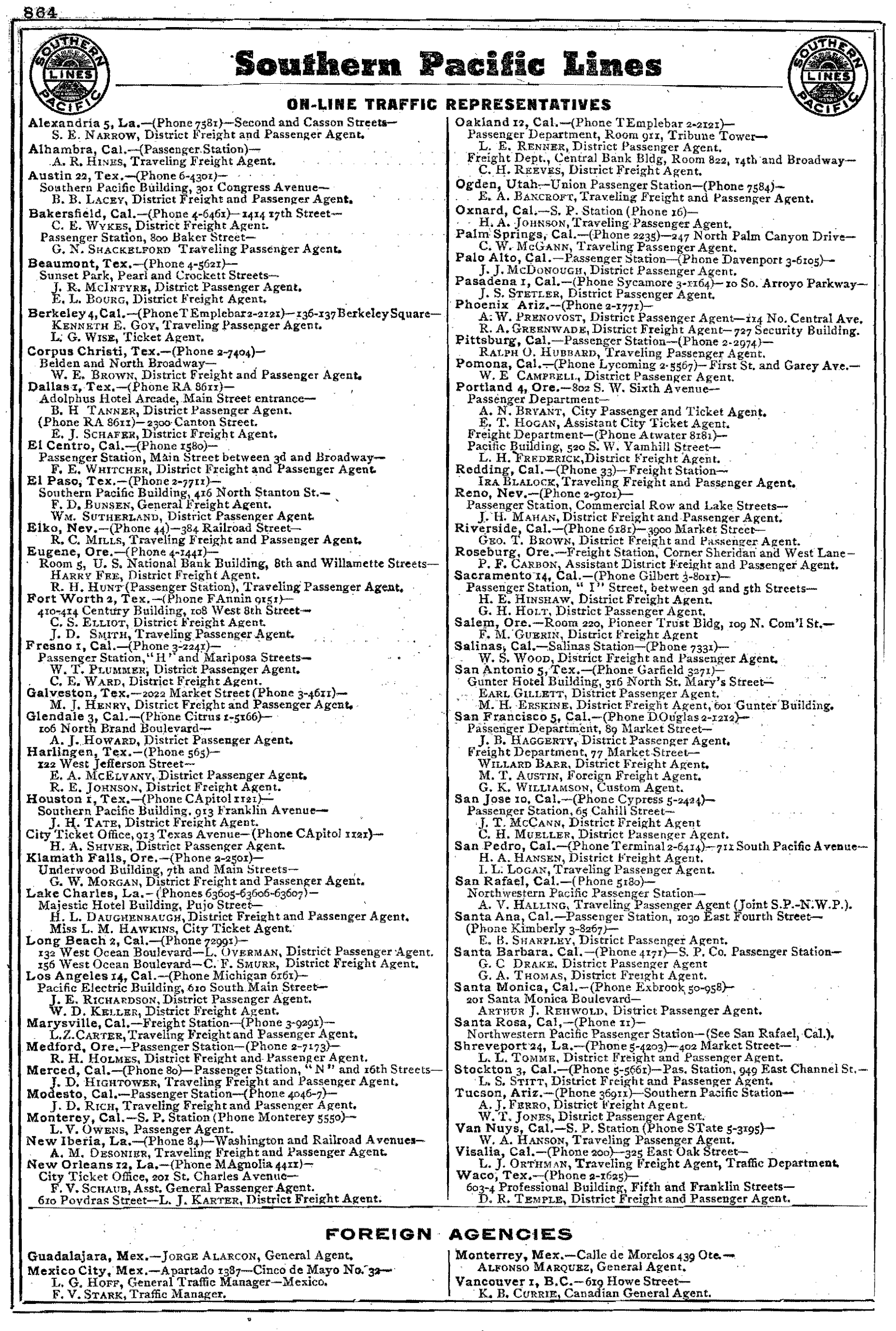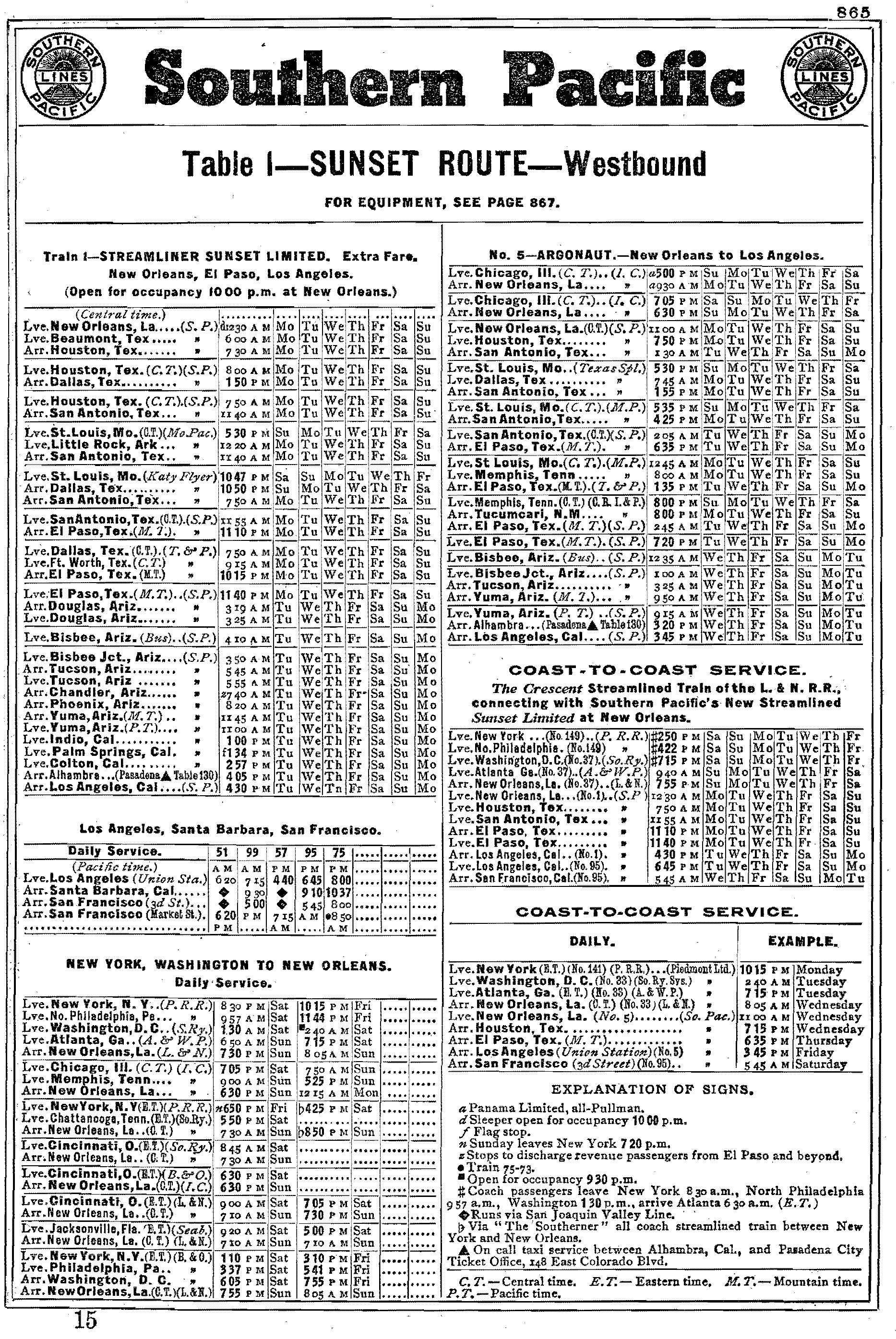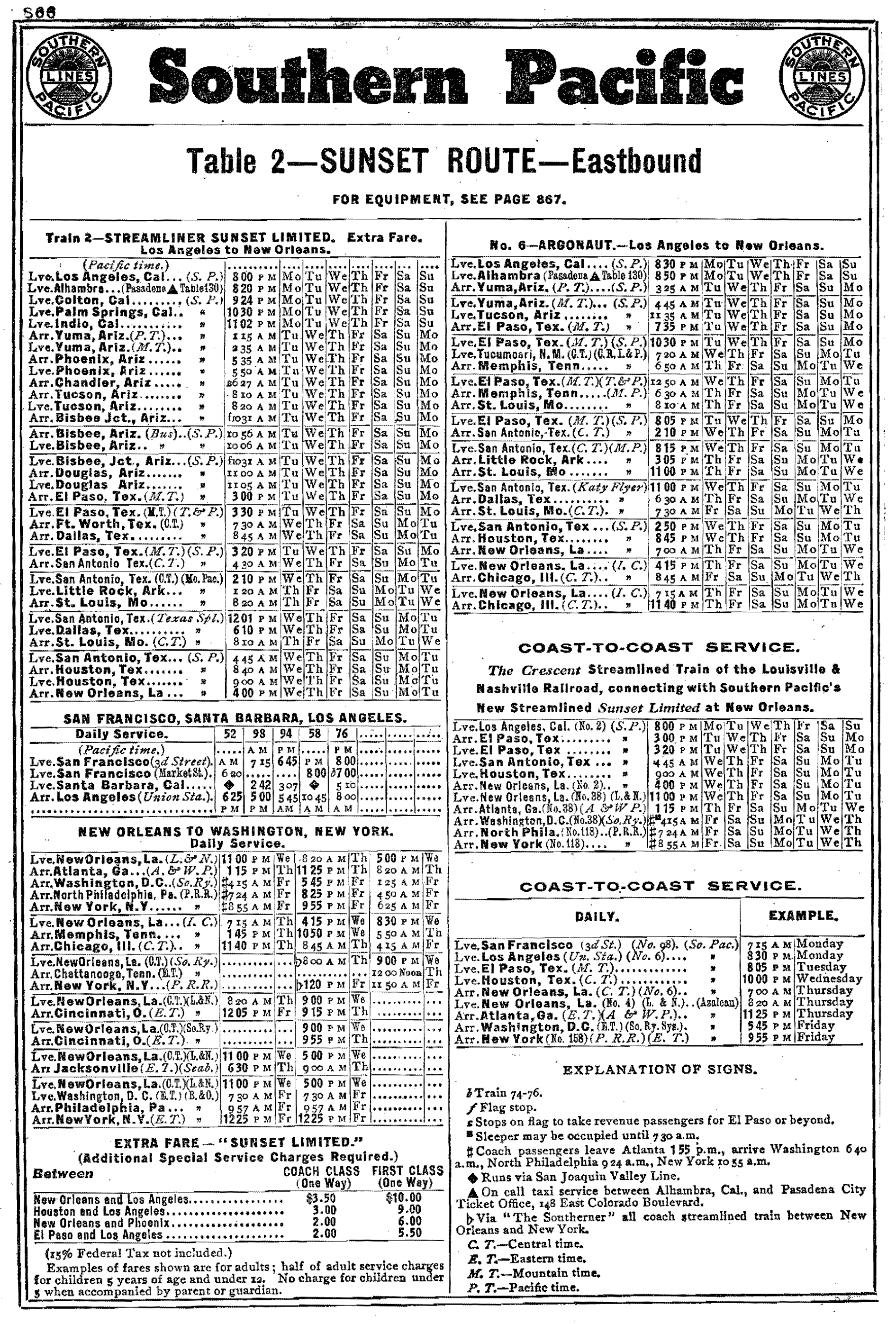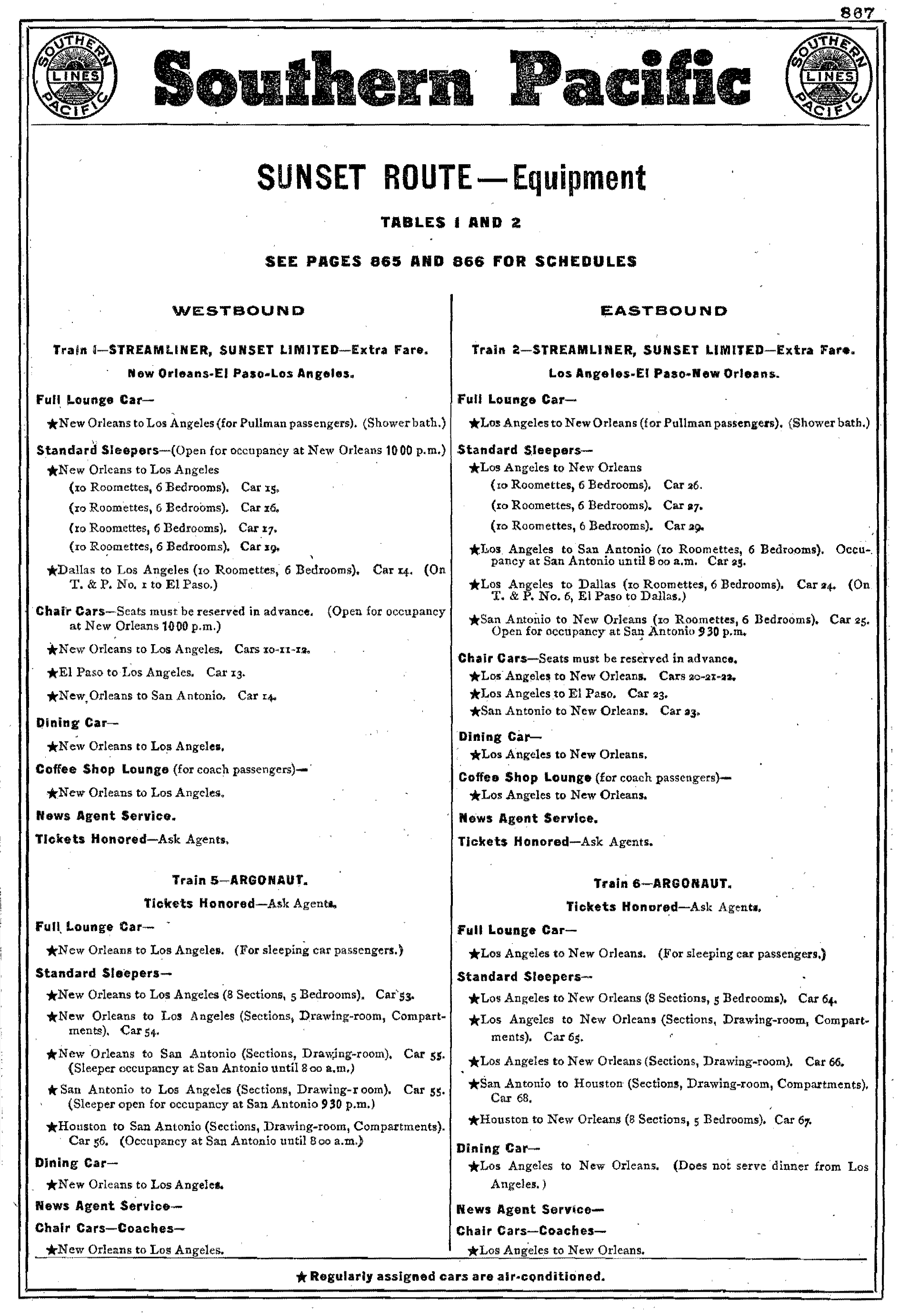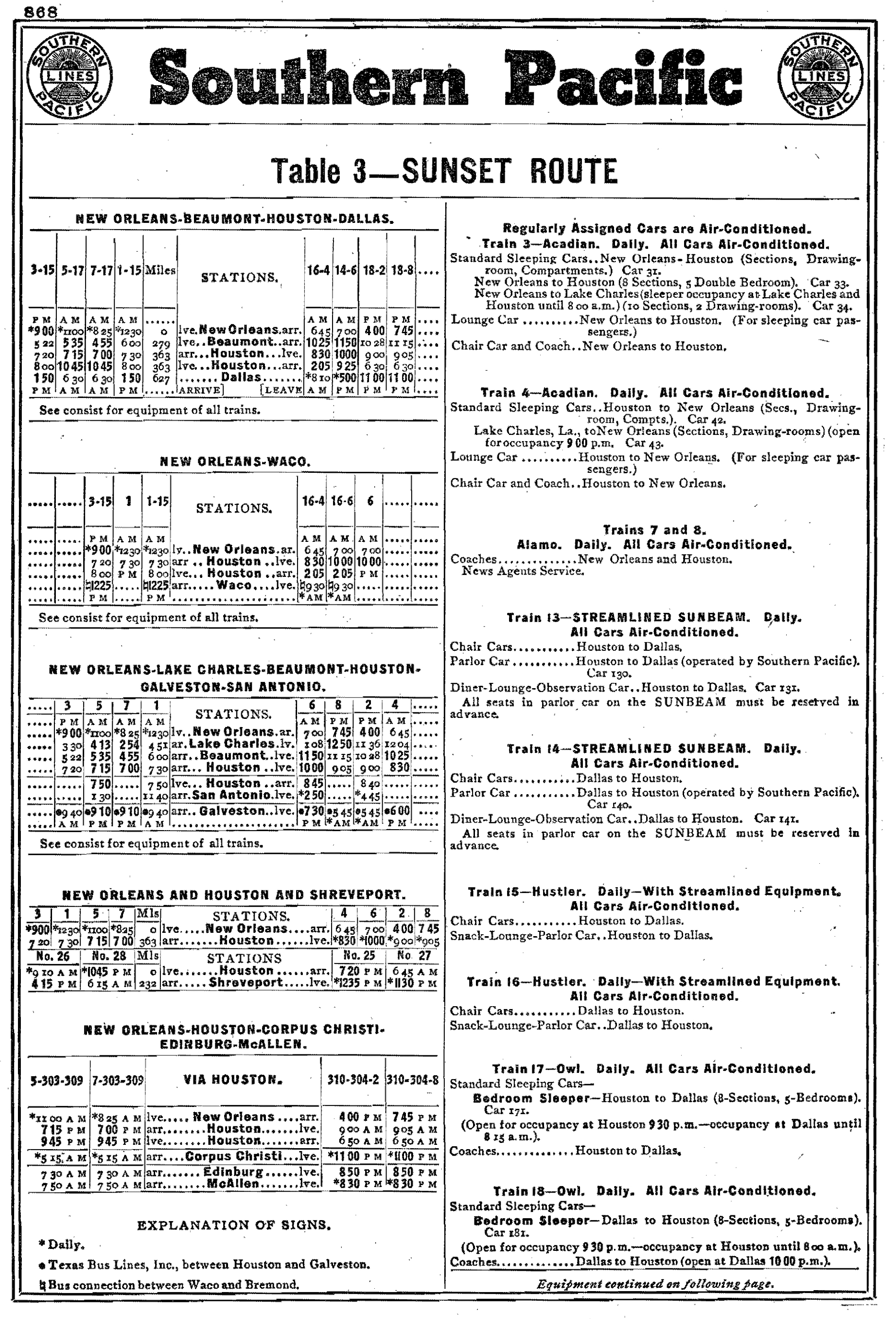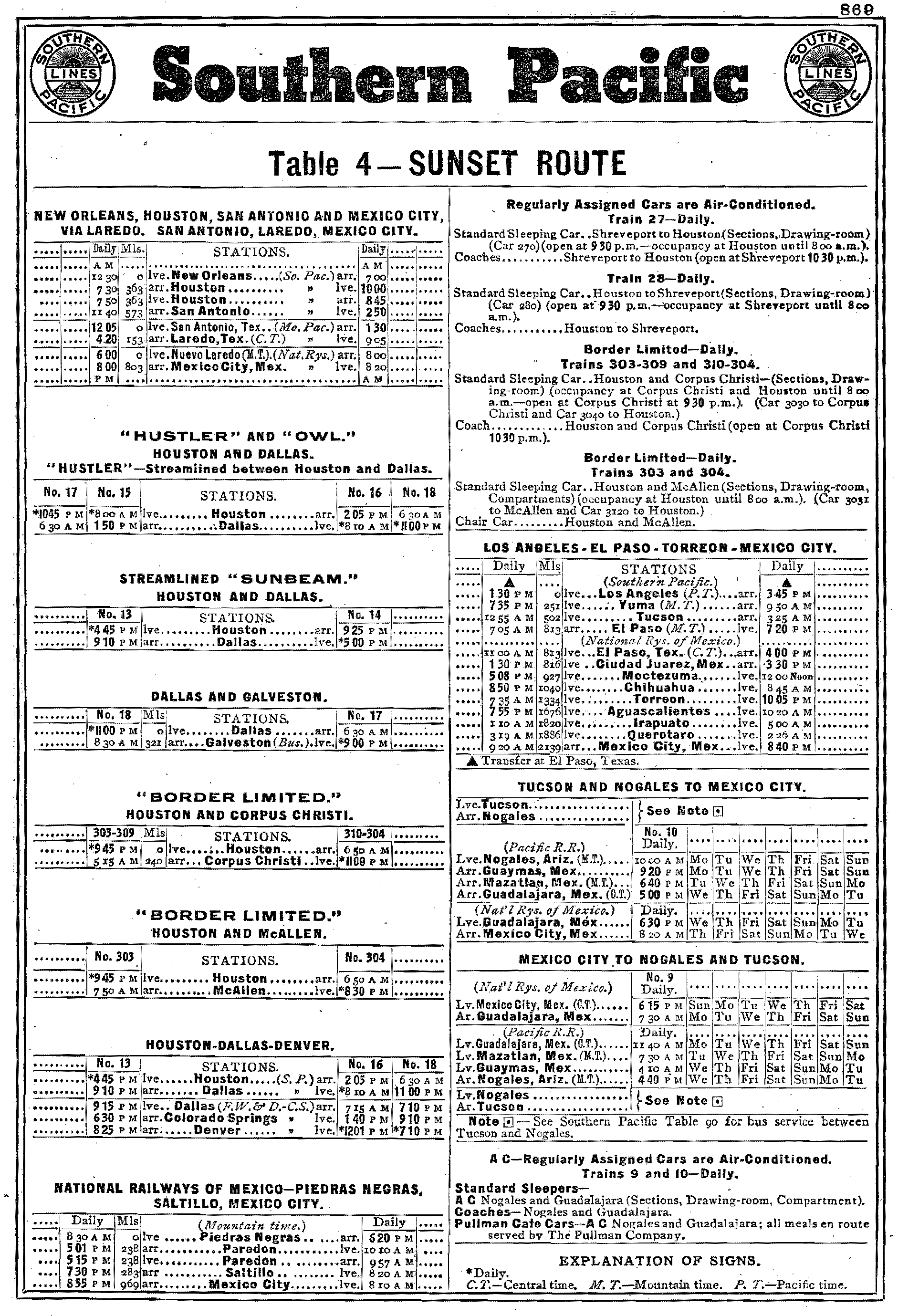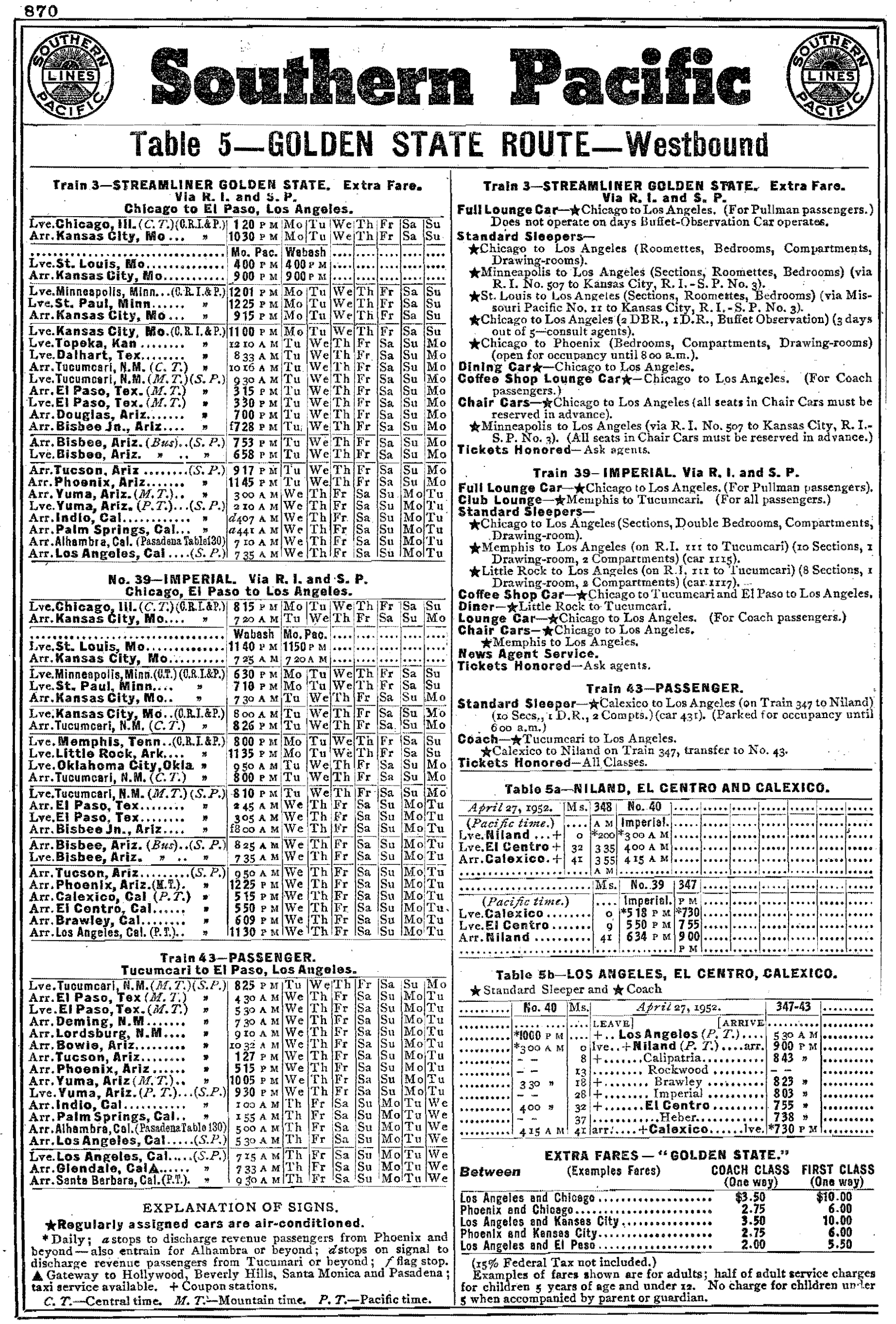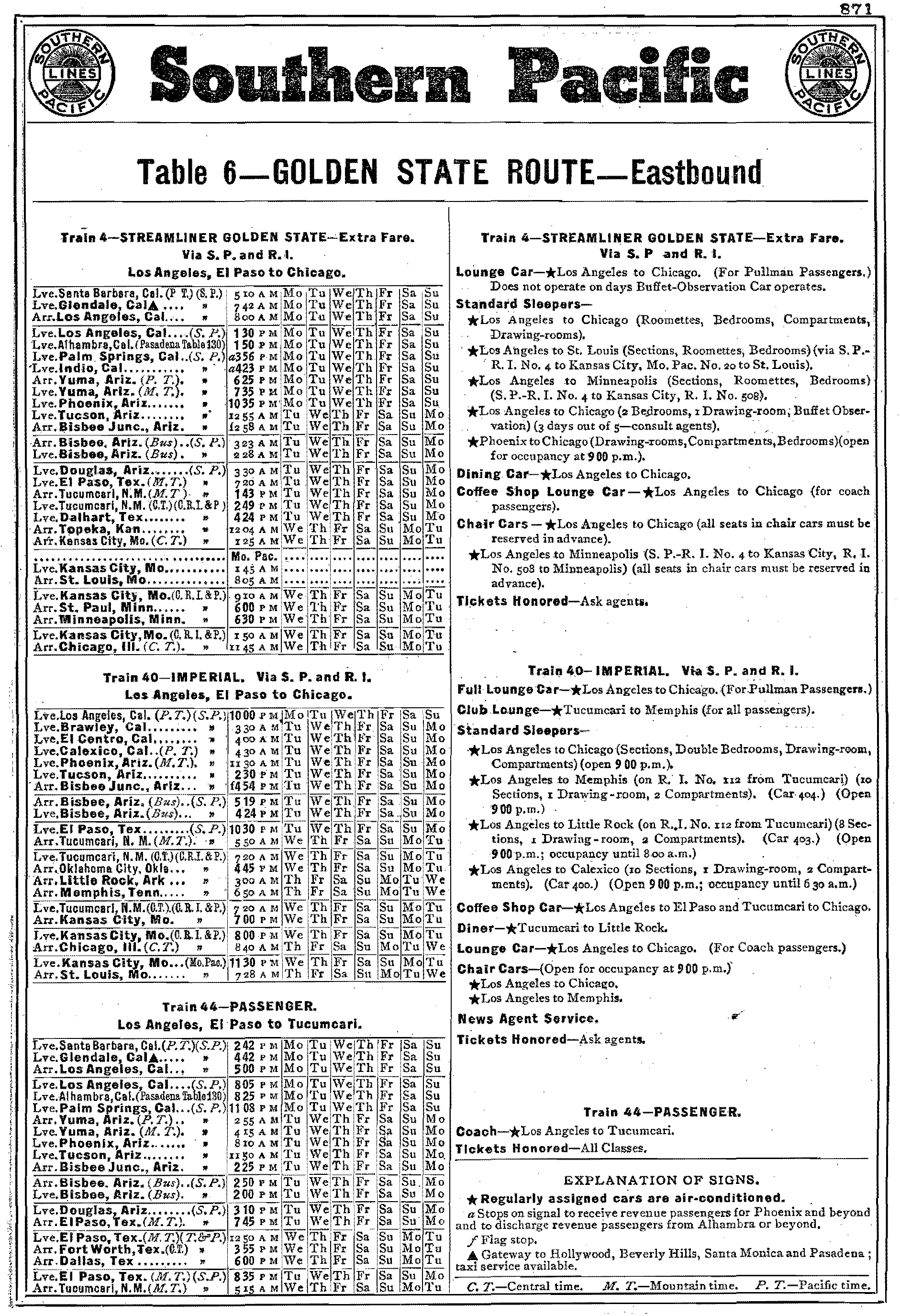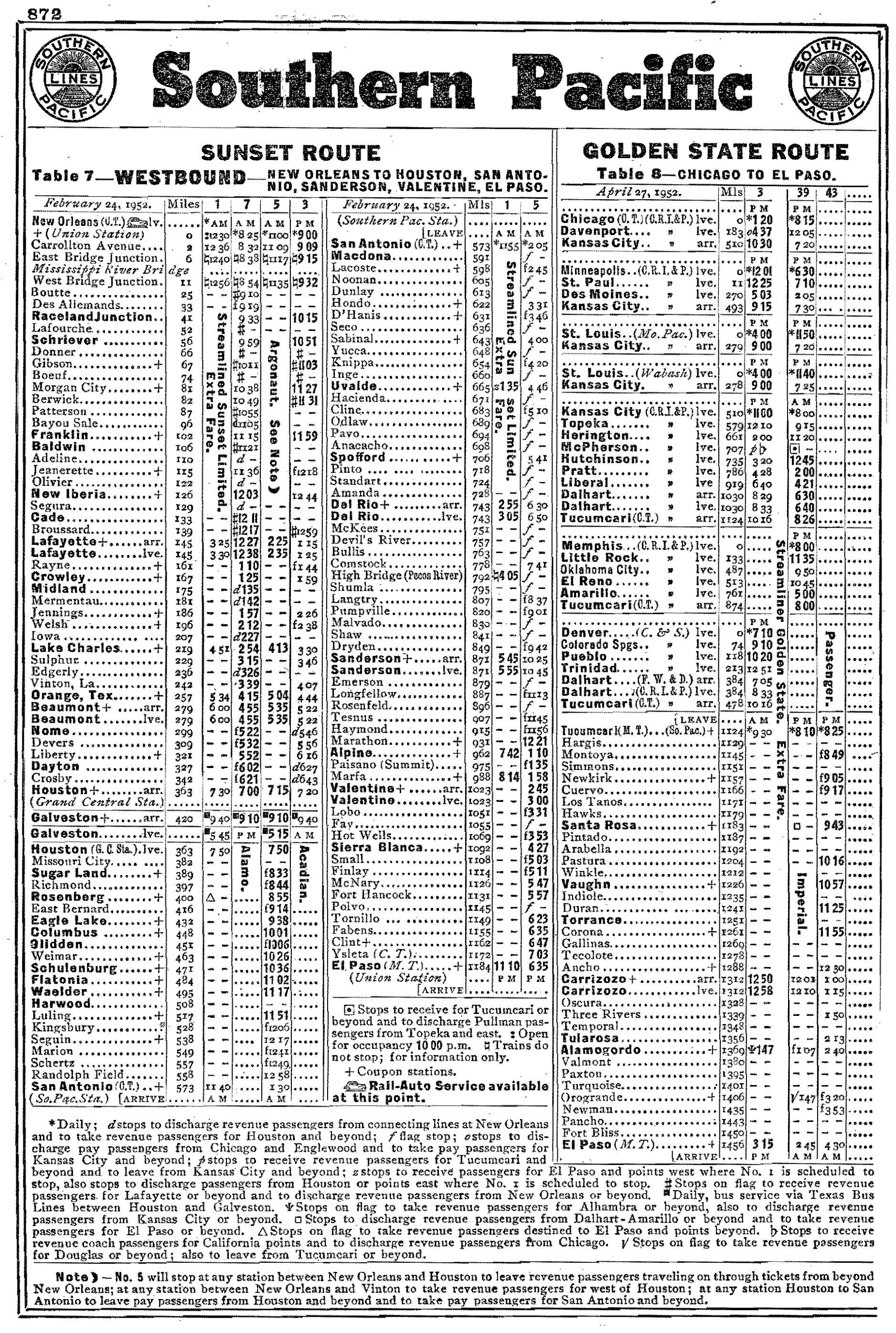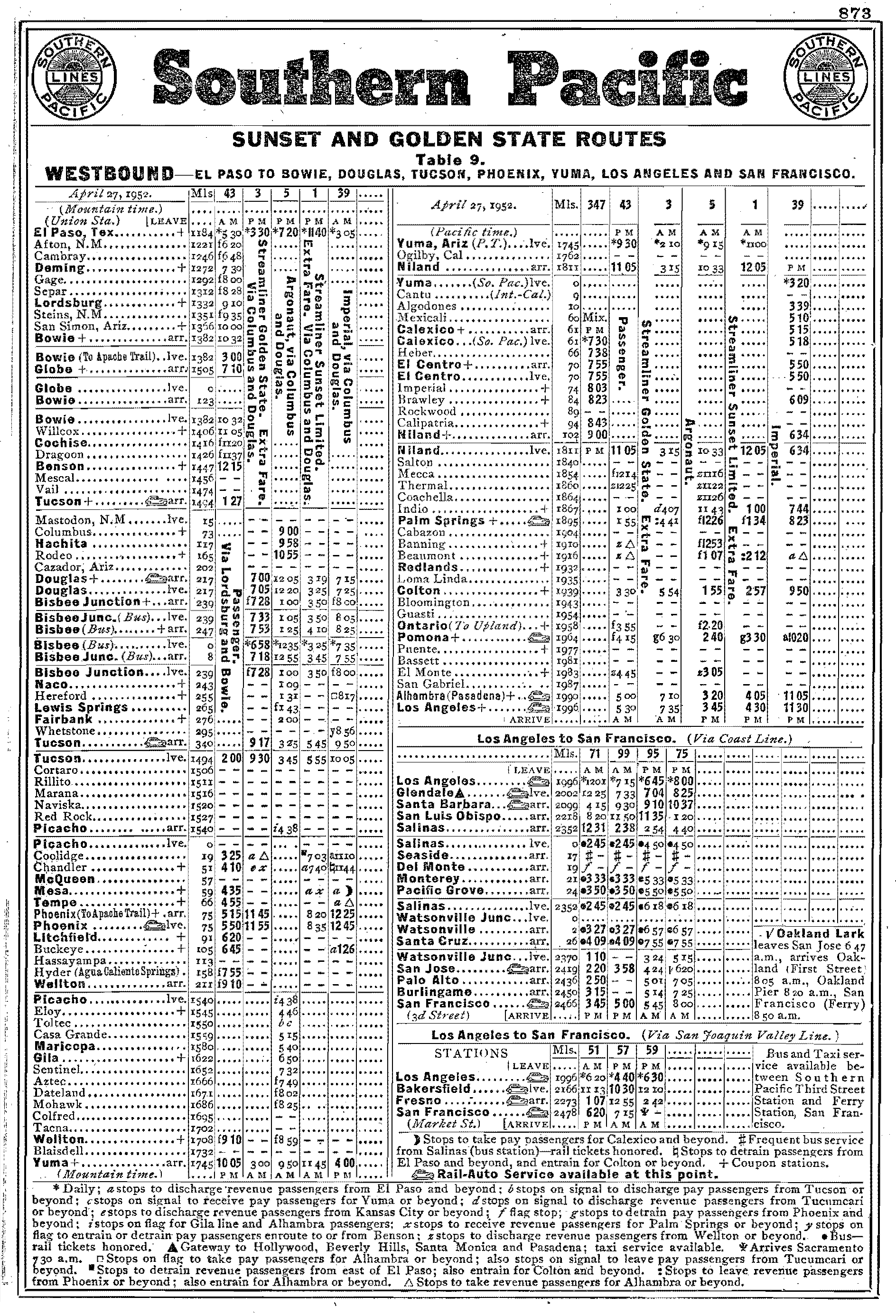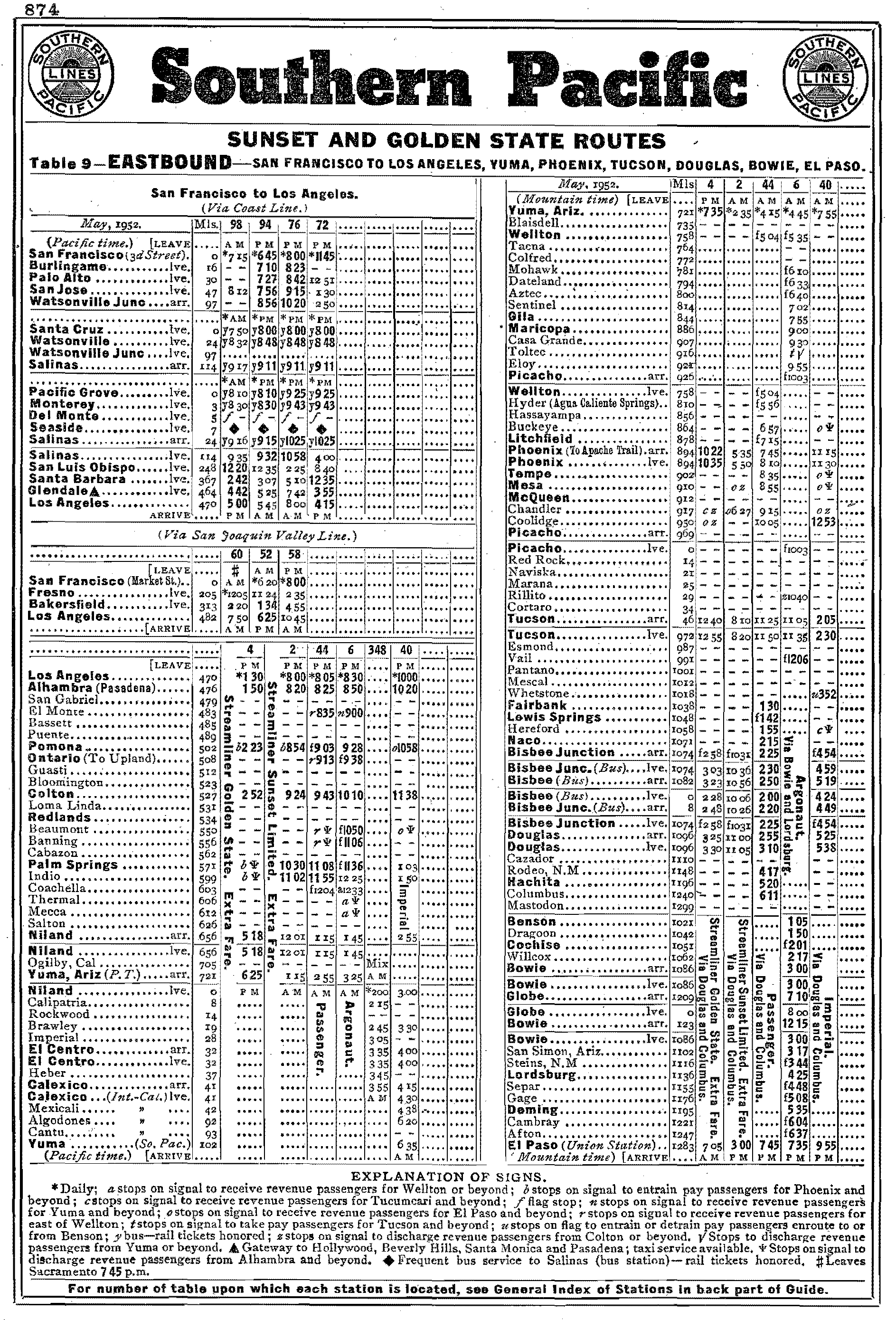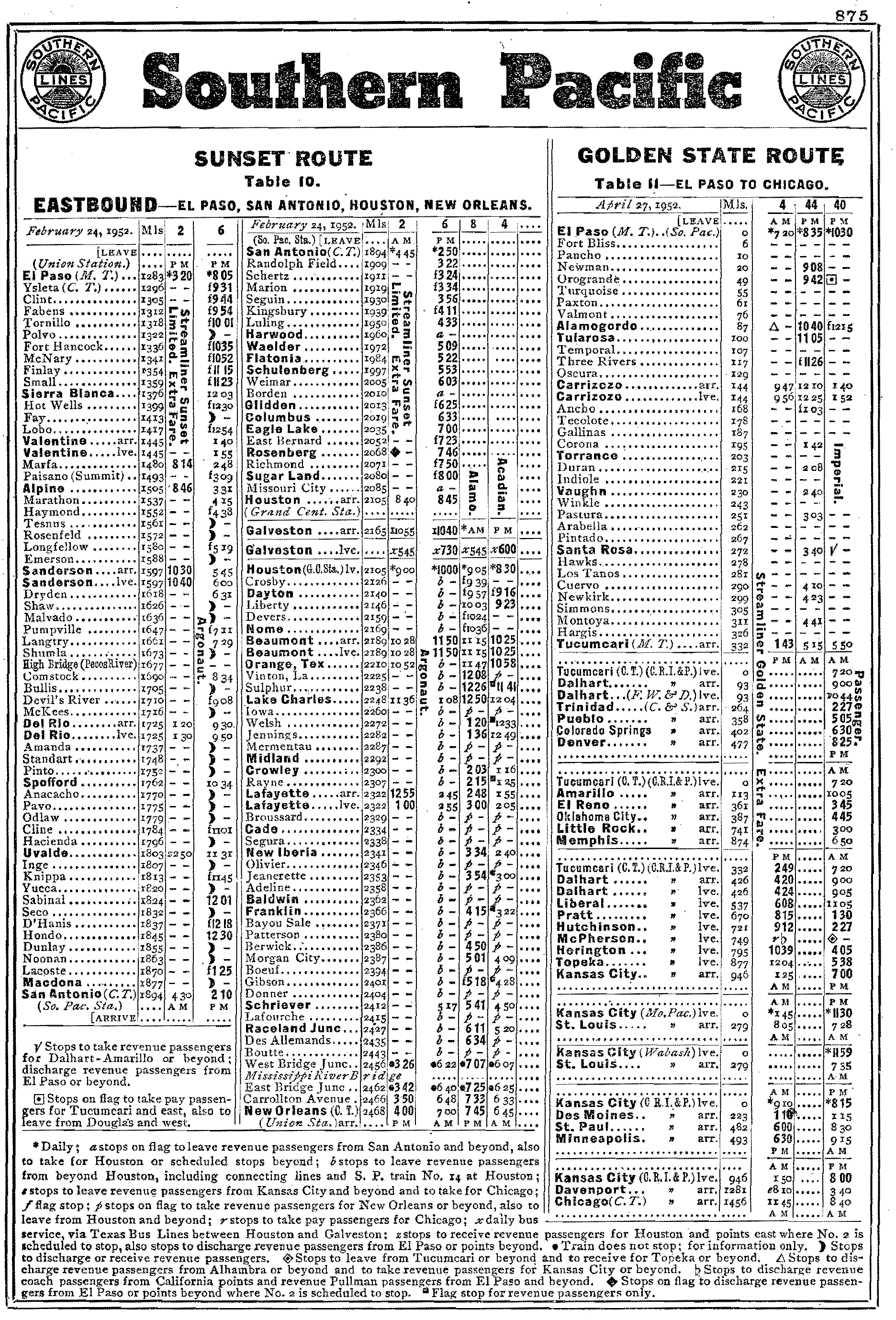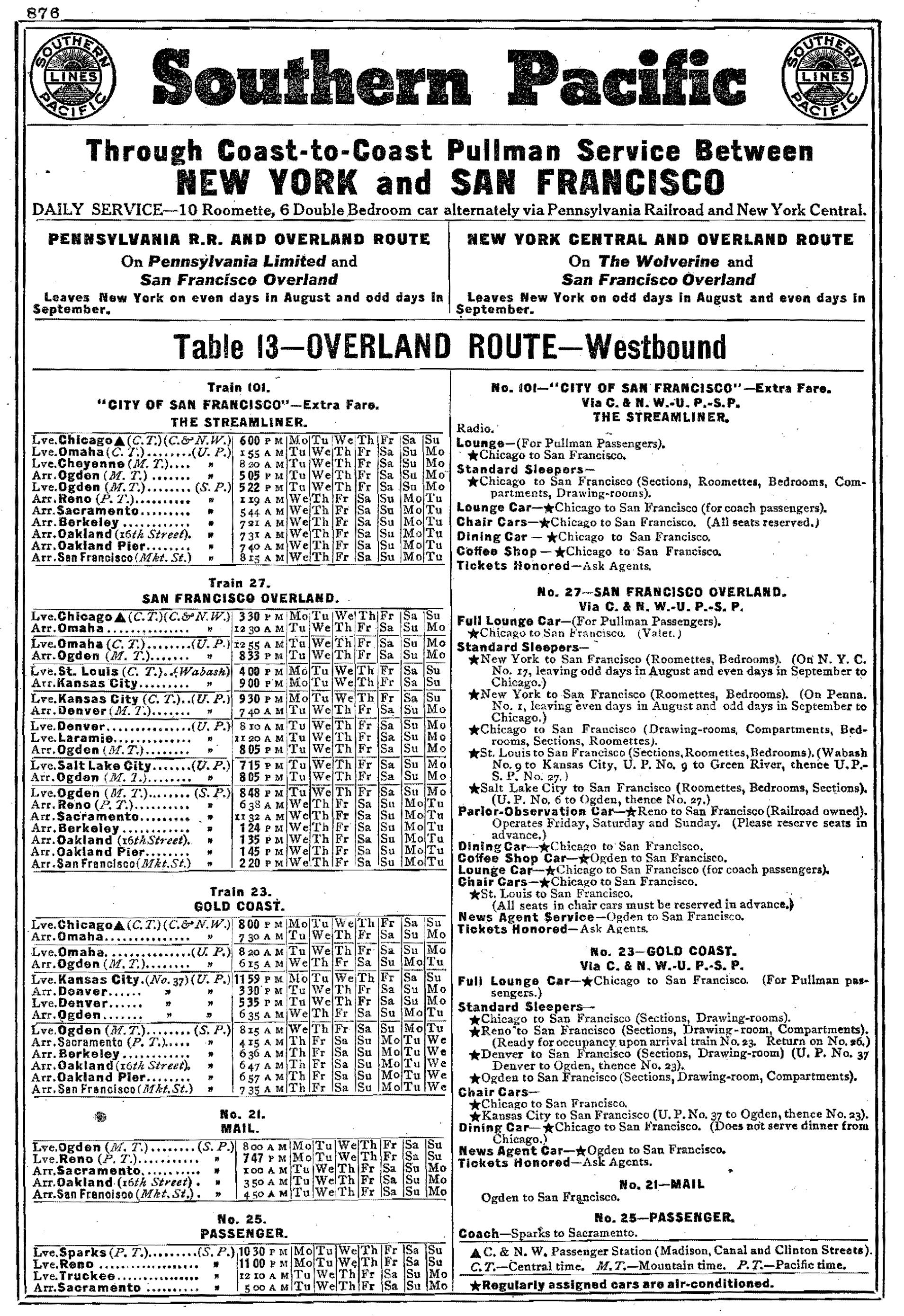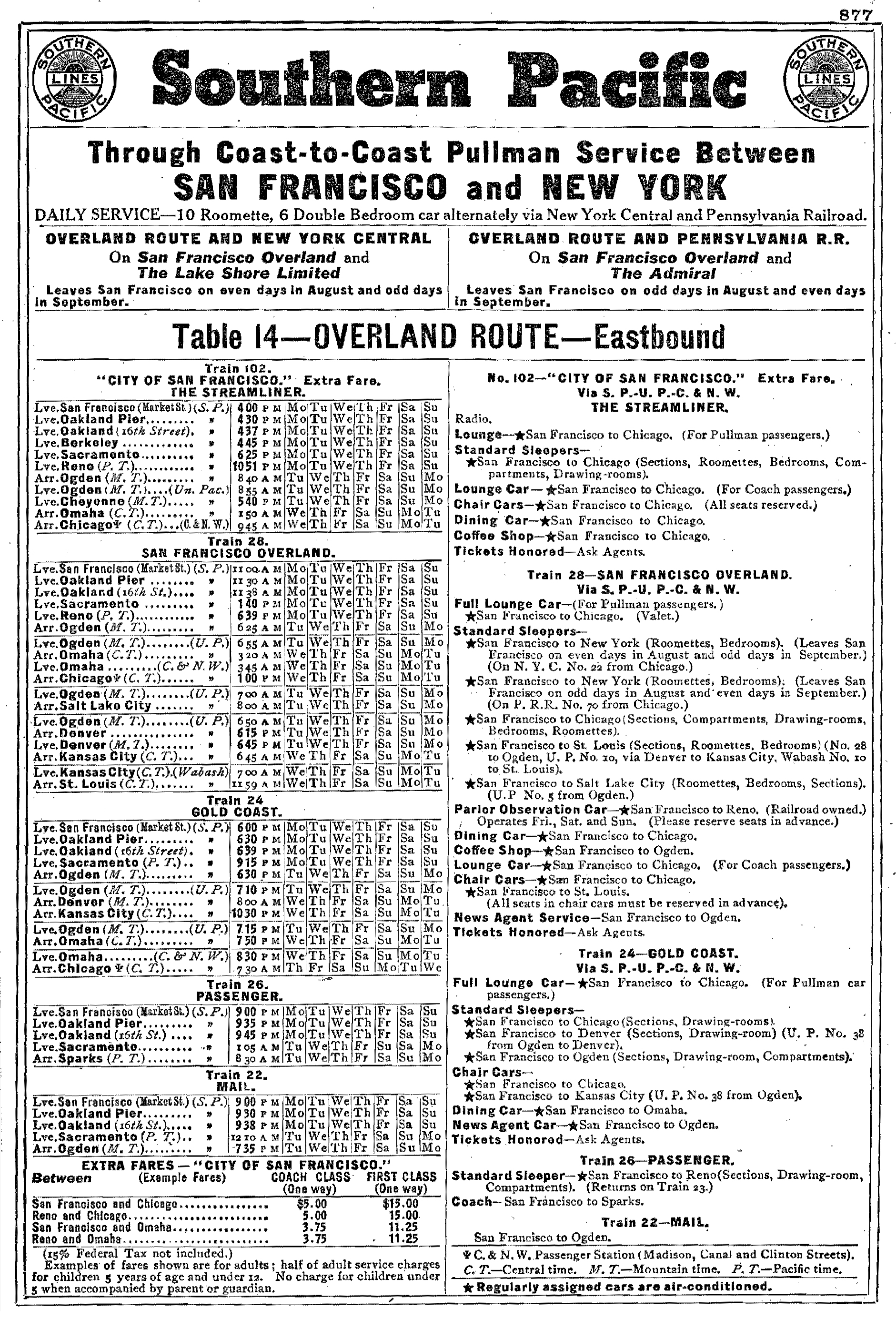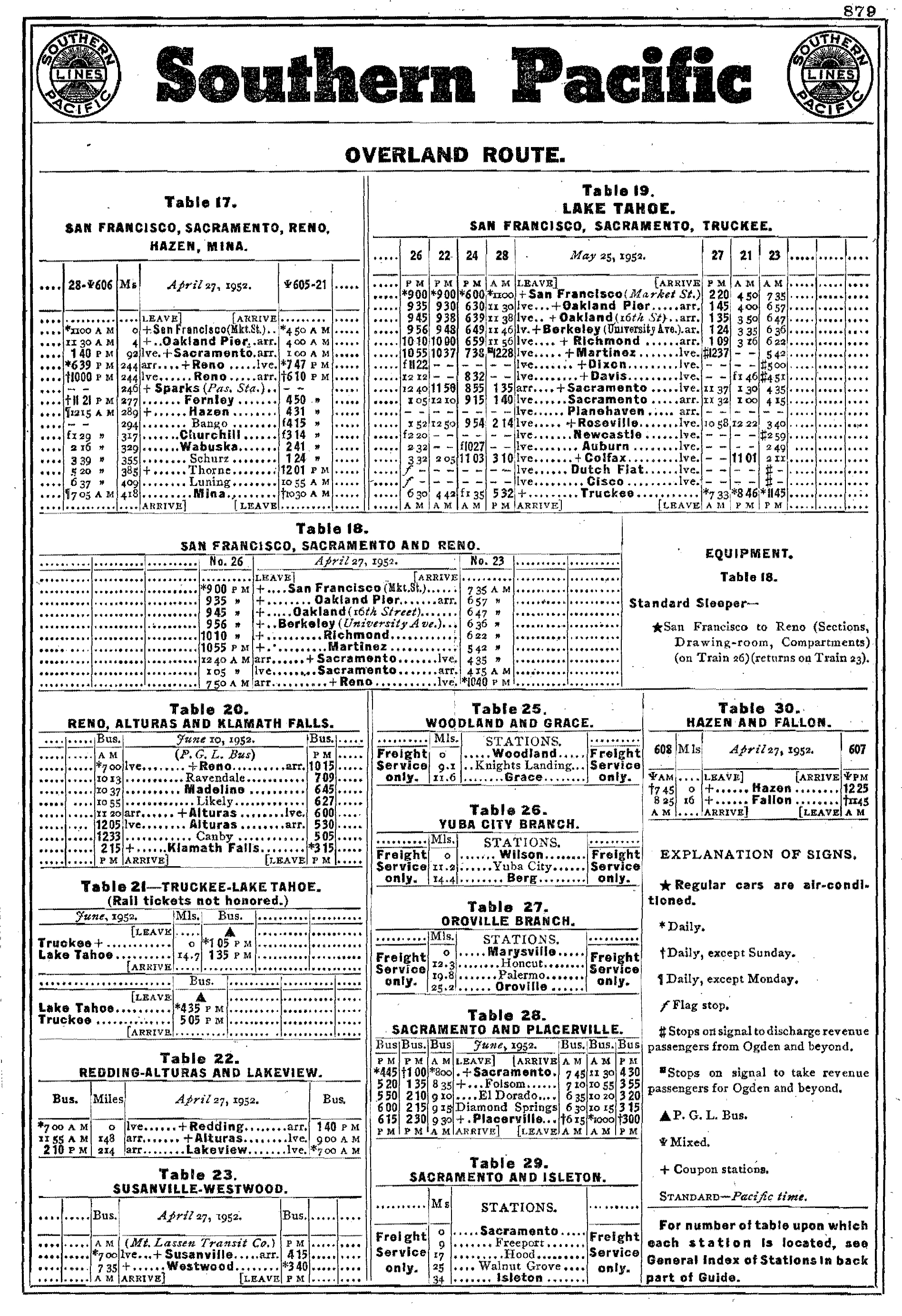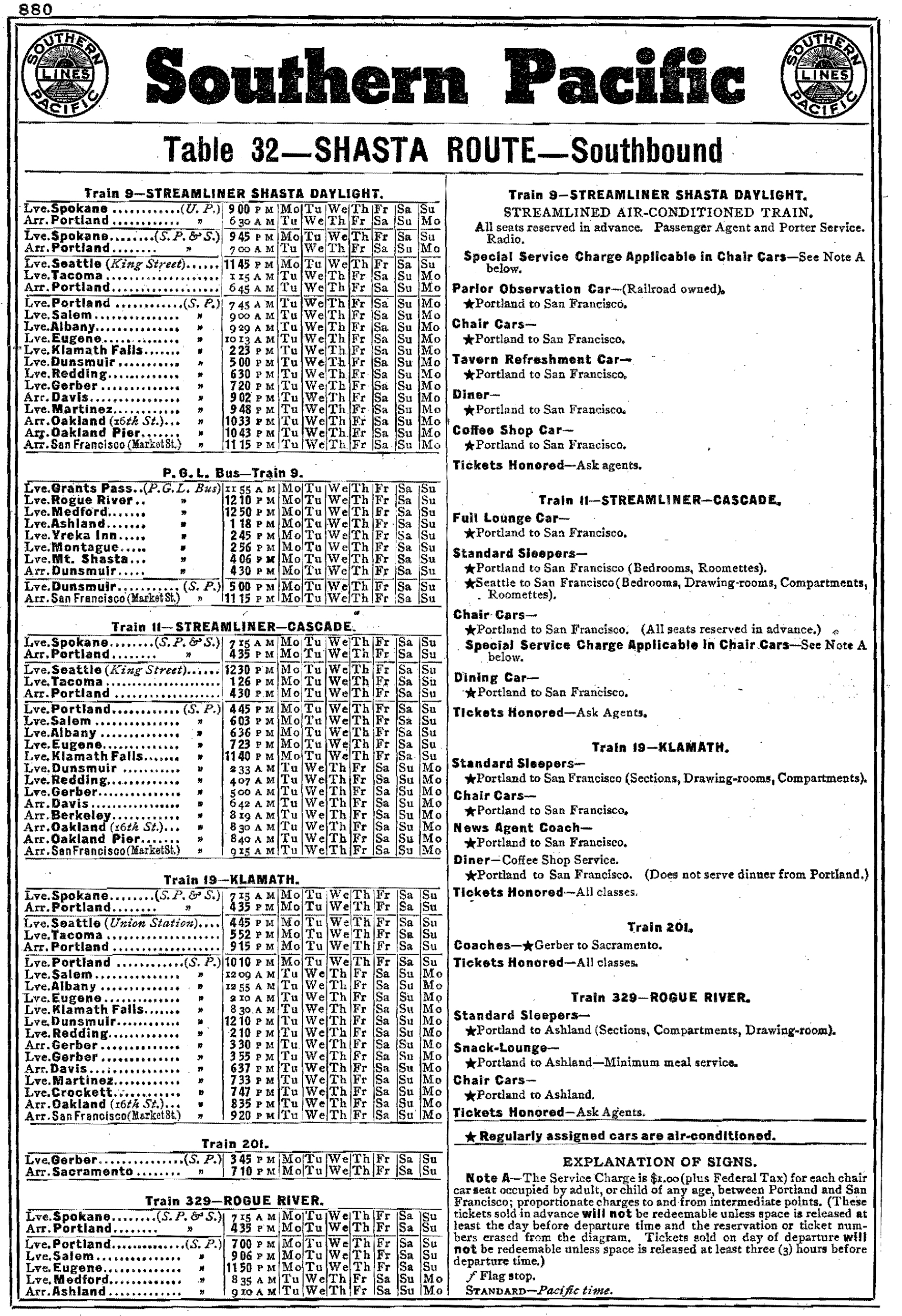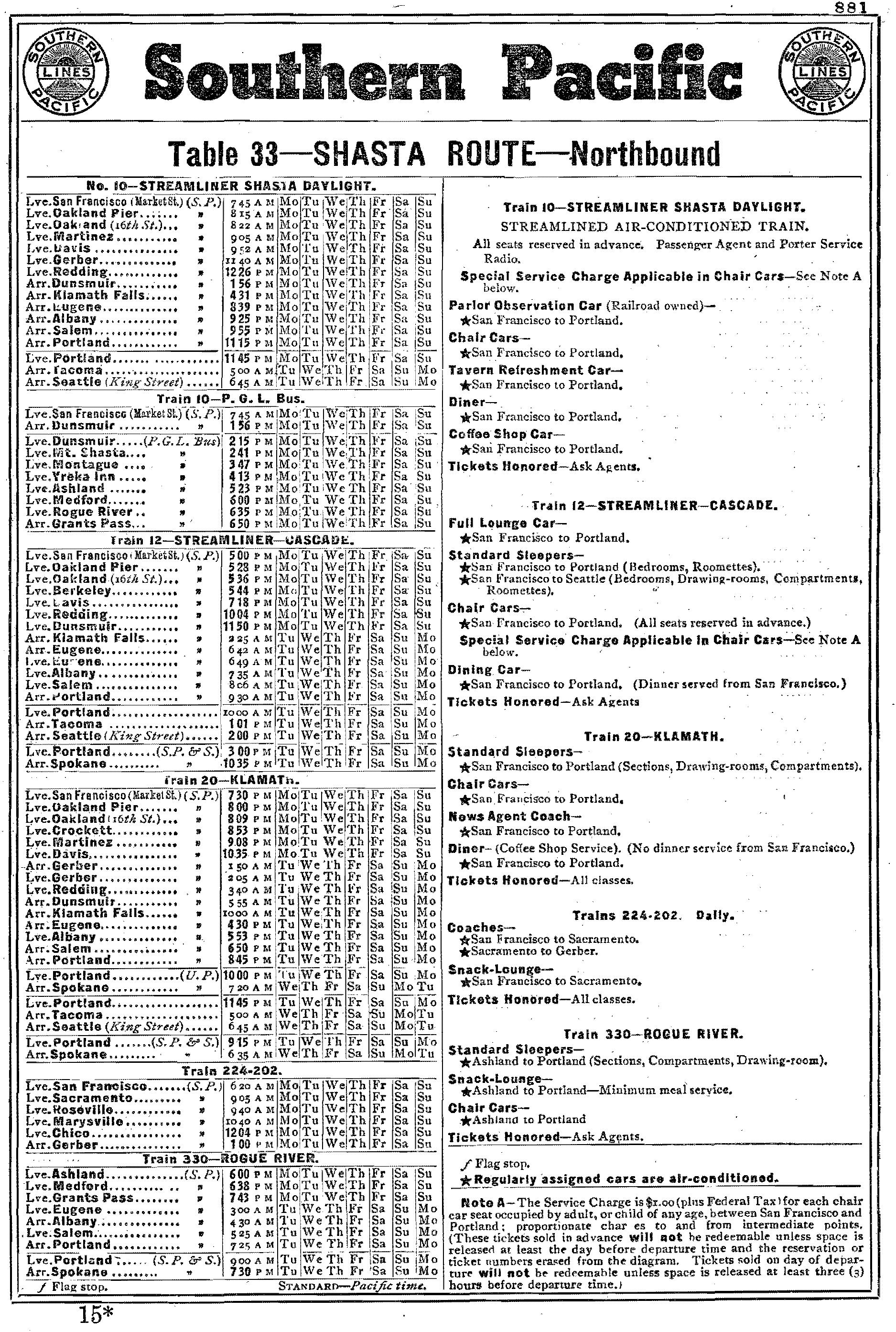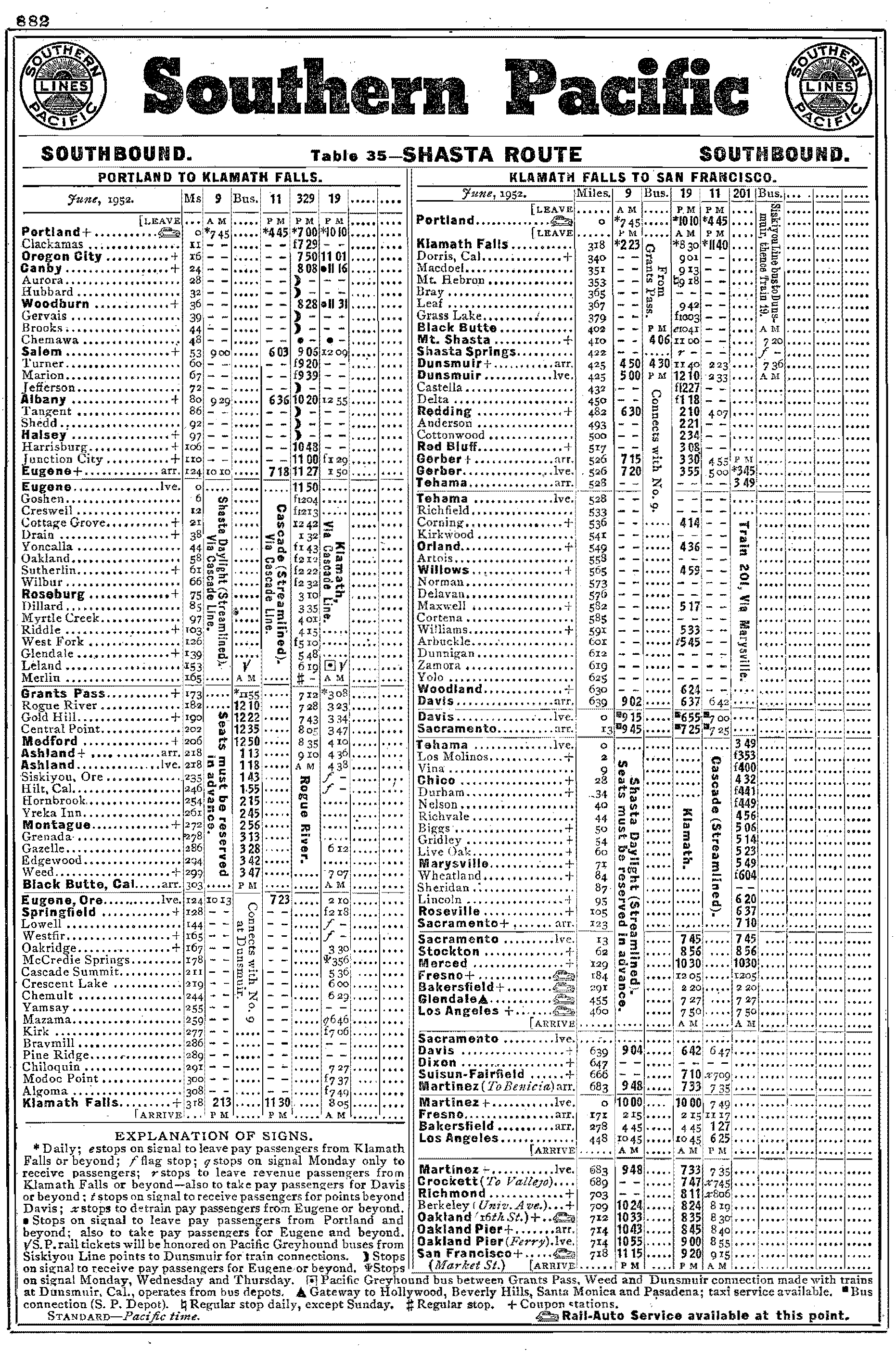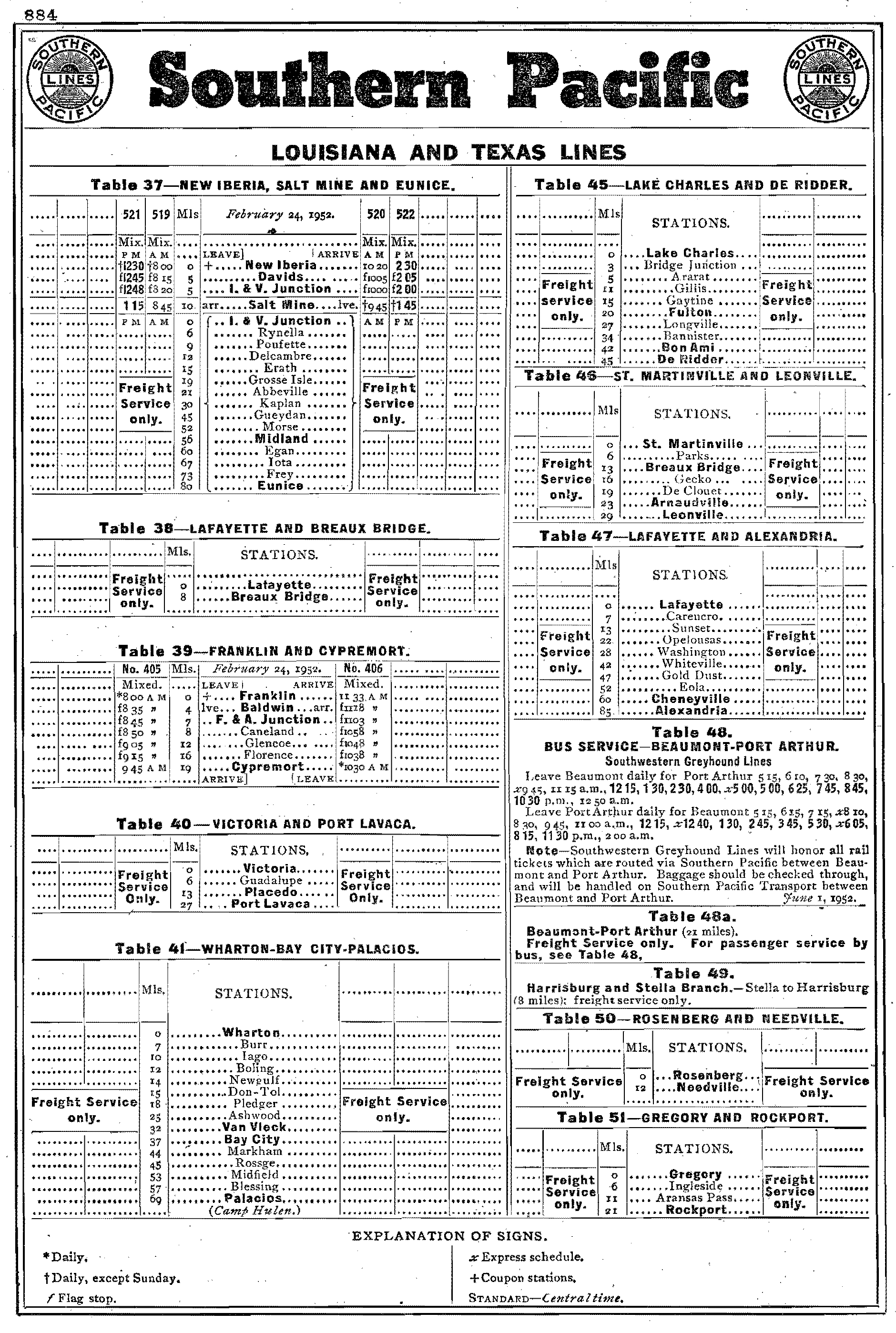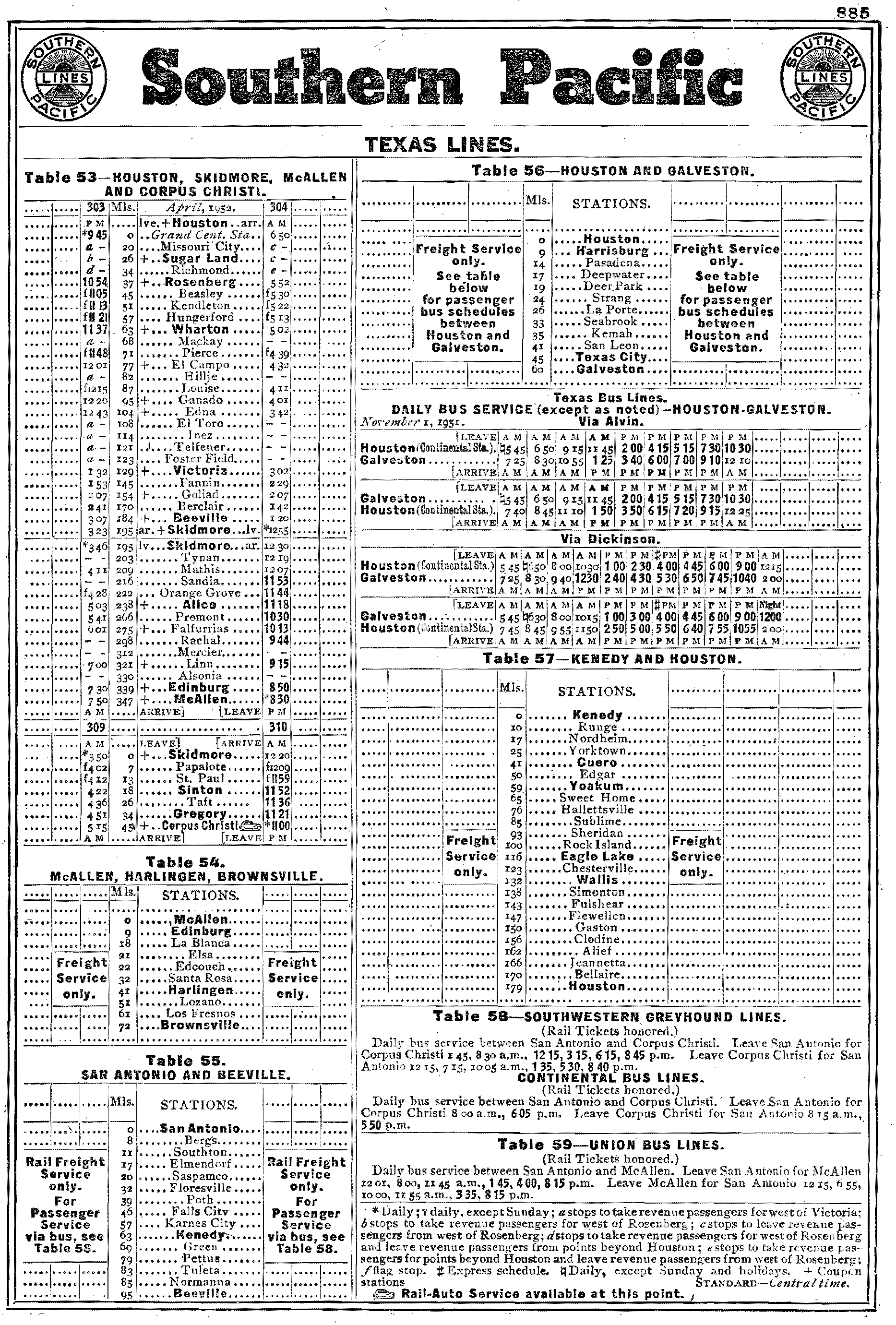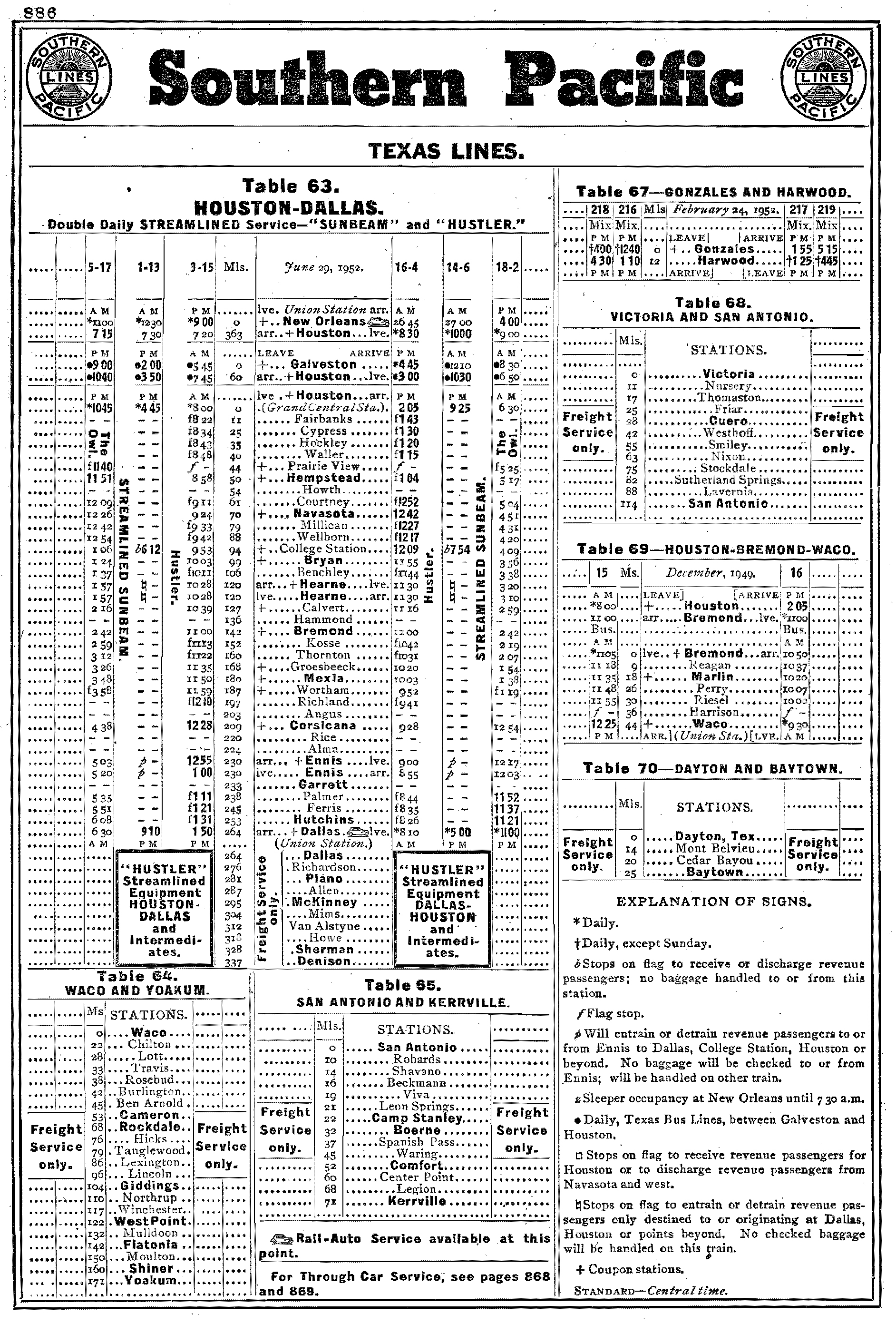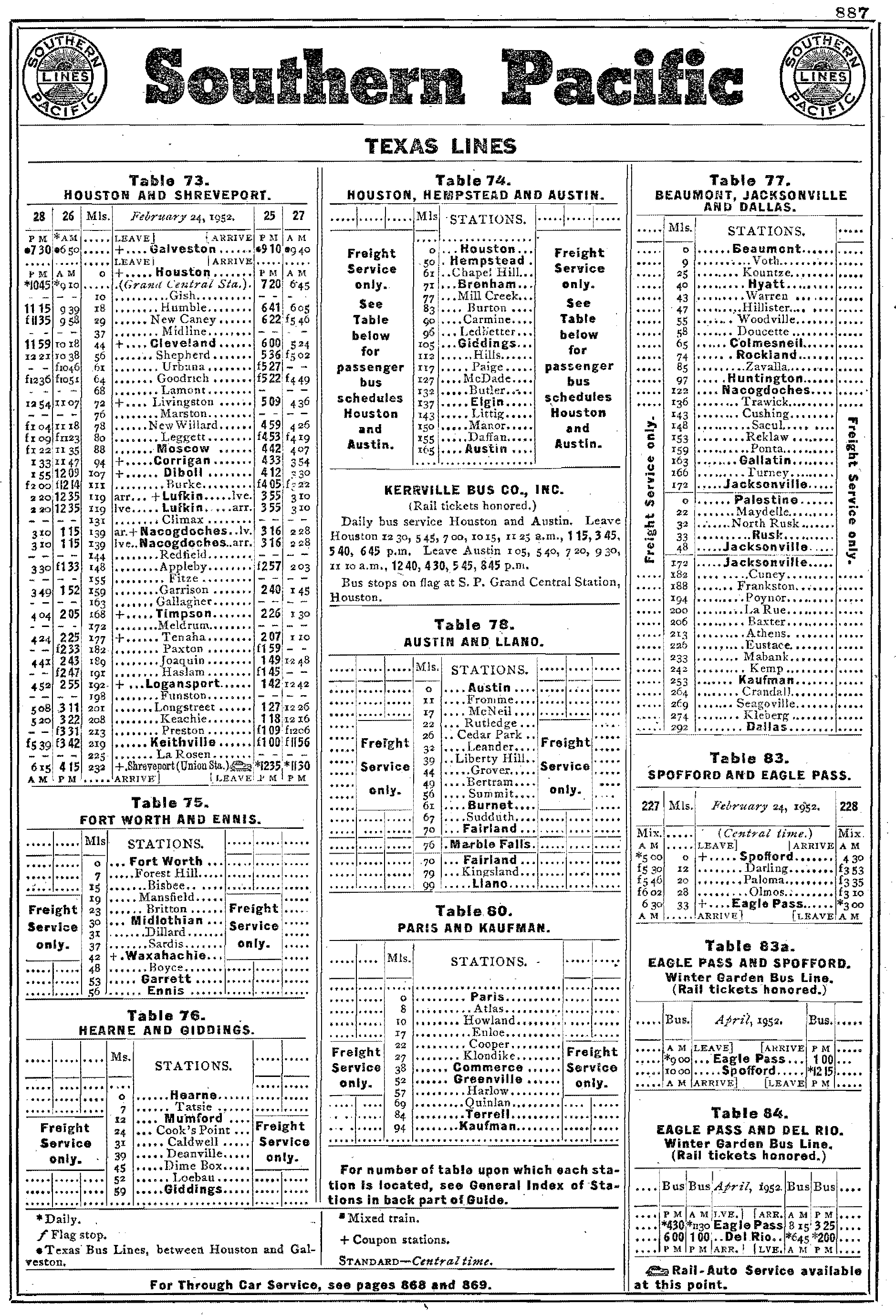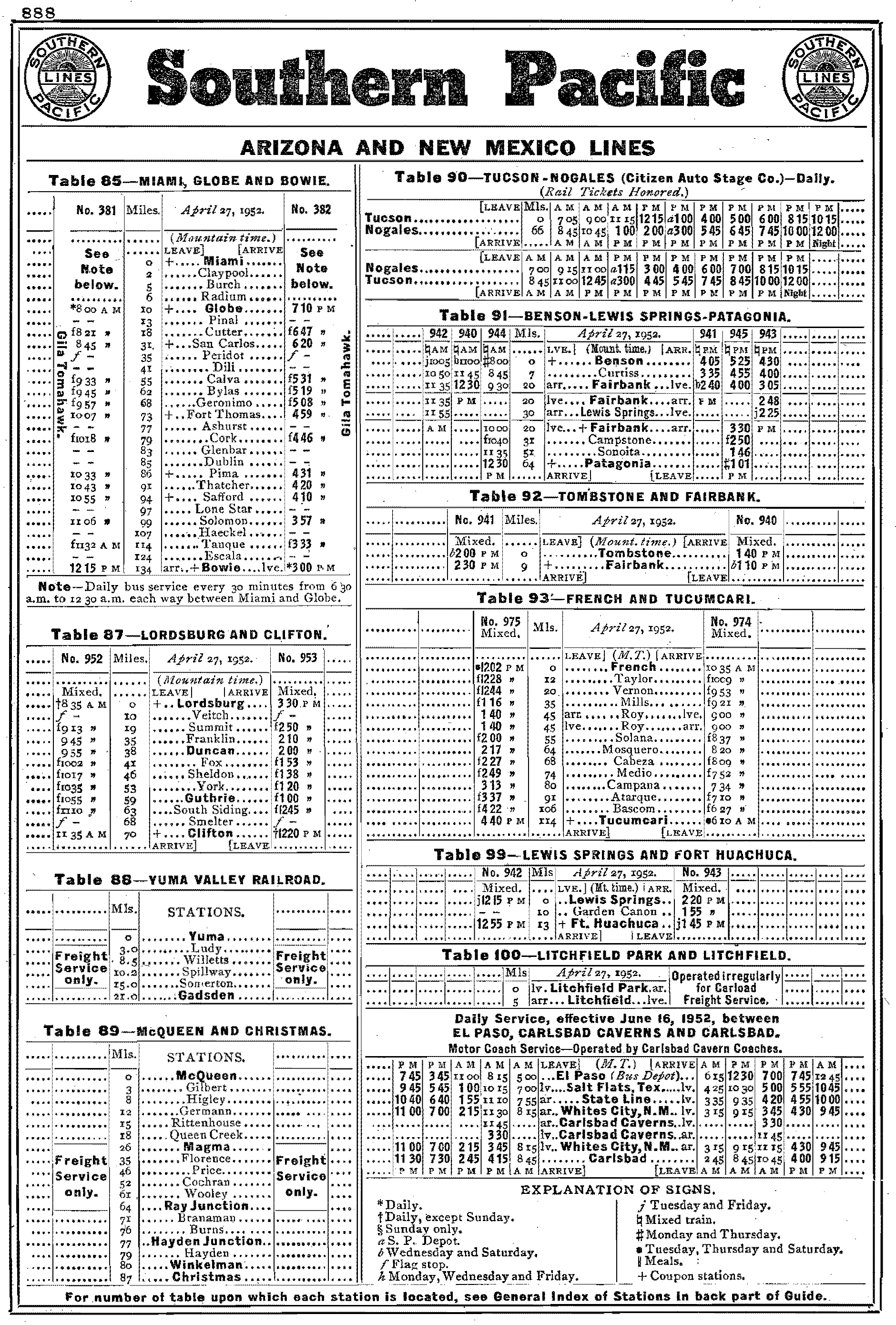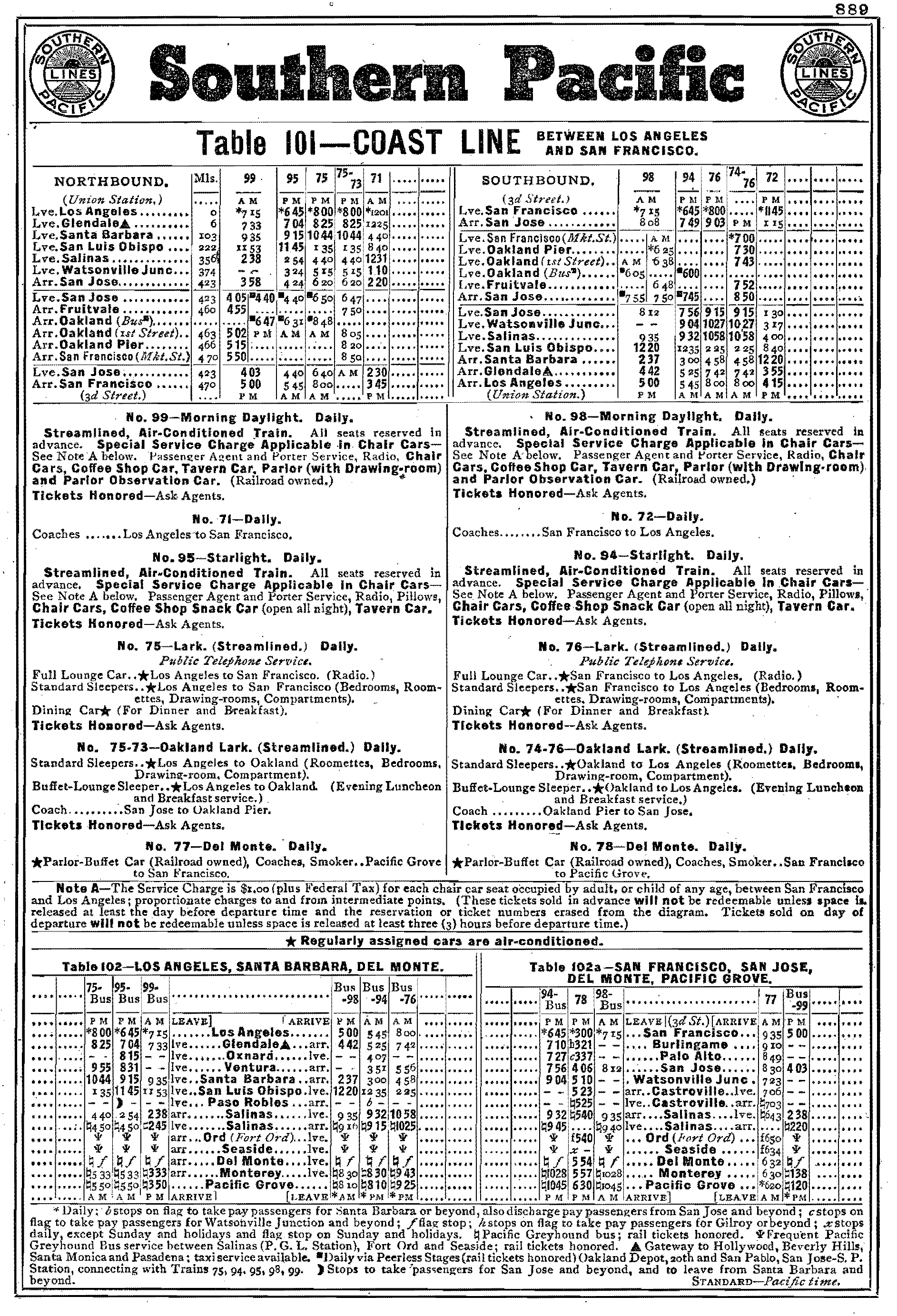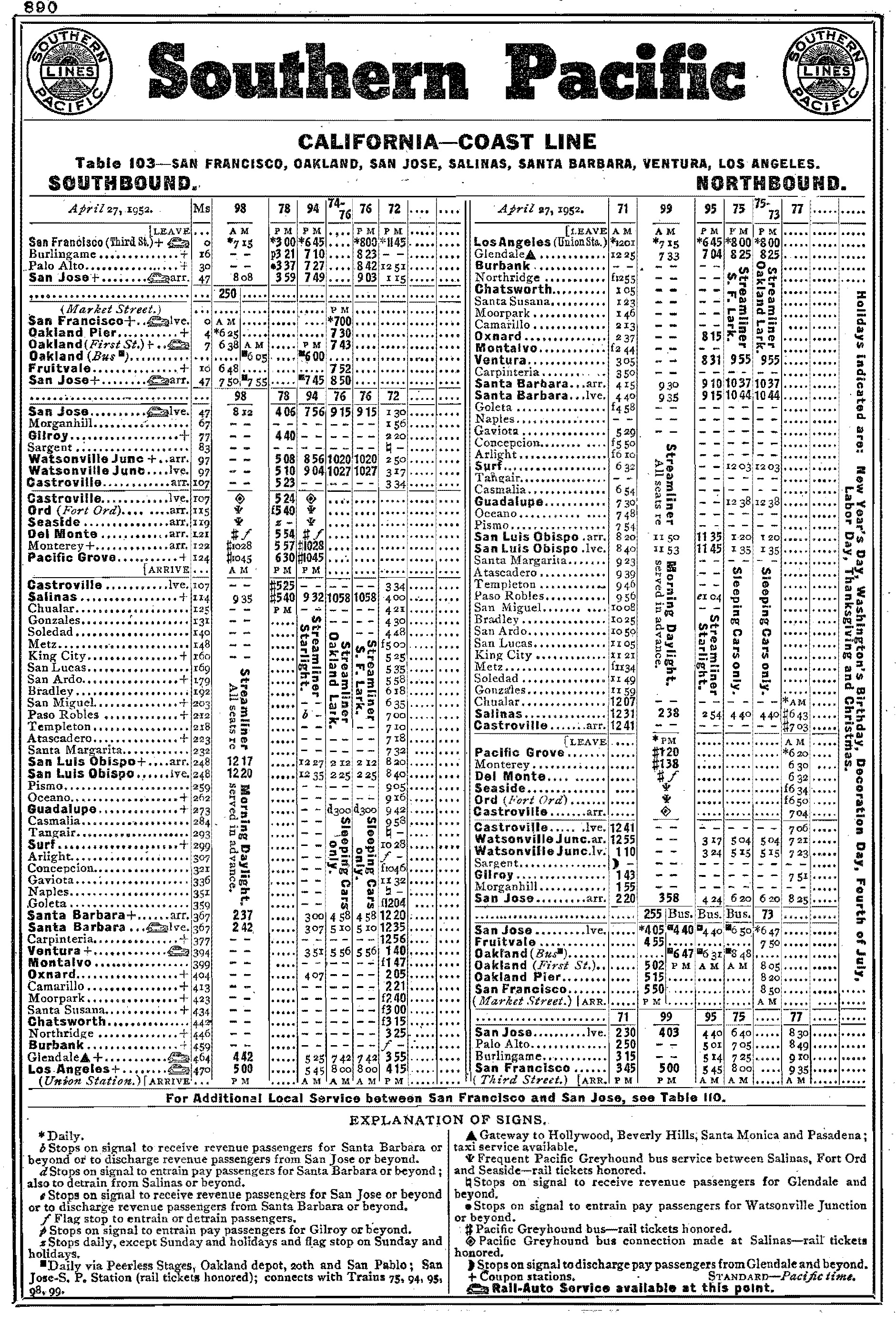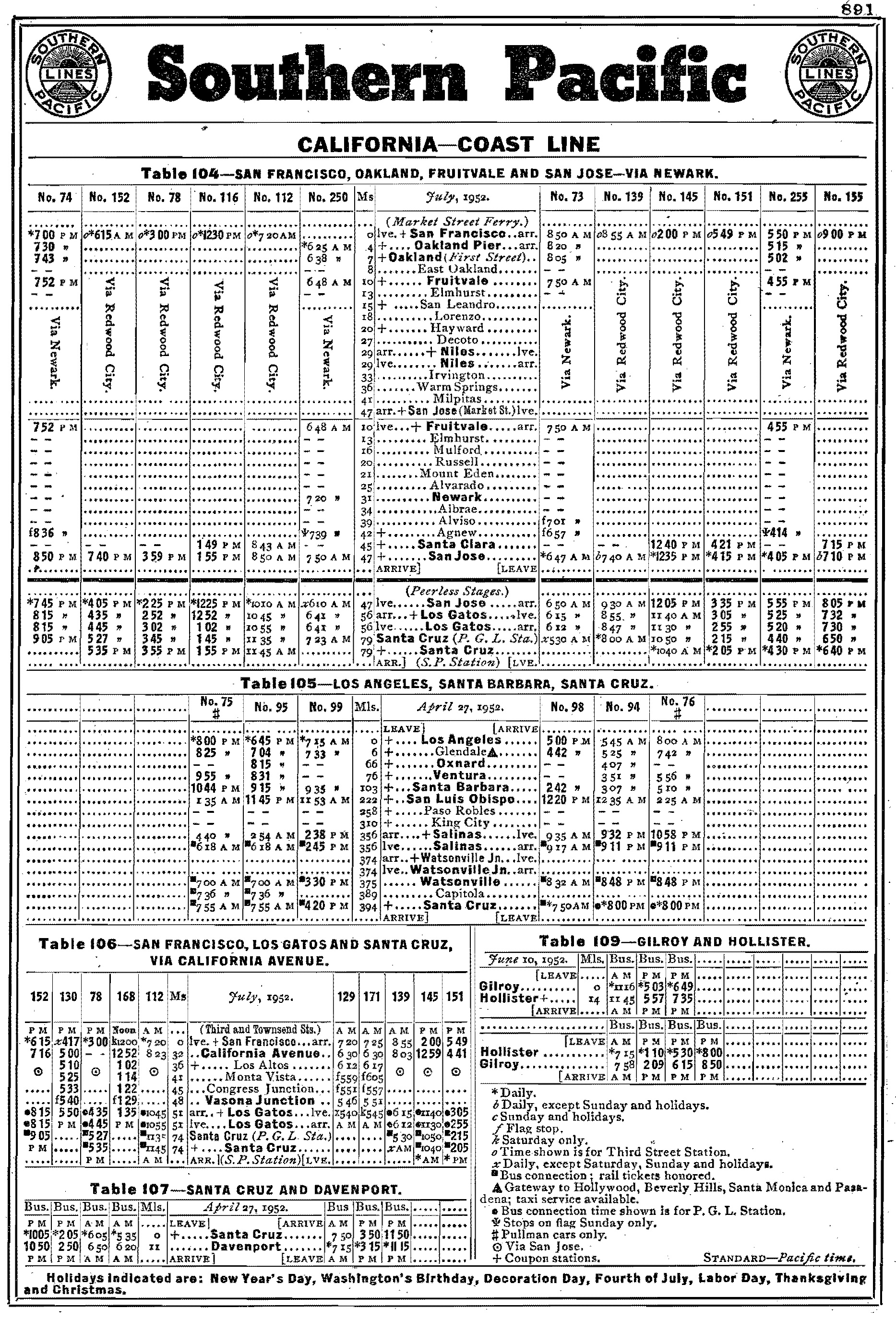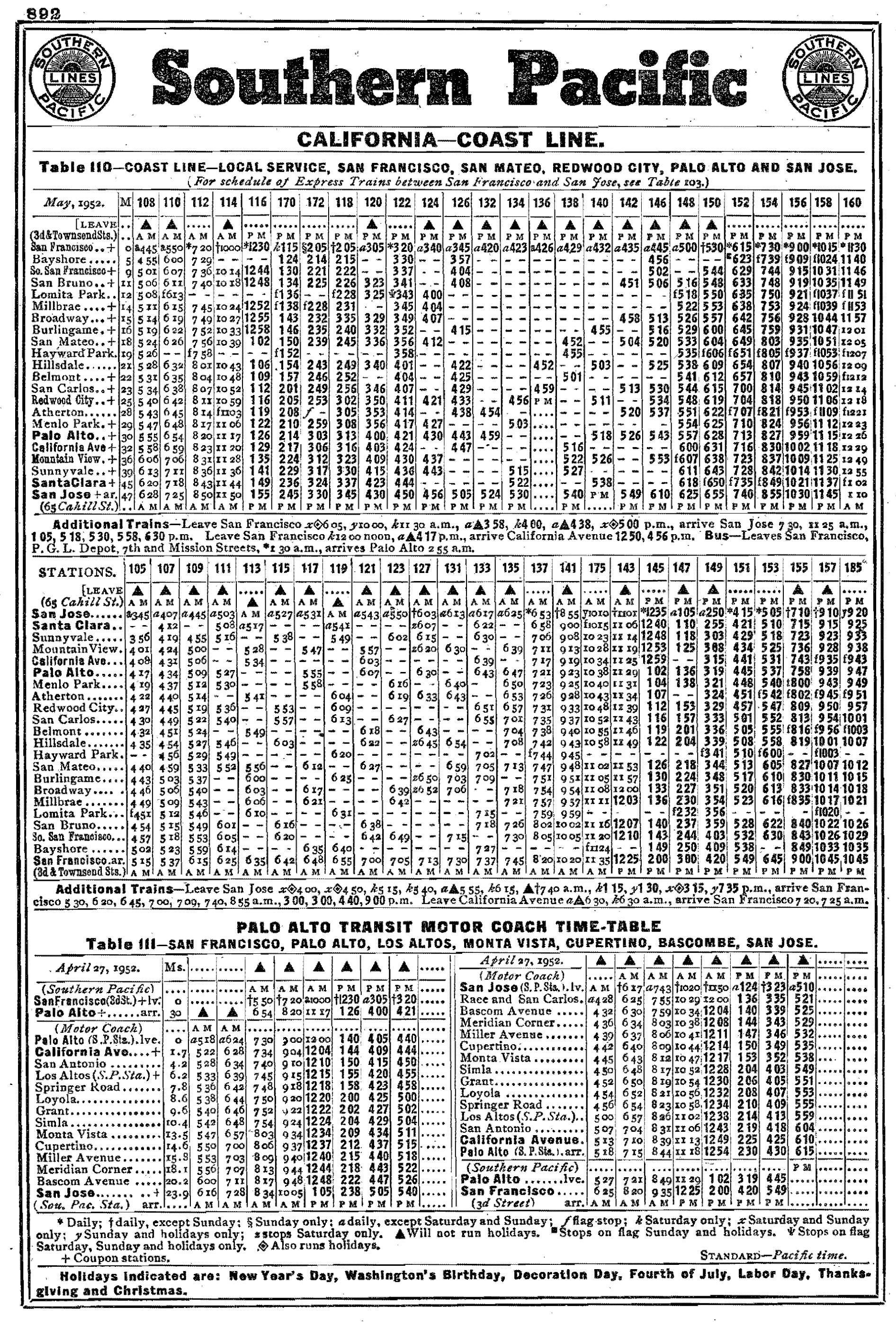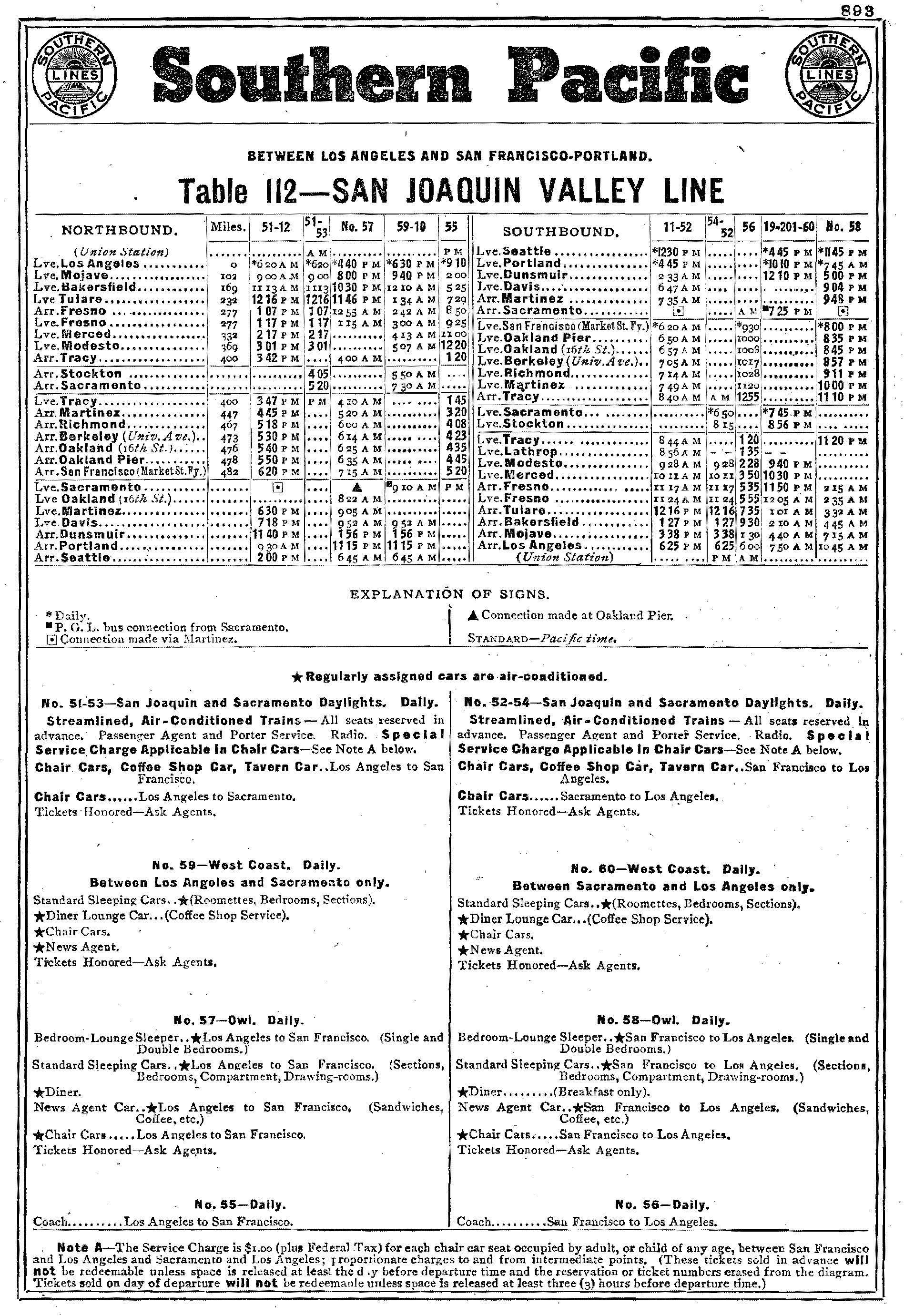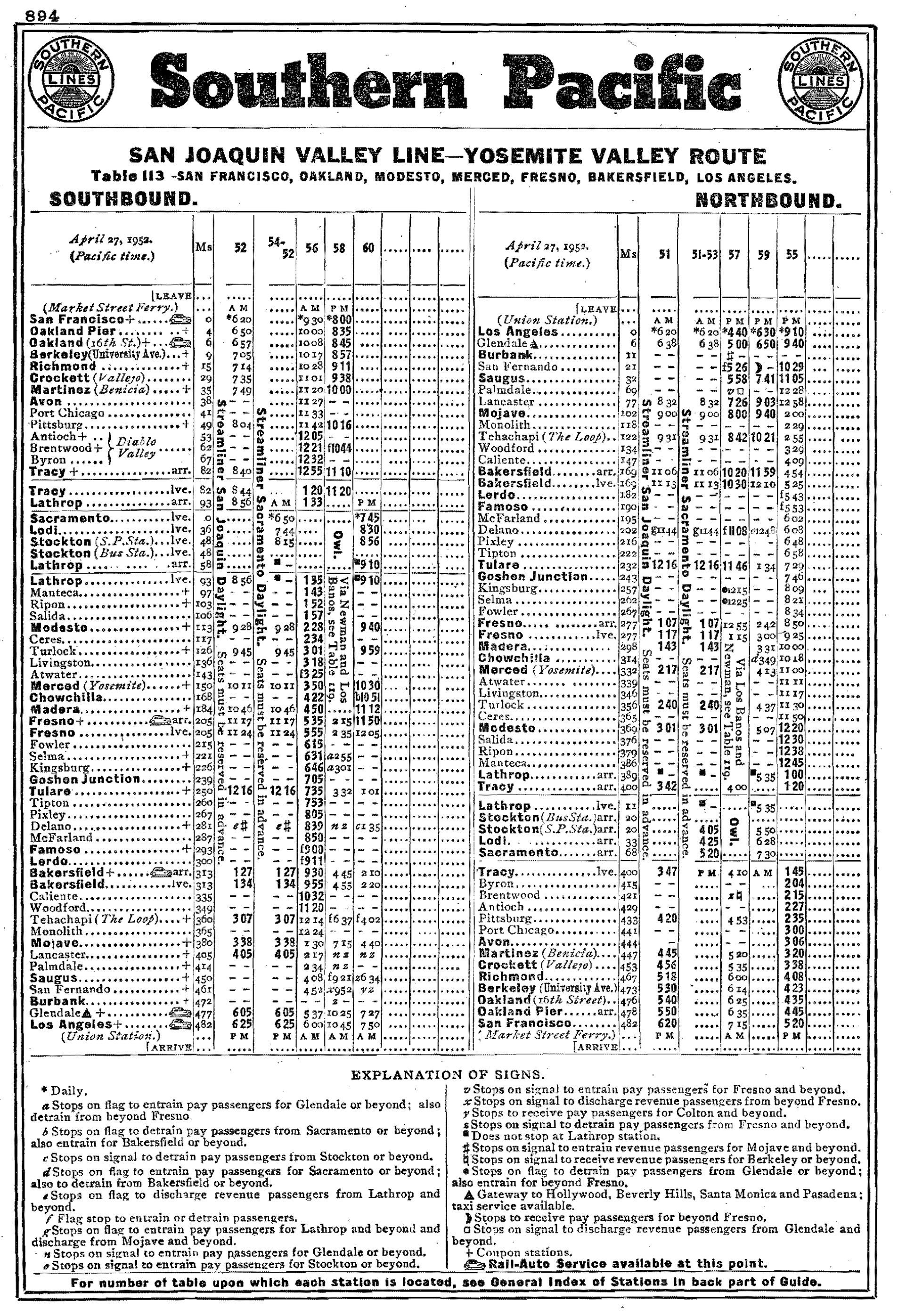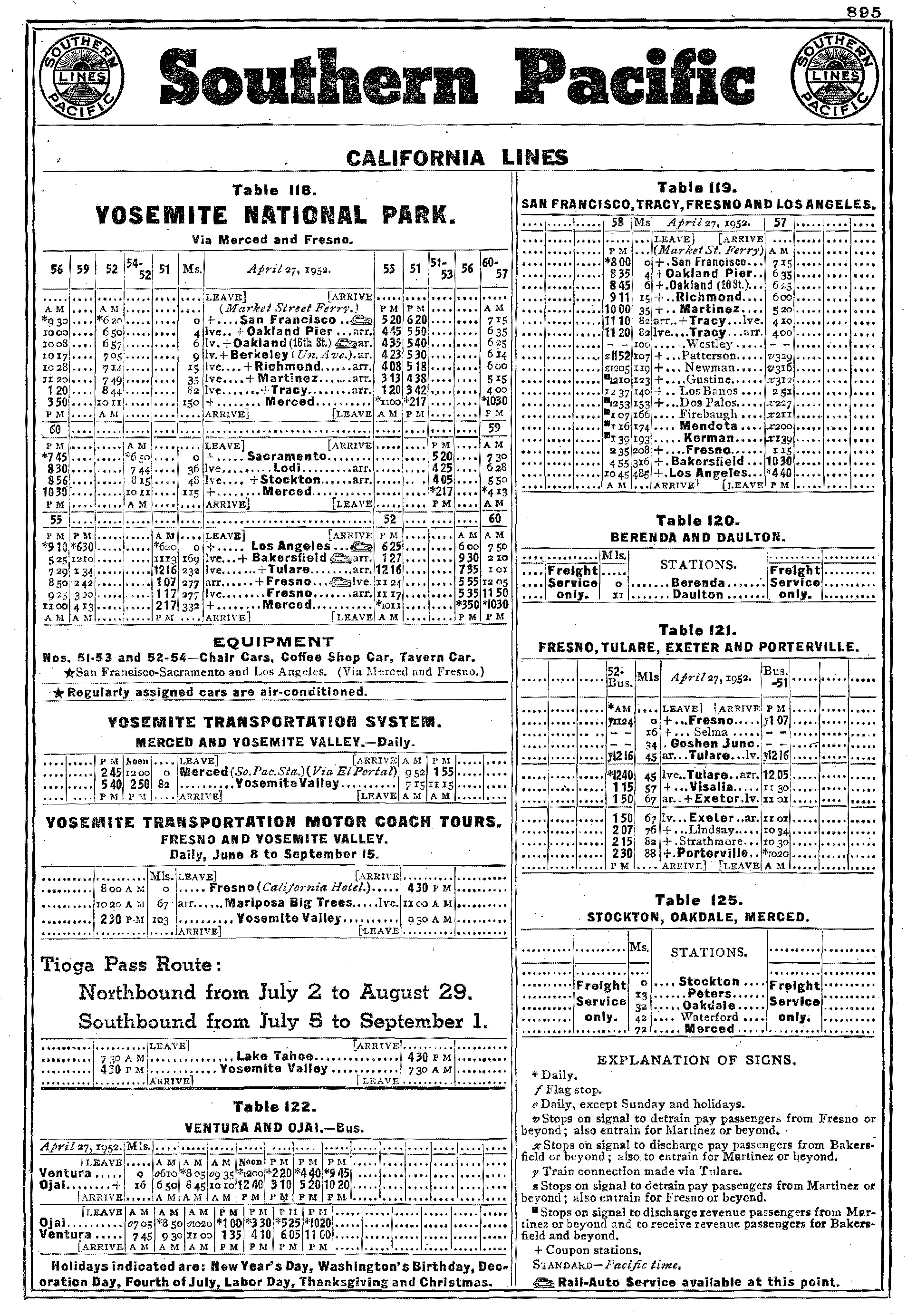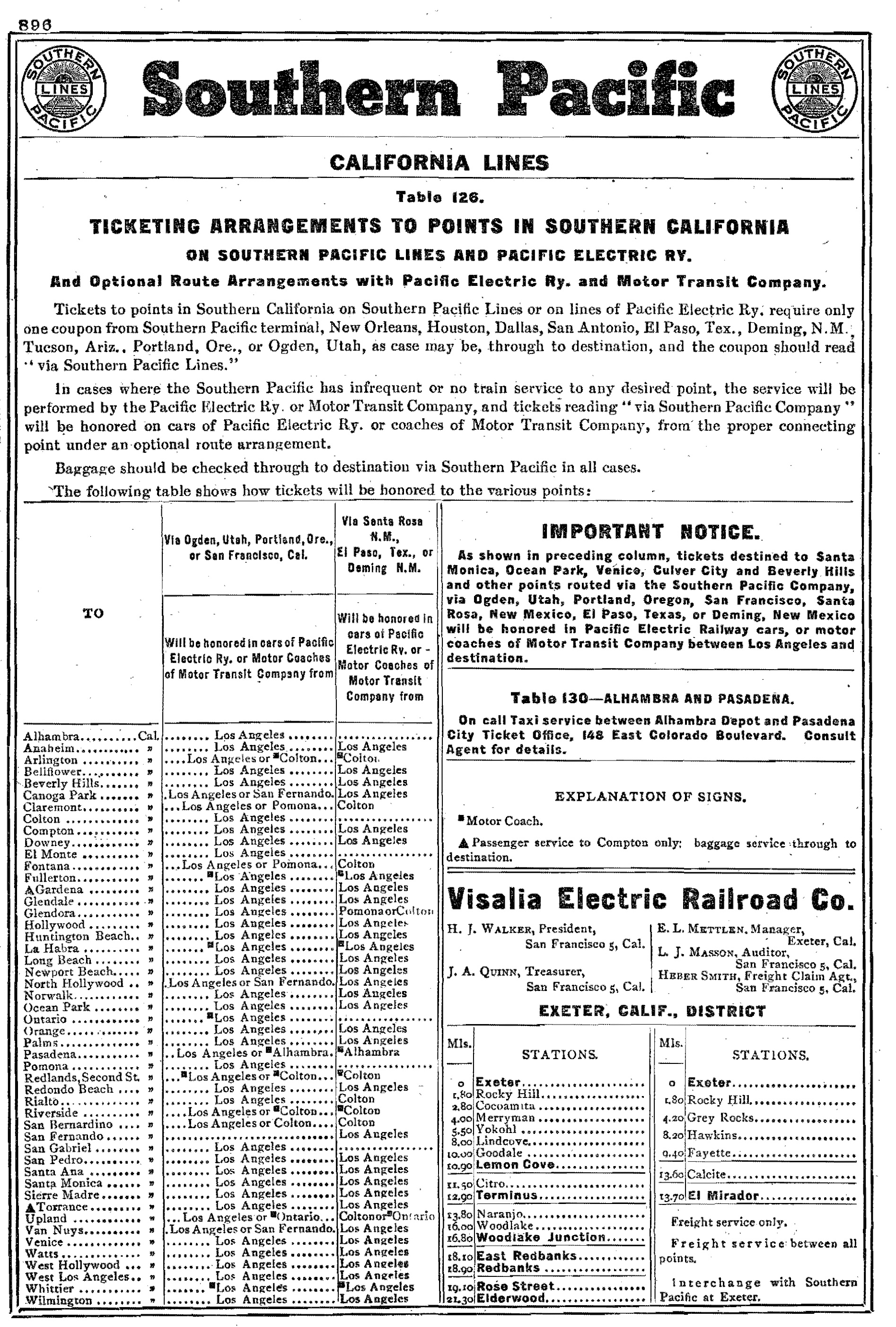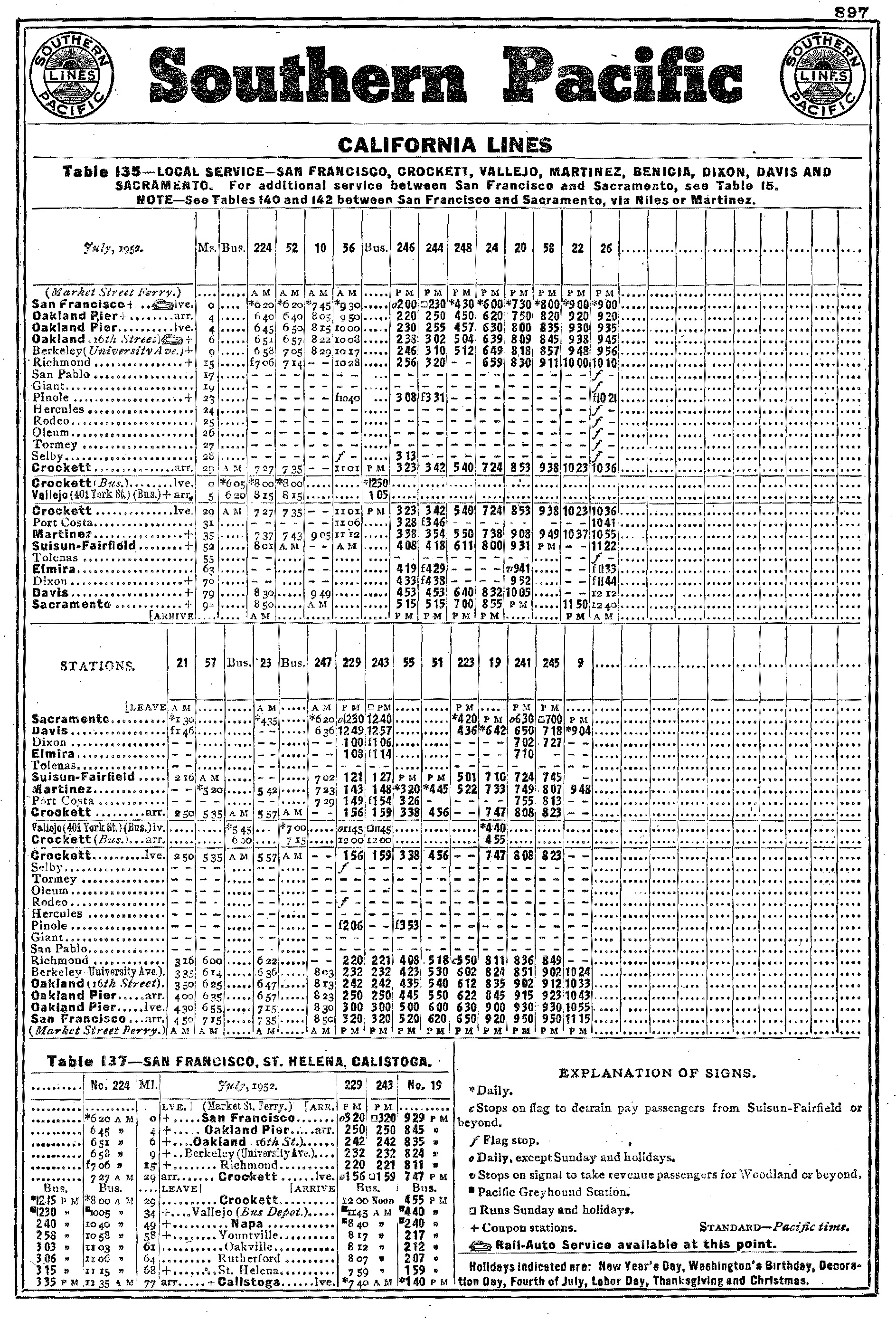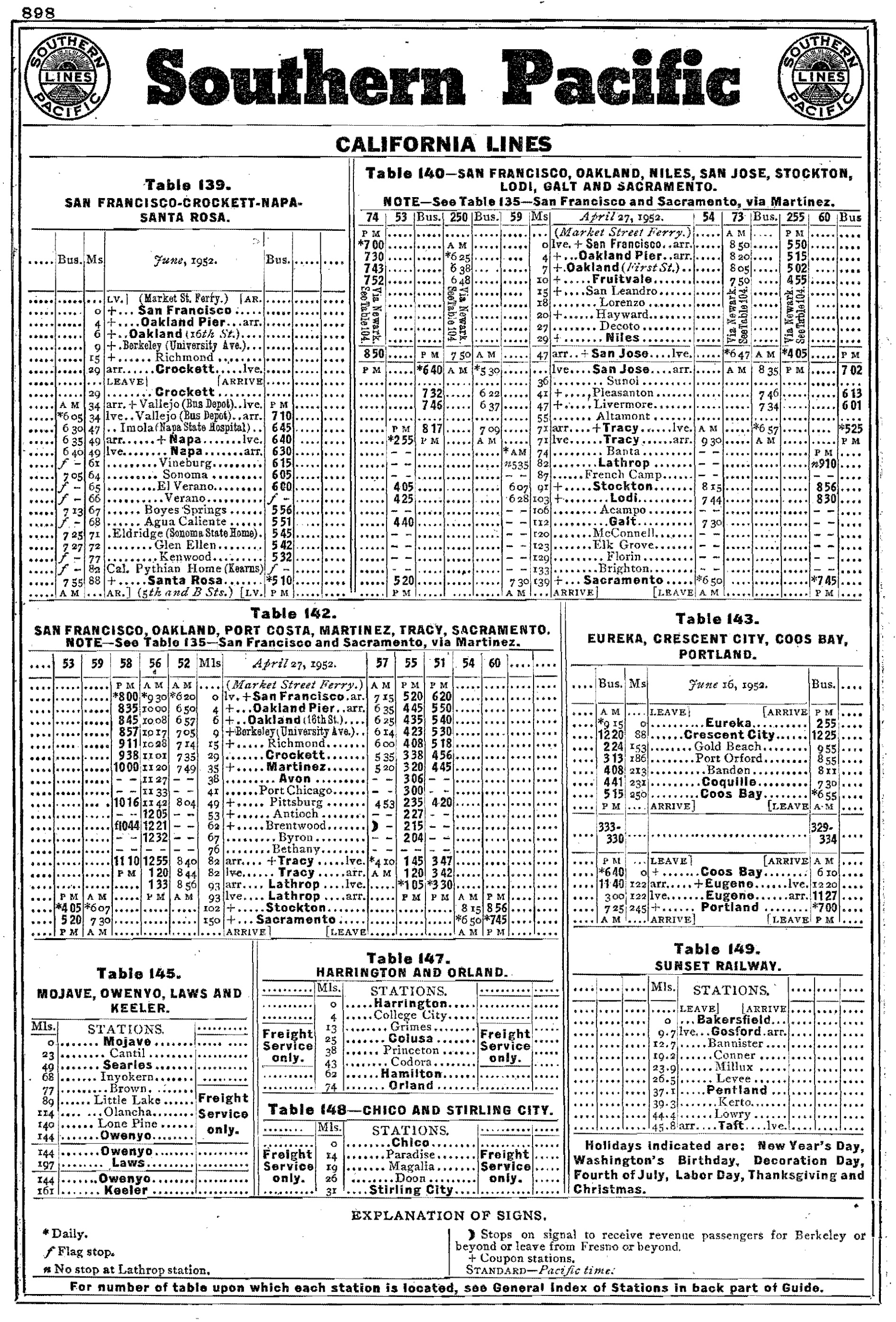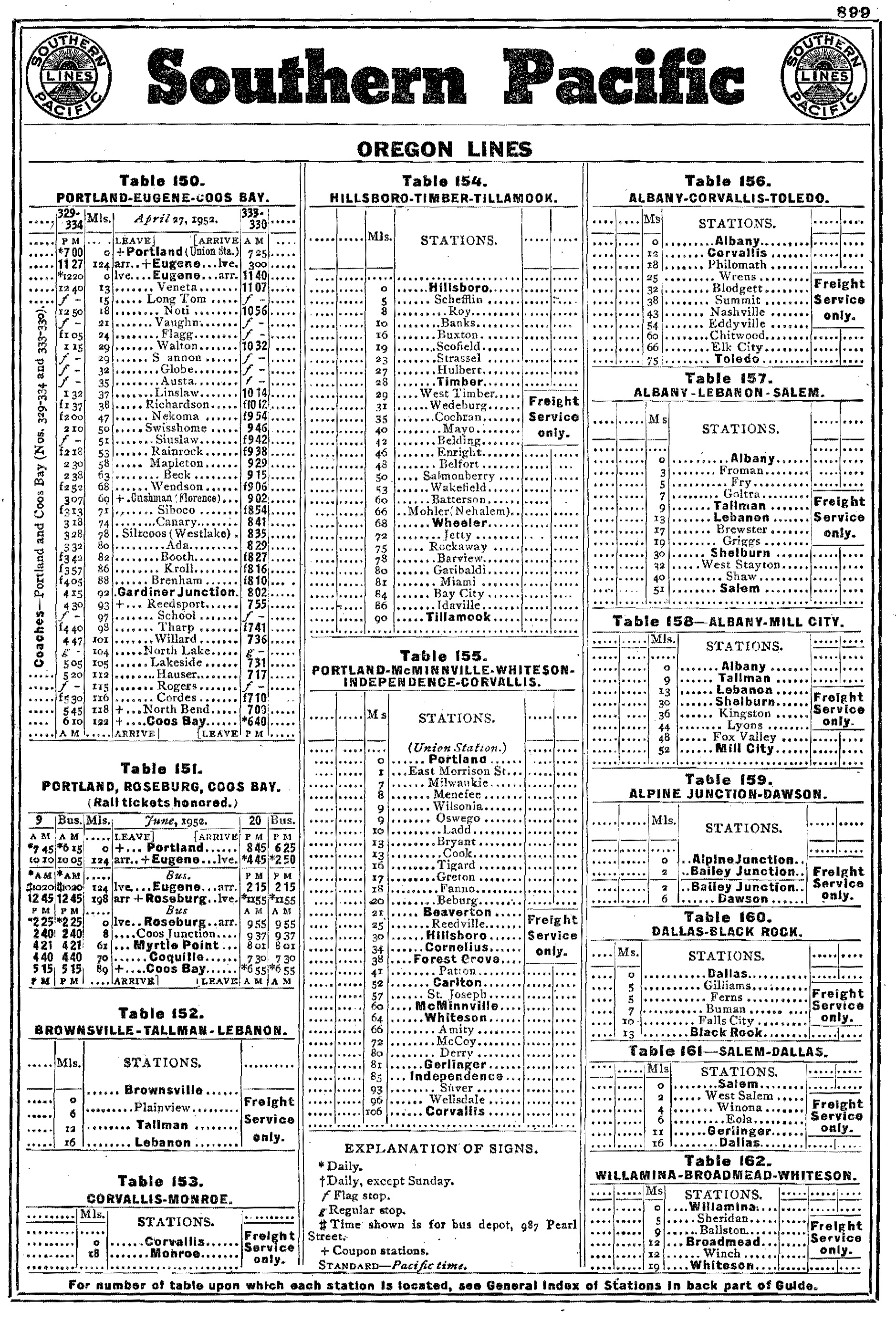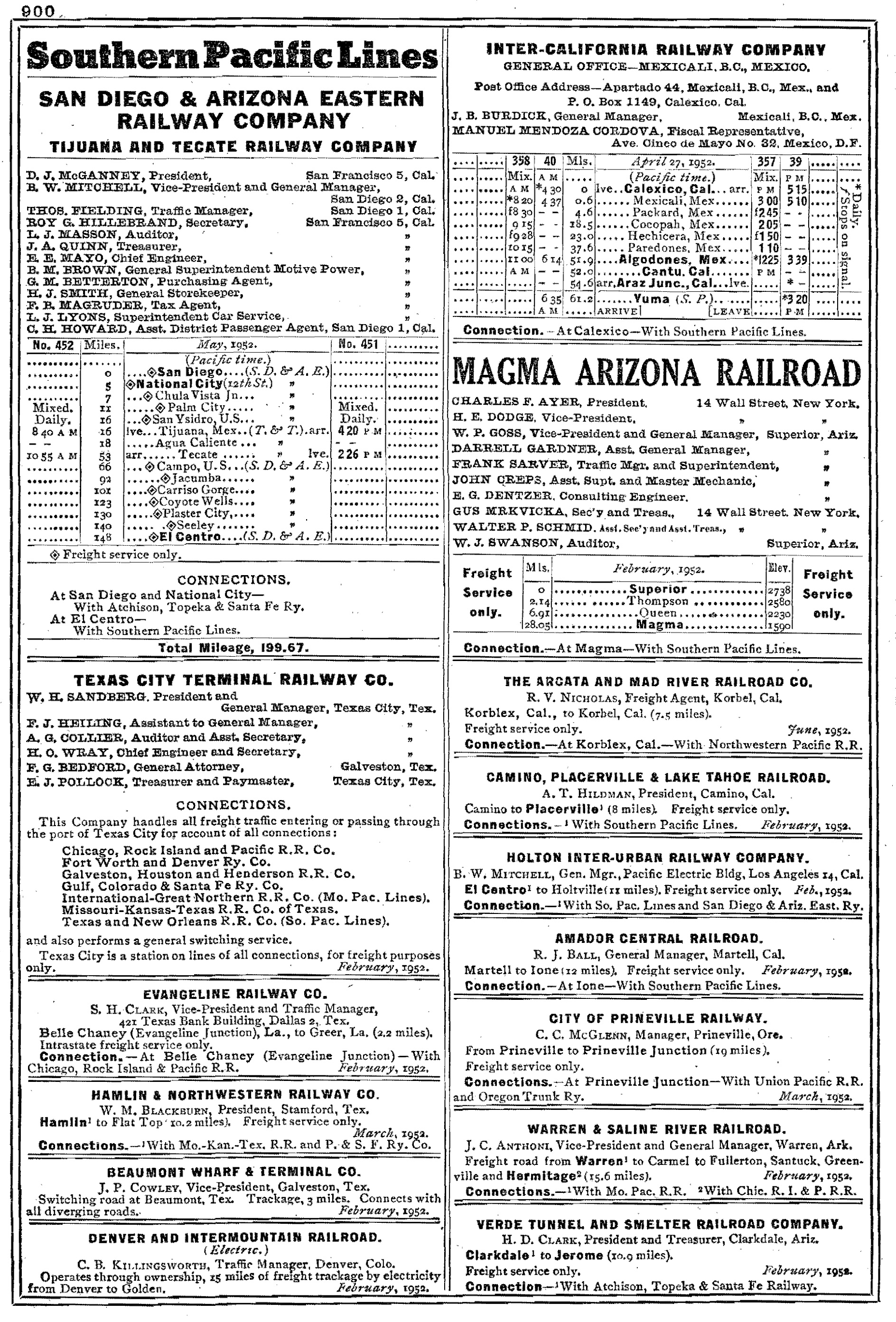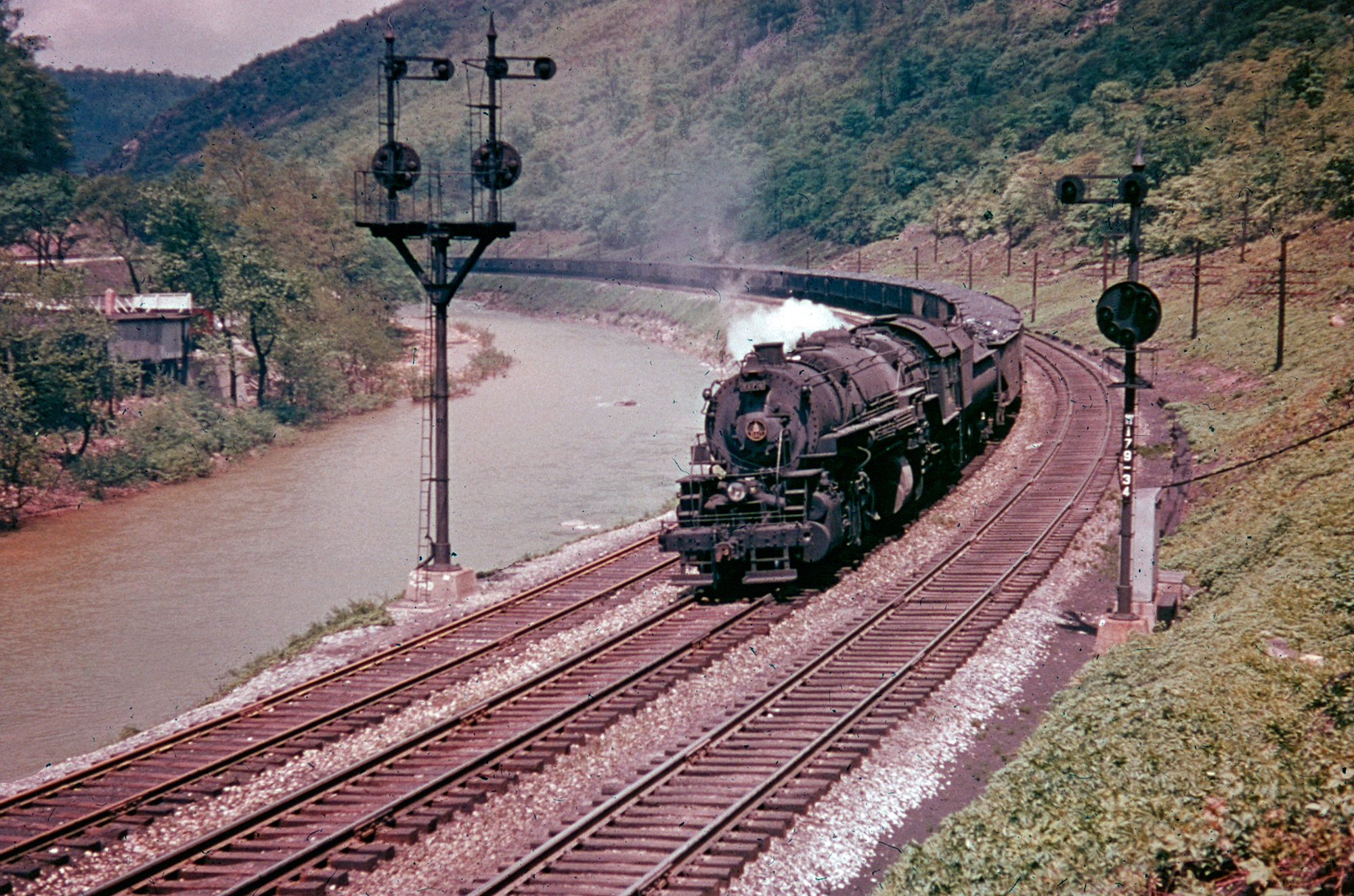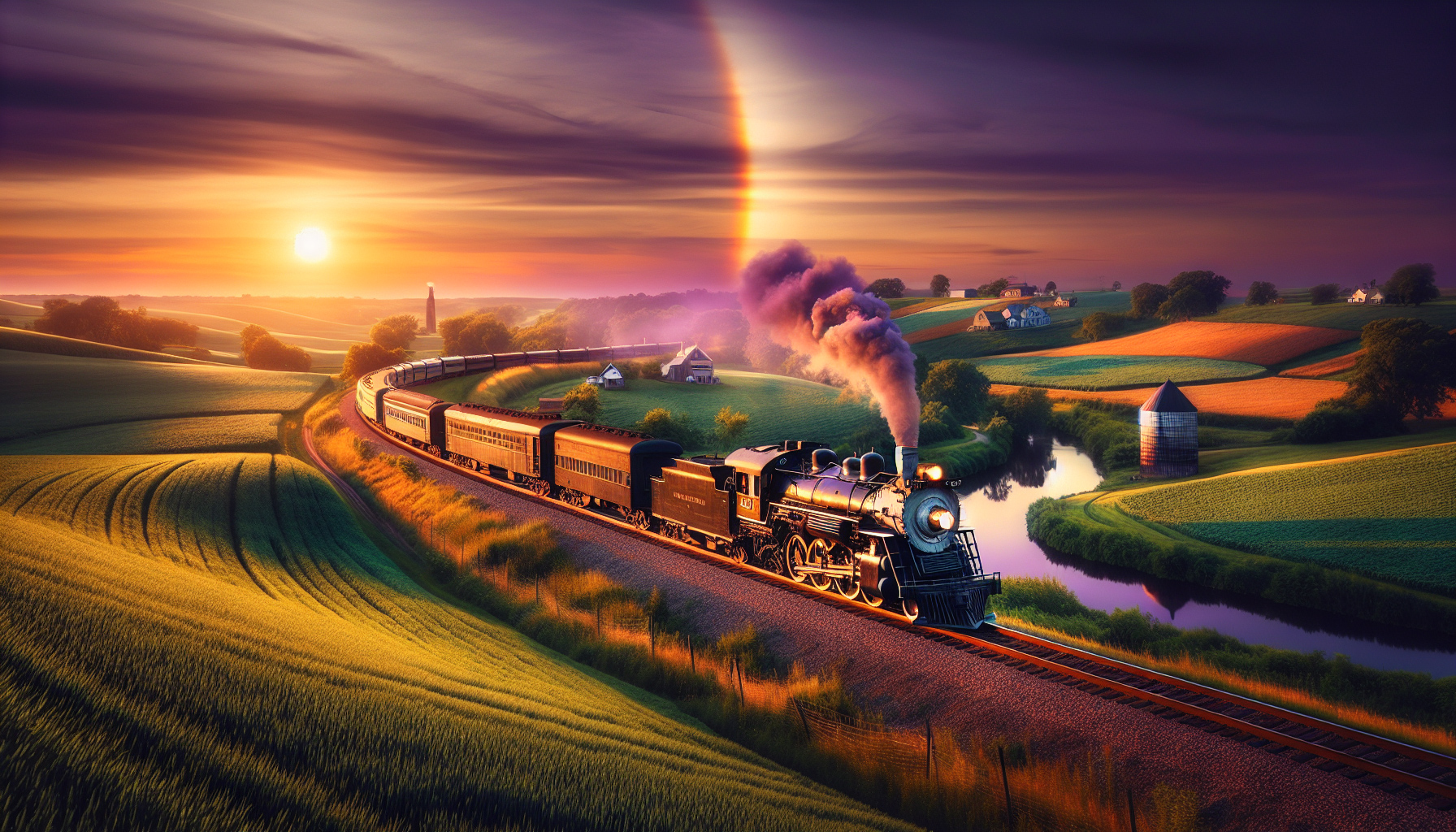Southern Pacific Railroad: Map, History, Logo
Last revised: October 16, 2024
By: Adam Burns
The Southern Pacific (SP) was one of America's most successful and widely recognized railroads. Its name stands alongside notables like the Santa Fe, Union Pacific, Pennsylvania, Baltimore & Ohio, and Illinois Central.
The "Espee" carries a heritage tied to one of the most important events in American history, completion of the Transcontinental Railroad.
Afterwards, Central Pacific's so-called "Big Four" (Collis P. Huntington, Leland Stanford, Charles Crocker, and Mark Hopkins) jockeyed for total control of California's transportation network.
To do so, they created the Southern Pacific and rapidly expanded their new enterprise throughout the Golden State.
Their system eventually became so large it stretched from Portland, Oregon to New Orleans, Louisiana. In addition, a multitude of celebrated subsidiaries comprised SP's network like the Texas & New Orleans, Cotton Belt, and the great Pacific Electric Railway.
Photos
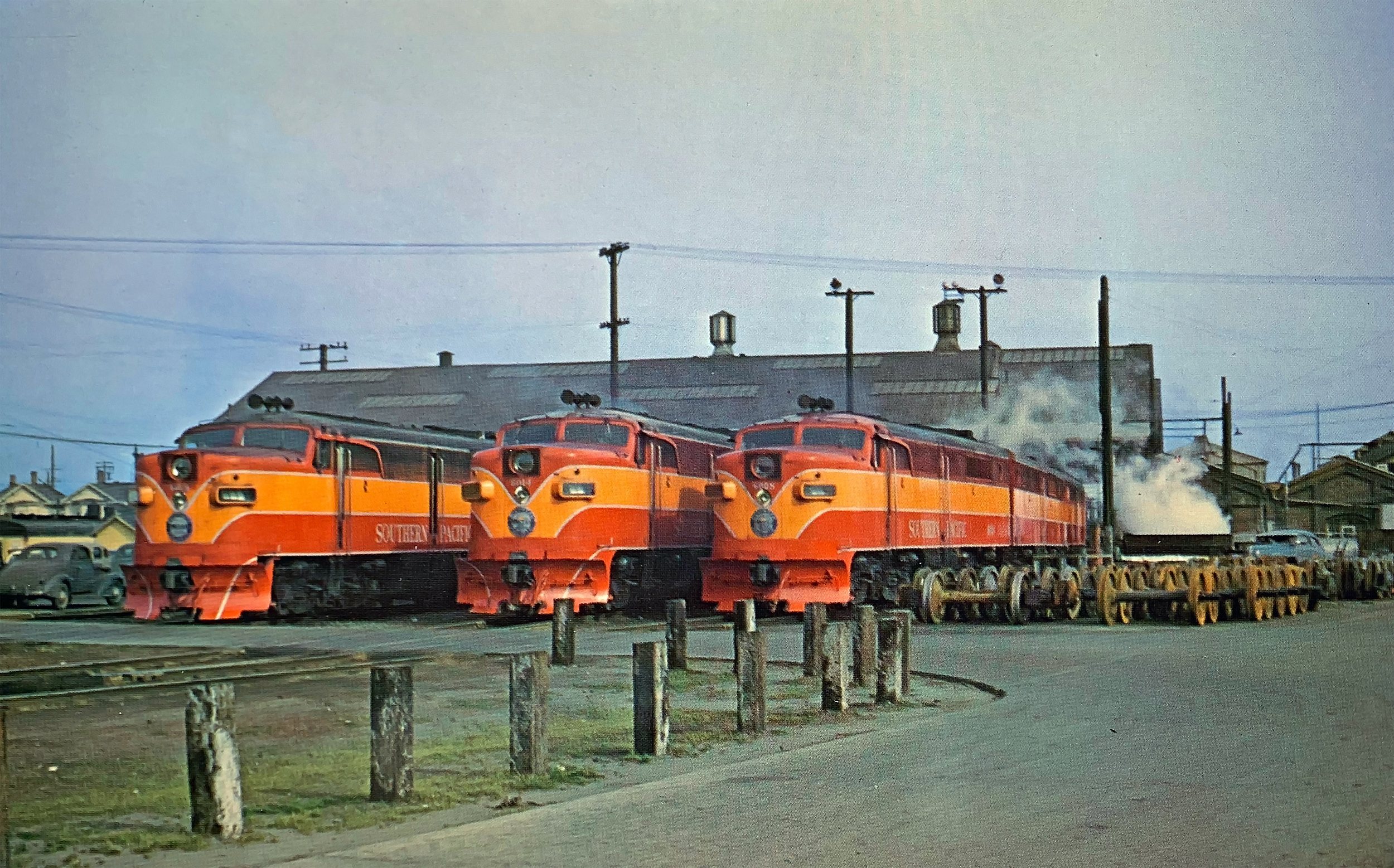 From left to right: Southern Pacific PA-2 #6019, PA-2 #6014, and PA-1 #6008 await their next assignments at the West Oakland Shops in 1952. Stewart Liebman photo. American-Rails.com collection.
From left to right: Southern Pacific PA-2 #6019, PA-2 #6014, and PA-1 #6008 await their next assignments at the West Oakland Shops in 1952. Stewart Liebman photo. American-Rails.com collection.History
Over time, it blossomed into the most far-reaching of all the classic American railroads with a network totaling 17,000 miles after its 1988 merger with the Denver & Rio Grande Western.
Alas, poor management in the decades following World War II greatly weakened this proud carrier as neglect and failed mergers saw its acquisition by Union Pacific in 1996. Today, given Southern Pacific's impressive size and scope most of its principal lines remain in regular service.
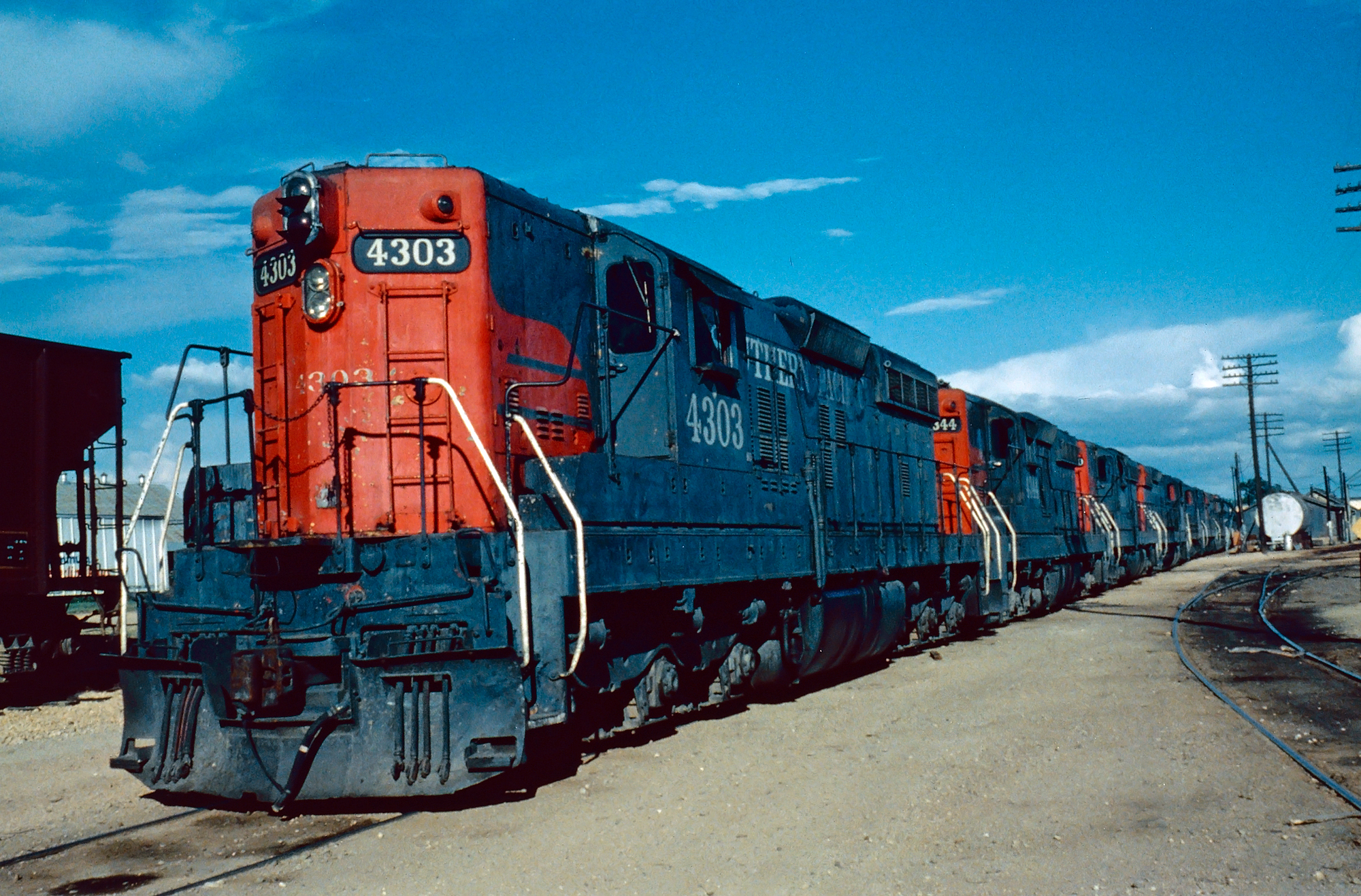 Southern Pacific rebuilt SD9E Cadillacs at Austin, Texas, circa 1982. Mike Bledsoe photo. American-Rails.com
collection.
Southern Pacific rebuilt SD9E Cadillacs at Austin, Texas, circa 1982. Mike Bledsoe photo. American-Rails.com
collection.Central Pacific
The vaunted Southern Pacific name carries a complex history although its immediate heritage can be traced back to the Transcontinental Railroad's completion.
When the Central Pacific (CP) and Union Pacific met on May 10, 1869 at Promontory Summit, Utah the West was opened to new means of economic development and settlement, enabling travelers to take cross-country trips in mere days instead of months.
Following this milestone, CP's "Big Four" maneuvered to dominate Californian trade. Their first task involved opening service beyond Sacramento, directly into Oakland/San Francisco.
Logo
Formation
According to a 1933 piece released by the Southern Pacific Historical & Technical Society entitled, "Historical Outline, Southern Pacific Company, March 1933," the original Southern Pacific Railroad had no ties to either the modern company or the "Big Four."
That corporation's chartering took place on December 2, 1865 and, as Bill Yenne's book, "The History Of The Southern Pacific," notes it was given Congressional authority on July 27, 1866 to establish another transcontinental route from San Francisco to the Colorado River at California's southeastern border. There, it would meet the Atlantic & Pacific Railway building east from St. Louis.
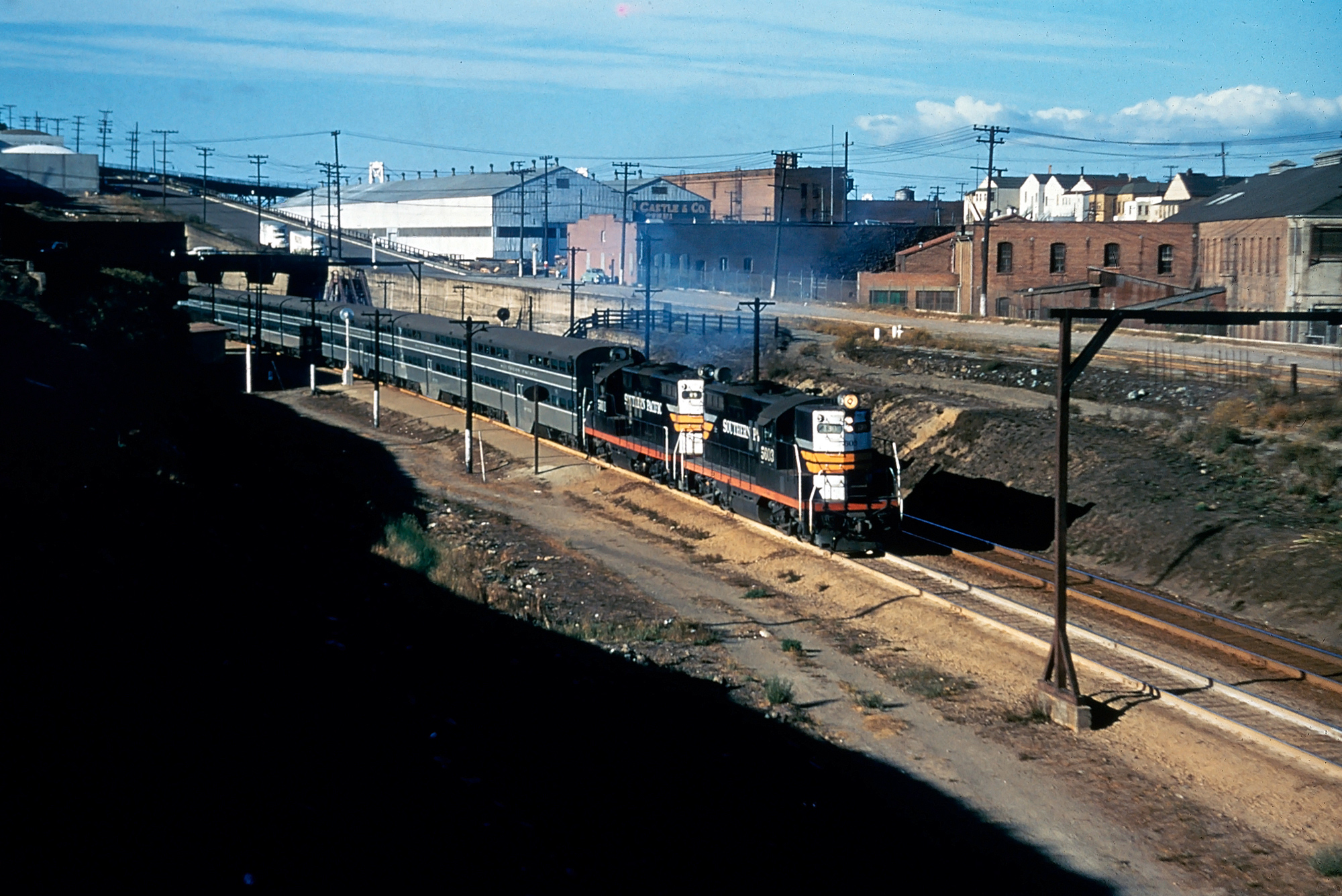 Southern Pacific GP9's #5603 and #5611 lead commuter train #130 (San Francisco - Los Gatos) out of San Francisco, circa 1955. Gordon Glattenberg photo. American-Rails.com collection.
Southern Pacific GP9's #5603 and #5611 lead commuter train #130 (San Francisco - Los Gatos) out of San Francisco, circa 1955. Gordon Glattenberg photo. American-Rails.com collection.While the project did include some new construction it was greatly aided by the February 4, 1868 acquisition of the San Francisco & San Jose Railroad, which linked its namesake towns.
For a brief time it appeared the "Big Four" might actually have to share the state's transportation services with this independent railroad.
Such an unthinkable scenario proved short-lived, though, when they purchased the original Southern Pacific on September 29, 1869. In a complicated series of corporate shakeups the SP combined operations with CP in 1870 (the former did not officially lease the latter until April 1, 1885).
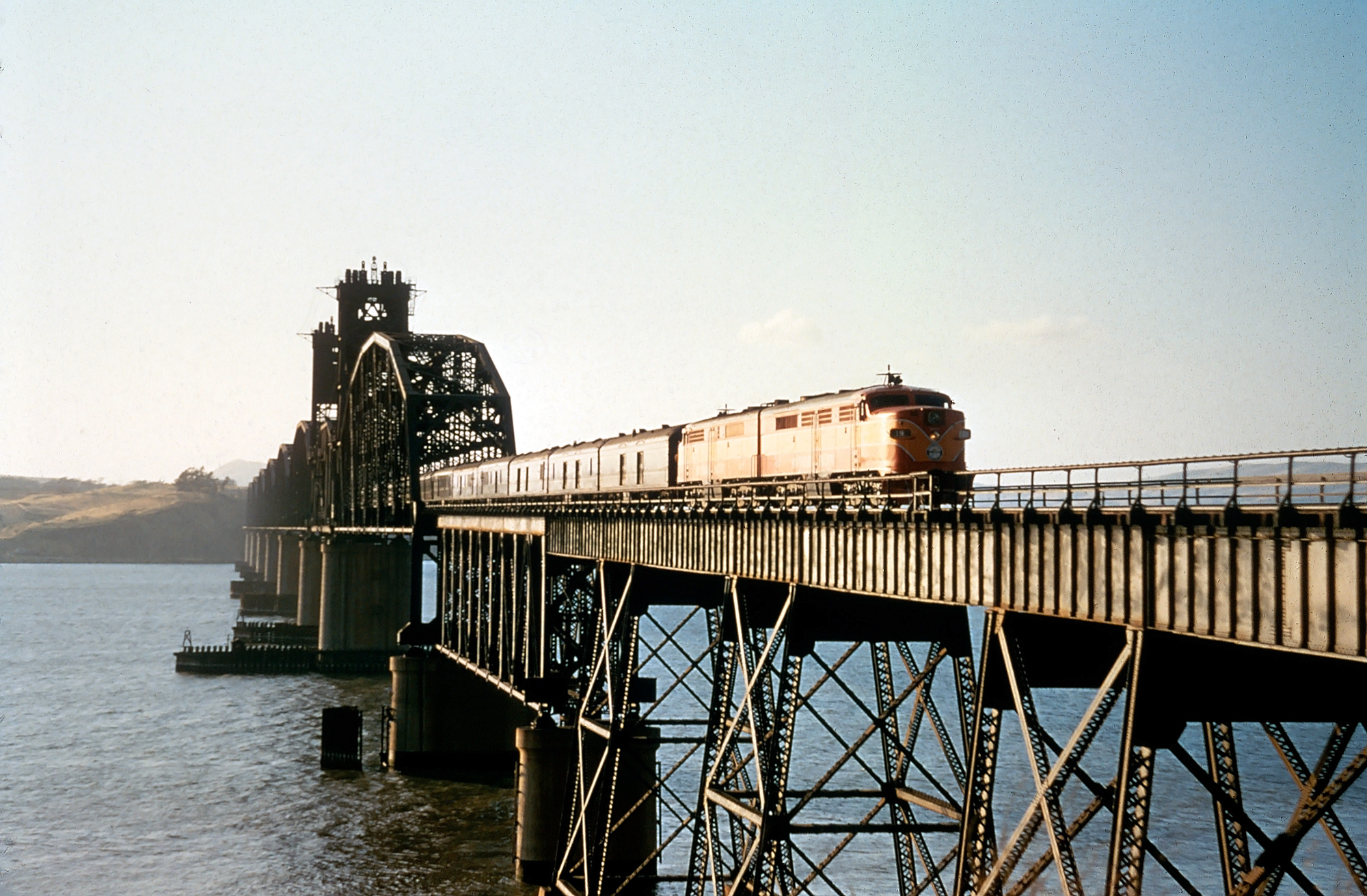 A pair of handsome Southern Pacific PA-2's lead train #19, the southbound "Klamath" (Portland - San Francisco), over the big lift bridge spanning the Carquinez Strait near Martinez, California, circa 1953. Gordon Glattenberg photo. American-Rails.com collection.
A pair of handsome Southern Pacific PA-2's lead train #19, the southbound "Klamath" (Portland - San Francisco), over the big lift bridge spanning the Carquinez Strait near Martinez, California, circa 1953. Gordon Glattenberg photo. American-Rails.com collection.On November 11, 1869 the "Big Four" completed an extension from Sacramento to the San Francisco Bay at Oakland through two subsidiaries known as the Western Pacific Railroad (no relation to the well-known WP built decades later) and San Francisco Bay Railroad.
According to Brian Solomon's book, "Southern Pacific Railroad," the group then formed a new Southern Pacific Railroad on October 12, 1870 to obtain the original and others mentioned (including CP).
A further corporate layer was added on August 14, 1884 when the Southern Pacific Company was created in Kentucky to manage all properties under the "Big Four's" direction.
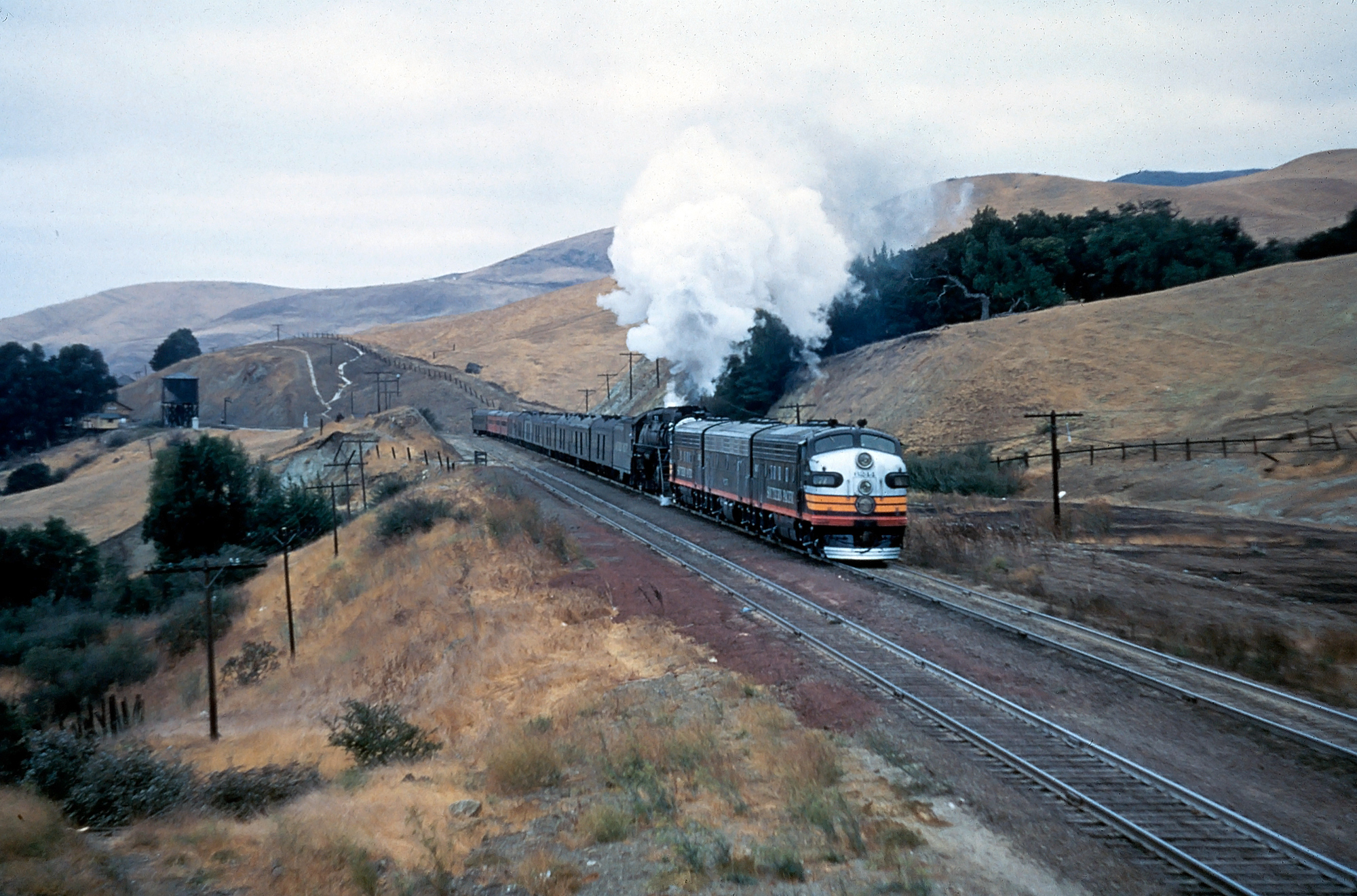 An A-B-A set of Southern Pacific F7's, along with a GS-class 4-8-4, have northbound train #71 at Serrano, California, circa 1955. This largely mail/express run operated the Coast Line between Los Angeles and San Francisco. Gordon Glattenberg photo. American-Rails.com collection.
An A-B-A set of Southern Pacific F7's, along with a GS-class 4-8-4, have northbound train #71 at Serrano, California, circa 1955. This largely mail/express run operated the Coast Line between Los Angeles and San Francisco. Gordon Glattenberg photo. American-Rails.com collection.Expansion
The Southern Pacific began its march out of the Bay Area in March of 1869 when it opened an extension 30 miles south of San Jose to Gilroy.
Beyond, it passed through the San Joaquin Valley reaching Modesto (November, 1870), Fresno (May, 1872), and Bakersfield (November, 1874) before dispatching its first train to Los Angeles (then a town of less than 10,000 residents) on September 5, 1876.
At A Glance
15,039 (1950) 17,340 (1995) |
|
San Francisco - Ogden/Salt Lake City ("Overland Route") San Francisco - San Jose - San Louis Obispo - Los Angeles ("Coast Line") San Francisco - Sacramento - Portland ("Shasta Route") Los Angeles - El Paso - San Antonio - Houston - New Orleans ("Sunset Route") Los Angeles - El Paso - Tucumcari, New Mexico - Chicago ("Golden State Route" via Rock Island) Houston - Dallas/Fort Worth, Dallas/Fort Worth - St. Louis Memphis - Brinkley, Arkansas San Francisco - Fresno - Bakersfield - Los Angeles ("San Joaquin Valley Line") Black Butte, California - Odell Lake, Oregon - Portland ("Cascade Line") Black Butte, California - Ashland, Oregon - Eugene - Portland ("Siskiyou Line") Klamath Falls, Oregon - Fernley, Nevada ("Modoc Line") |
|
Diesel: 2,096 |
|
Freight Cars: 77,401 Passenger Cars: 1,002 |
|
As the work trekked south, surveyors ran into a major problem 32 miles outside of Bakersfield, the Tehachapi Mountains. To tackle this rugged stretch of topography the "Big Four" hired engineer William Hood who designed an impressive route containing eastbound ruling grades (compensated) of only 2.52% while westbound grades (compensated) were an even gentler 1.36%.
The line reached the summit at 4,025 feet although its most endearing feature lay nine miles below where a sweeping loop allowed Hood to keep grades manageable while gaining an additional 77 feet in elevation.
Today, the fabled Tehachapi Loop remains in regular use by both Union Pacific (owner) and BNSF Railway (lessor). After arriving in Los Angeles, the SP expanded in all directions.
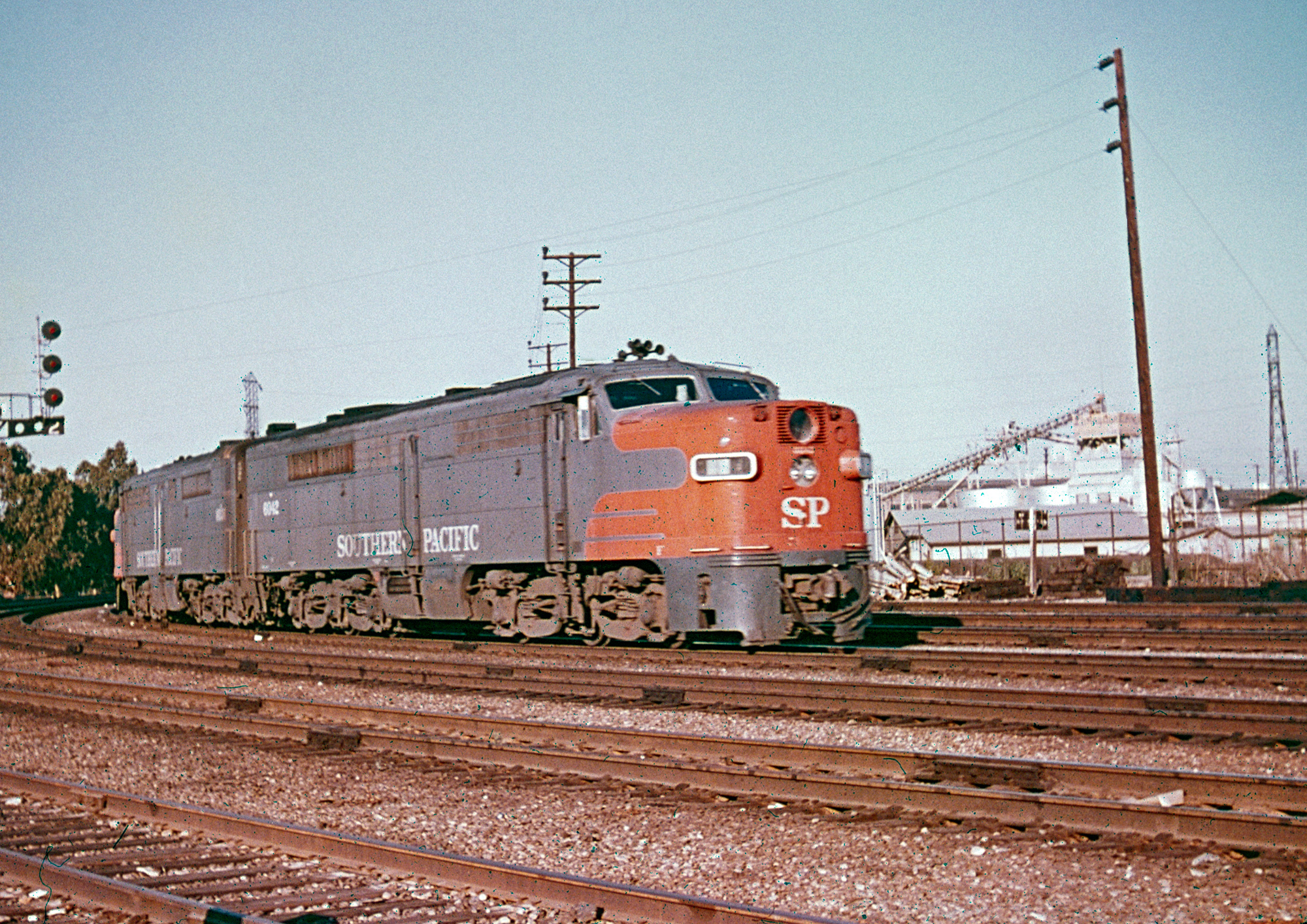 A pair of Southern Pacific PA-2's, led by #6042, are running light as they arrive in Los Angeles during the summer of 1963. Author's collection.
A pair of Southern Pacific PA-2's, led by #6042, are running light as they arrive in Los Angeles during the summer of 1963. Author's collection.The first decision involved continuing east to the Colorado River at Fort Yuma, Arizona. That extension was completed in May of 1877 and with the Atlantic & Pacific bogged down by financial problems the "Big Four" pressed on after successfully amending their railroad's charter.
It enabled them to reach Texas where the SP would meet the Texas & Pacific Railway (then under Jay Gould's control) at El Paso. After just four years of construction the latter point was reached on May 19, 1881.
With the T&P still 100 miles away Huntington elected to continue building eastward and arrived in Sierra Blanca by November 25th.
This decision greatly angered Gould and the two parties went to court over the matter. It was finally resolved when they signed the "Gould-Huntington Agreement" on November 26, 1881, which gave the T&P trackage rights over the SP from Sierra Blanca to El Paso but also forfeited the former's charter and franchises west of that point (awarded to SP).
Notable Acquisitions
The speed at which Huntington raced across the Southwest was, indeed, quite impressive. By January 12, 1883 his railroad was complete to Pecos, a location where it met the Galveston, Harrisburg & San Antonio Railway, another Huntington-controlled system that had been building west from San Antonio.
Through this subsidiary, and control of the Louisiana & Texas Railroad & Steamship Company, the SP offered through service from Los Angeles to New Orleans over the newly christened "Sunset Route"
In 1881, Huntington picked up another property known as the Texas & New Orleans Railroad. In 1927, all of SP's subsidiaries in Texas and Louisiana, except for the "Cotton Belt," were operated under the T&NO name.
Collis P. Huntington
In 1884 the SP maintained a commanding 4,711-mile network, including all subsidiaries and leased properties.
By then, Collis Huntington's held complete control after the "Big Four" had fragmented:
- Mark Hopkins died on March 29, 1878
- Crocker sold out in 1871 but came back in 1873 as a minority owner until his death on August 14, 1888
- Leland Stanford and Huntington had an increasingly strained relationship resulting in the former handing over the presidency to the latter on February 28, 1890
Throughout the 1880's, Huntington continued growing his empire; not only did he dominate rail service throughout the Golden State but also eyed expansion toward the Puget Sound.
- He would later lose his grip on California when the Atchison, Topeka & Santa Fe's William Barstow Strong outmaneuvered the tycoon and broke up his monopoly. -
The SP accessed Redding in 1872 through a subsidiary known as the California & Oregon Railroad (C&O). This system carried a history dating back to 1865 (acquired by CP in 1870); it was envisioned to connect Marysville, California with Portland, Oregon but only succeeded in doing so with the "Big Four's" financial backing.
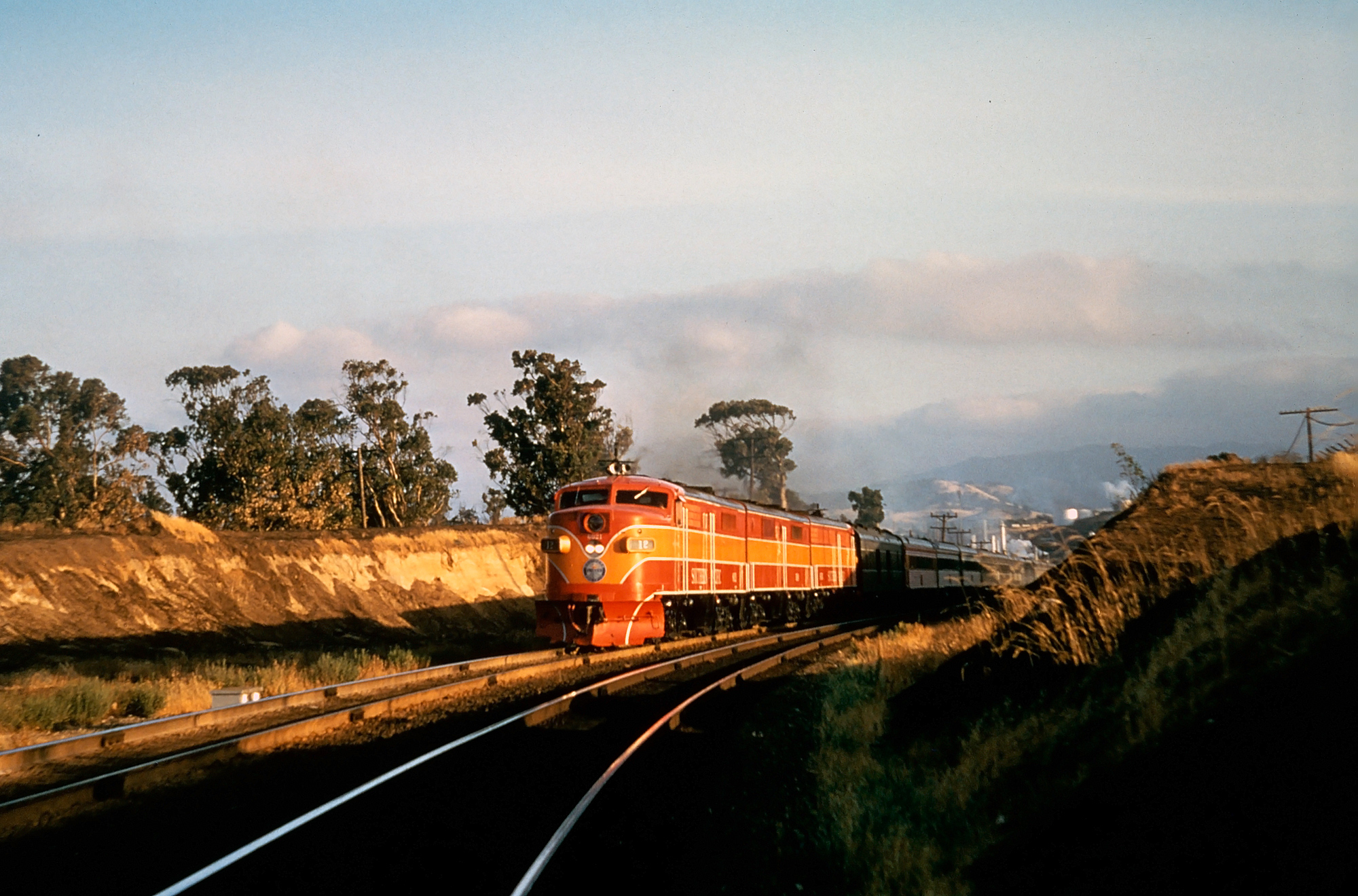 A beautiful Southern Pacific PA-PB-PA set, led by PA-1 #6021, lead train #12, the northbound "Cascade," out of the Bay Area, circa 1956. This service ran the Shasta Route, linking Oakland/San Francisco with Portland, Oregon. Gordon Glattenberg photo. American-Rails.com collection.
A beautiful Southern Pacific PA-PB-PA set, led by PA-1 #6021, lead train #12, the northbound "Cascade," out of the Bay Area, circa 1956. This service ran the Shasta Route, linking Oakland/San Francisco with Portland, Oregon. Gordon Glattenberg photo. American-Rails.com collection.After a decade of dormancy, the C&O was extended to Ashland, Oregon in 1887. There it met the similarly-named Oregon & California Railroad (O&C, originally known as the Oregon Central Railroad), led by Henry Villard, which had built south from Portland.
That same year the then-bankrupt O&C was acquired. During a formal last spike ceremony (driven by Charles Crocker) on December 17th the Southern Pacific established a new corridor to Portland, better known as the Siskiyou Line which formed part of its "Shasta Route."
By 1890, SP owned a network of 8,000 route miles and as it continued growing formed the classic system remembered so well today.
In 1901 it completed the fabled "Coast Line," which offered a direct route from San Francisco to Los Angeles, via San Luis Obispo and Santa Barbara.
It was along this corridor, featuring breathtaking scenes of the Pacific Ocean, that SP unveiled its wildly successful Coast Daylight streamliner on March 21, 1937.
Thanks to this train's popularity an entire fleet was launched in the succeeding years with names like the Sacramento Daylight, San Joaquin Daylight, and Shasta Daylight.
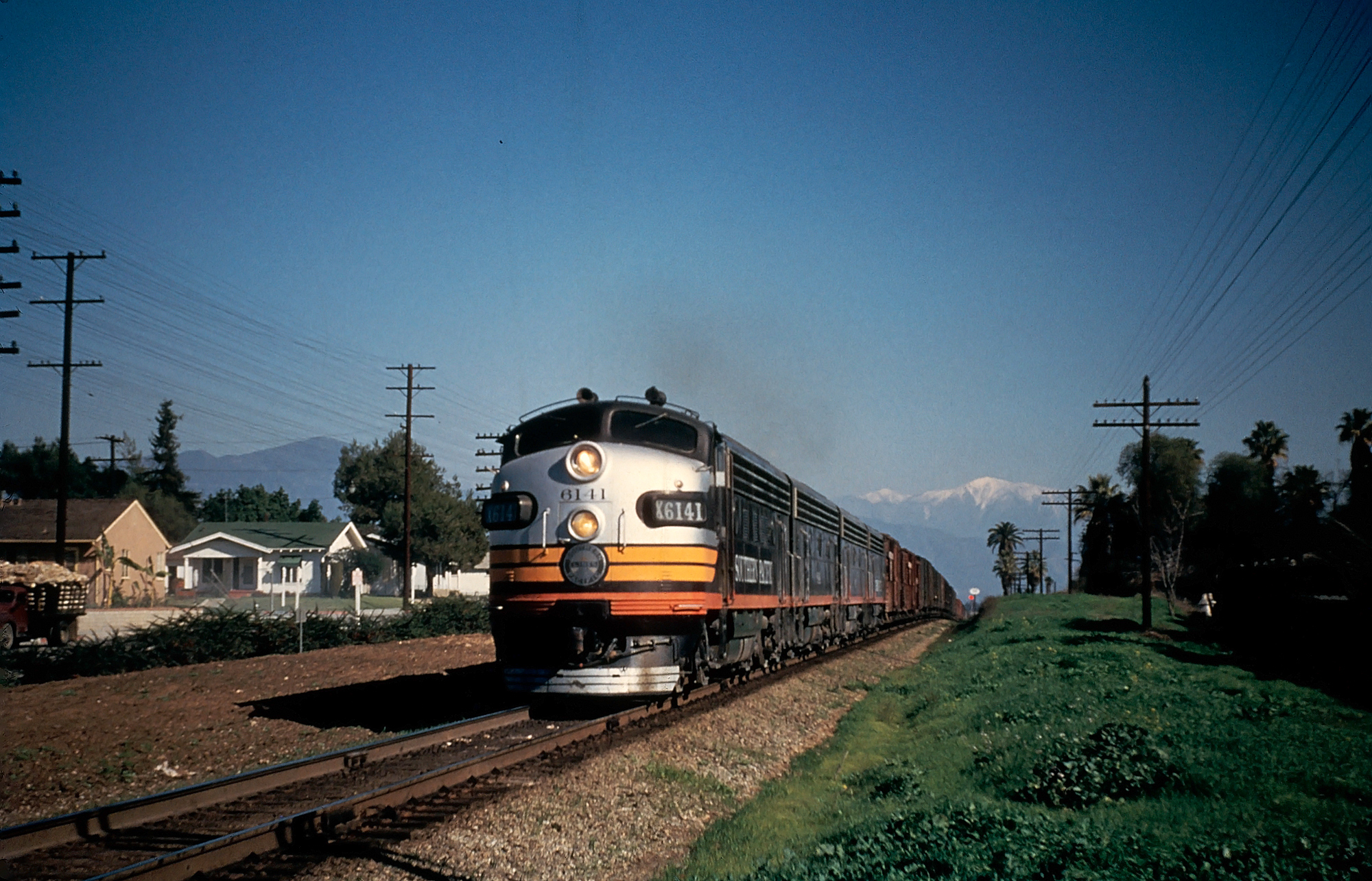 A handsome set of Southern Pacific F7's, led by #6141, lead a westbound freight consist near Pomona, California, circa 1956. Gordon Glattenberg photo. American-Rails.com collection.
A handsome set of Southern Pacific F7's, led by #6141, lead a westbound freight consist near Pomona, California, circa 1956. Gordon Glattenberg photo. American-Rails.com collection.Collis Huntington leadership ended with his death on August 13, 1900. He had built an impressive railroad which roughly formed a crescent moon shape extending from Portland, Oregon to New Orleans via California and the American Southwest.
In 1901, another noted mogul, Edward Harriman, acquired a 45% stake in SP; his reign lasted less than a decade when he died on September 9, 1909.
However, during his brief stint he greatly improved the property by funneling millions into rebuilding bridges, double-tracking key sections of main line, and purchasing new locomotives/equipment.
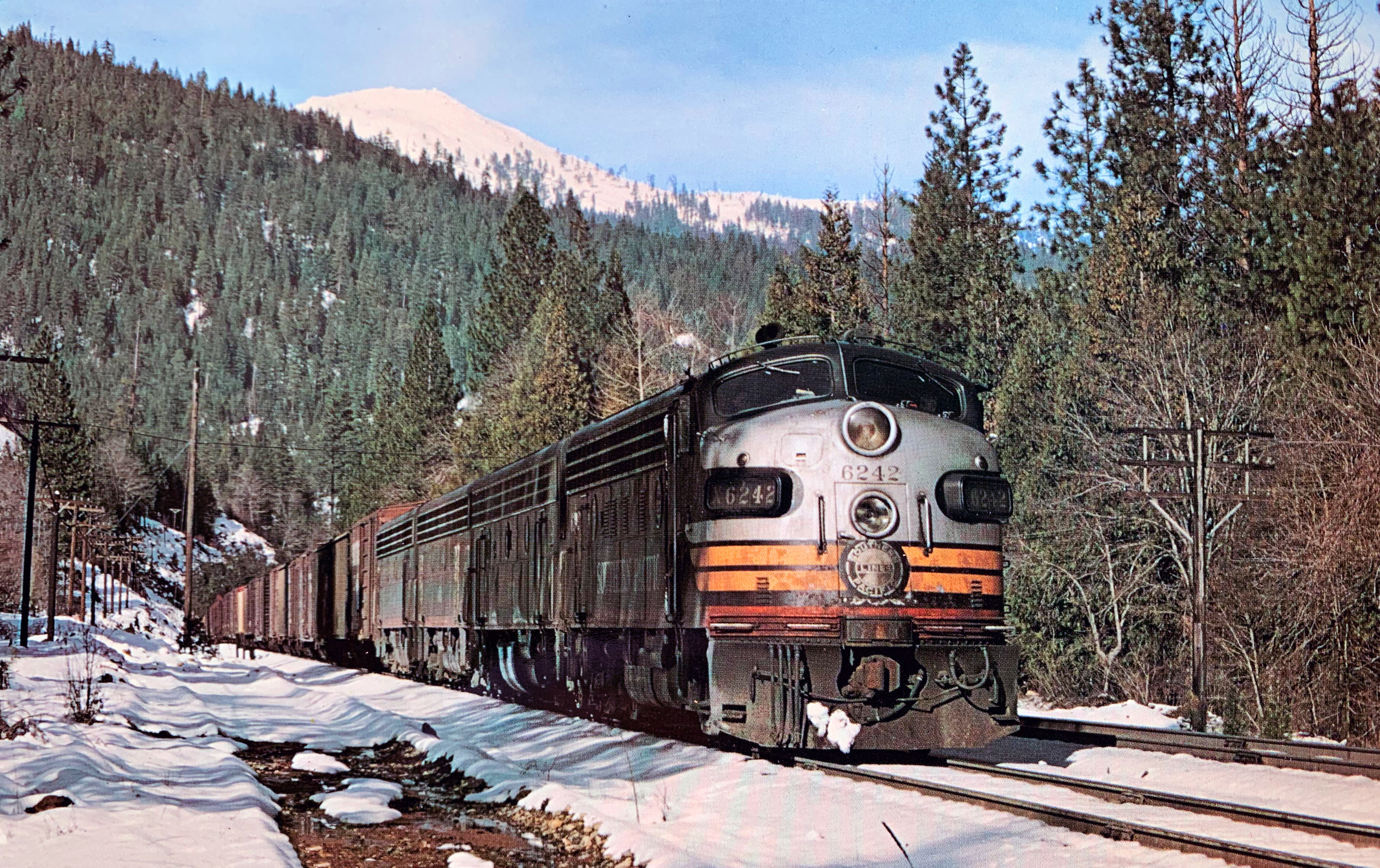 A quartet of Southern Pacific F7's, led by #6242, ease downgrade through the Sacramento River Canyon near Castella, California on January 26, 1964. Tom Gildersleeve photo. Author's collection.
A quartet of Southern Pacific F7's, led by #6242, ease downgrade through the Sacramento River Canyon near Castella, California on January 26, 1964. Tom Gildersleeve photo. Author's collection.Two of his most noteworthy projects included upgrading the Shasta Route and building the Lucin Cutoff. The former improved SP's Portland gateway by circumventing the steep, circuitous, and grade-riddled (as high as 3.3%) Siskiyou Line.
What was known as the Natron Cutoff, or Cascade Line, began during the Harriman era and headed east/southeast from Eugene.
It passed to the east of Crater Lake and through the Cascade Mountains but required over a decade to finish due to ongoing legal issues surrounding Harriman's ownership of both the Union Pacific and Southern Pacific (the two were separated following a Supreme Court ruling in December of 1912).
There was also the Modoc Line which opened in 1929 at a cost of $16 million; it acted as an inside gateway between southern Oregon and western Nevada.
System Map (1969)
Modern Network
The Natron Cutoff was finally completed in February of 1926 where it reconnected with the Siskiyou Line at Black Butte, California. The original Lucin Cutoff, a combined 16-mile causeway and 12-mile wooden trestle, pierced the center of the Great Salt Lake. It opened in 1903 at a cost of $8.4 million.
This undertaking not only reduced grades by circumventing the lake's northern shore but also reduced 44 miles from the Ogden main line.
Throughout the 1920's the "Espee" continued its expansion program; on October 31, 1924 it purchased the 1,200-mile El Paso & Southwestern Railroad from the Phelps, Dodge Corporation for $64 million and then, nearly a decade later, added the much larger, 1,500-mile St. Louis Southwestern Railway on April 19, 1932.
The EP&SW largely served the same territory as the SP with a main line running from Benson, Arizona to El Paso. However, it did contain one important segment, a north-south line linking El Paso with Tucumcari, New Mexico where it met the Chicago, Rock Island & Pacific (Rock Island).
This interchange proved very important and became part of the railroads' Golden State Route as they worked closely in handling business between Chicago and Los Angeles. The St. Louis Southwestern, better known as the "Cotton Belt," carried even greater importance with lines connecting Texas with St. Louis.
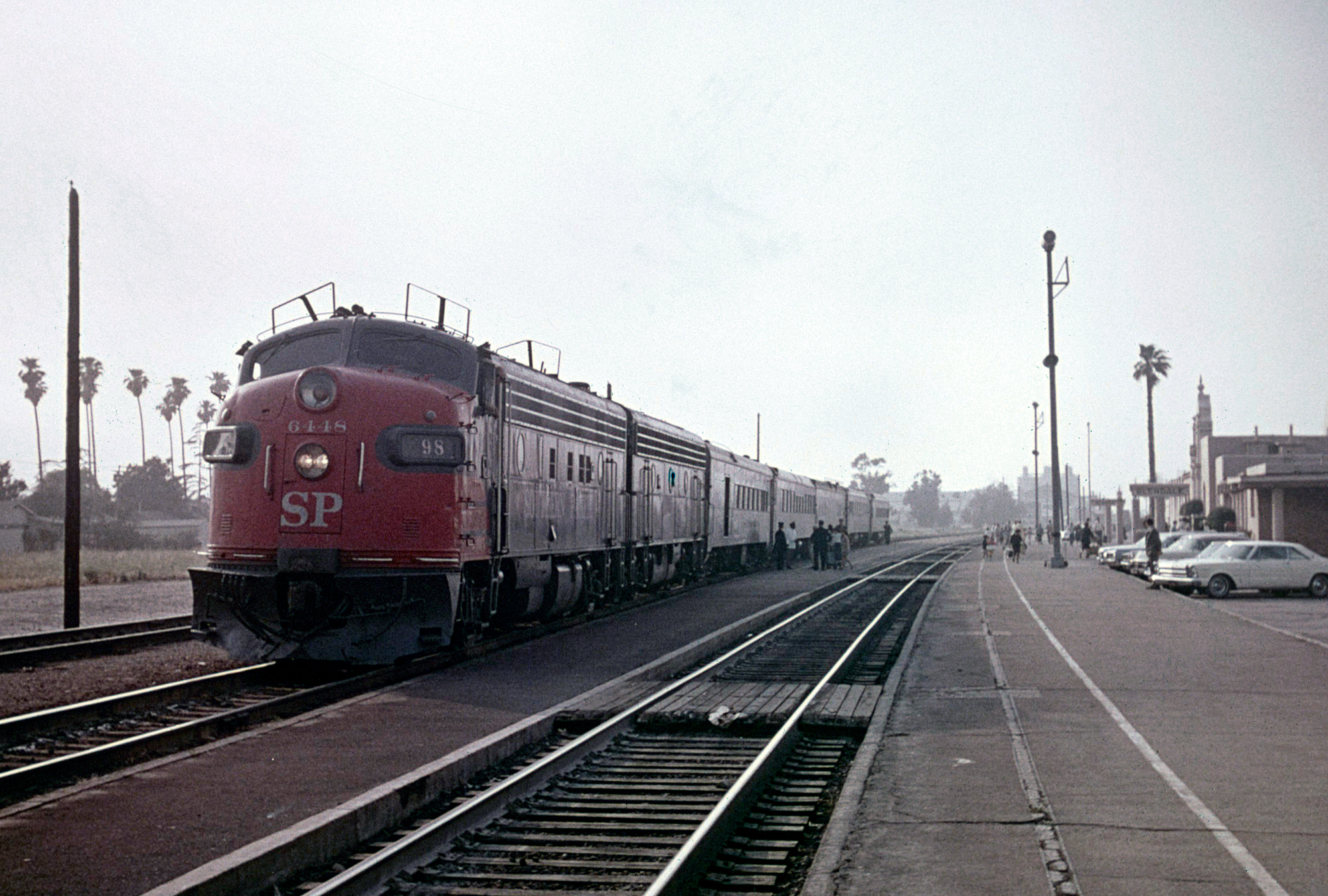 Southern Pacific FP7 #6448 is stopped at Glendale, California with train #98, the eastbound/southbound "Coast Daylight" in May of 1967. American-Rails.com collection.
Southern Pacific FP7 #6448 is stopped at Glendale, California with train #98, the eastbound/southbound "Coast Daylight" in May of 1967. American-Rails.com collection.The Southern Pacific is credited with launching one of the most successful and glamorous streamliners ever put into service when the previously-mentioned Coast Daylight debuted in 1937. Ironically, only two decades later the railroad became disenchanted with these trains.
First, it dropped its beautiful two-tone orange "Daylight" livery in favor of a simplified red/grey scheme and then reduced the fleet until only a few services remained by the time Amtrak began on May 1, 1971.
In the postwar years, SP increasingly turned its attention to freight; it fully dieselized in 1957 and was an early proponent of modernization.
The company was quick to utilize computers and install electronic hump yards (the first computerized hump yards opened in 1973 at West Colton, California) to increase efficiency.
It moved a wide variety of products at this time ranging from lumber, automobiles, steel and chemicals to petroleum, copper, agriculture, and trailer-on-flatcar (TOFC) service (after 1953).
The latter transitioned into container-on-flatcar (COFC), or intermodal, which became a major source of traffic after the 1980's.
To meet this demand, SP purchased its first double-stack containers in 1981. Of particular note was its once highly lucrative perishable business serving California's lush San Joaquin Valley.
In 1886 the railroad developed the first refrigerator car, or reefer, and later worked with Union Pacific to inaugurate Pacific Fruit Express (PFE).
As Mike Schafer notes in his book "Classic American Railroads," by 1962 the two owned some 22,000 reefers operating as part of dedicated time freights.
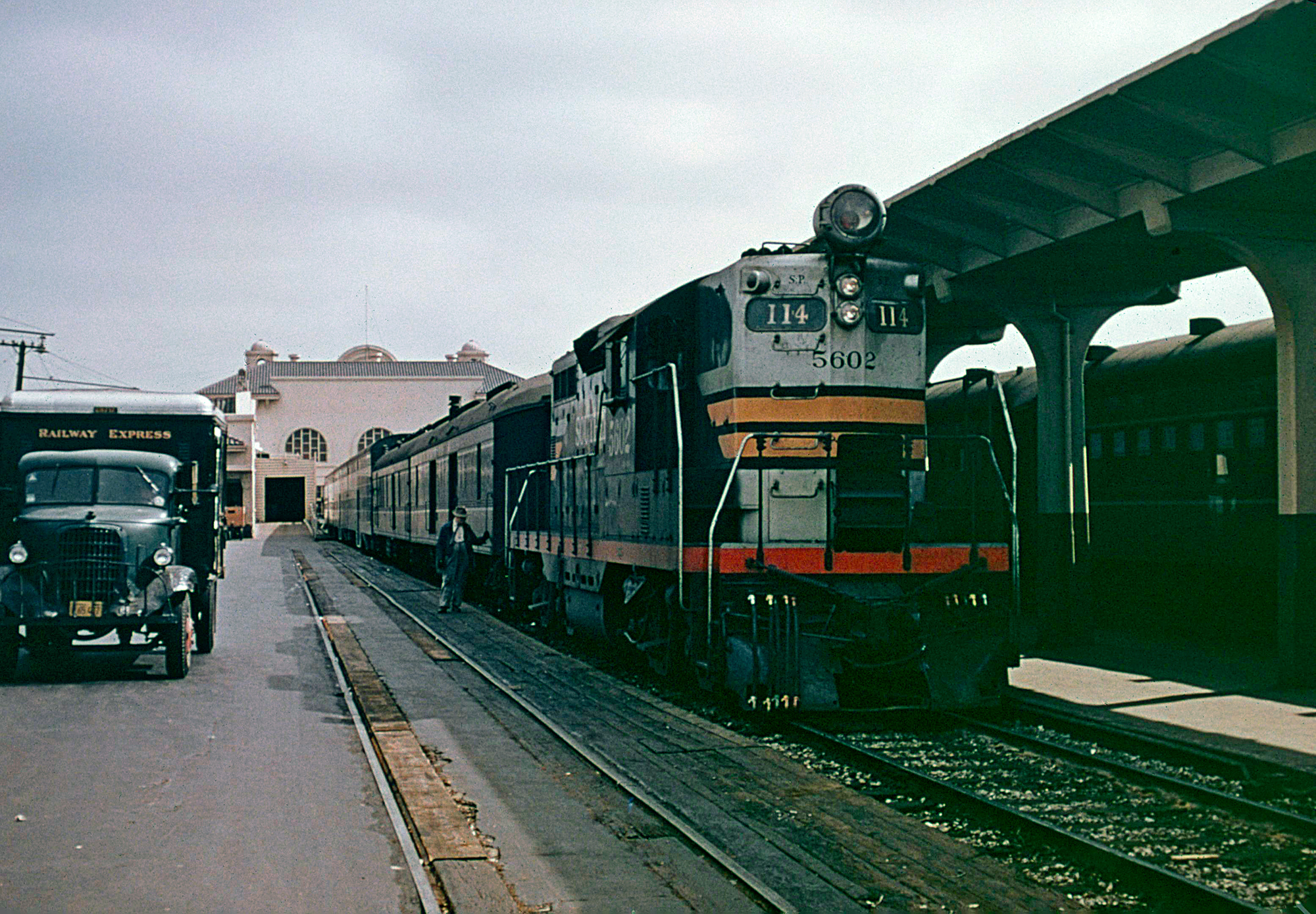 Southern Pacific GP9 #5602 awaits departure from San Francisco's 3rd & Townsend Depot with commuter train #114 in September, 1956. American-Rails.com collection.
Southern Pacific GP9 #5602 awaits departure from San Francisco's 3rd & Townsend Depot with commuter train #114 in September, 1956. American-Rails.com collection.For all of the railroad’s historic wealth and prosperity (it even weathered the Great Depression without experiencing bankruptcy) traffic pattern shifts, coupled with poor management, proved costly. Donald J. Russell, who took the helm on January 1, 1952, was the company's last great leader.
He expected a well-run and well-maintained railroad on the cutting edge of innovation. However, as Don Hofsommer points out in his article, "Not Only A Railroad, But An Empire: How SP Went From Mighty Octopus To Tarnished Suitor," from the March, 1998 issue of Trains Magazine, following his departure SP's fortunes took a turn for the worse.
On May 17, 1972, Benjamin F. Biaggini succeeded Russell. He was brought in for a singular purpose, diversification. With much of the industry struggling after the 1950's many turned to holding companies as a means of expanding their portfolios to escape the transportation sector's cyclical nature.
While financial difficulties were not being experienced at the time its board nevertheless felt the plan was important for long term growth.
Southern Pacific Communications Company
In 1969 a new Southern Pacific Company was born as a holding company for the railroad (Southern Pacific Transportation Company), the new Southern Pacific Communications Company (SPCC), and the SP's lesser subsidiaries.
The SPCC was created for public use, most notably as a telephone provider, but its history can be traced back much, much further. It was originally born from a great need by the railroad to provide its own efficient and reliable means of communication within its vast, 15,000-mile network.
According to Mr. Yenne's book, by 1953 Southern Pacific had developed the largest private communications system in the world. What began as a general telegraph/telephone line system eventually developed into an intricate, reliable, and highly technological network (which included microwave) that covered 500,000 channel miles with a 99.96% daily reliability rate.
The system could be used for direct communication as well as facsimile transmission, telemetering, dispatching, CTC, VHF radio, and car identification.
In 1973, the railroad began marketing the Southern Pacific Communications Company to the general public. As it grew and became profitable it was sold to General Telephone & Electronics (GTE) in 1982 for $740 million. Today, this
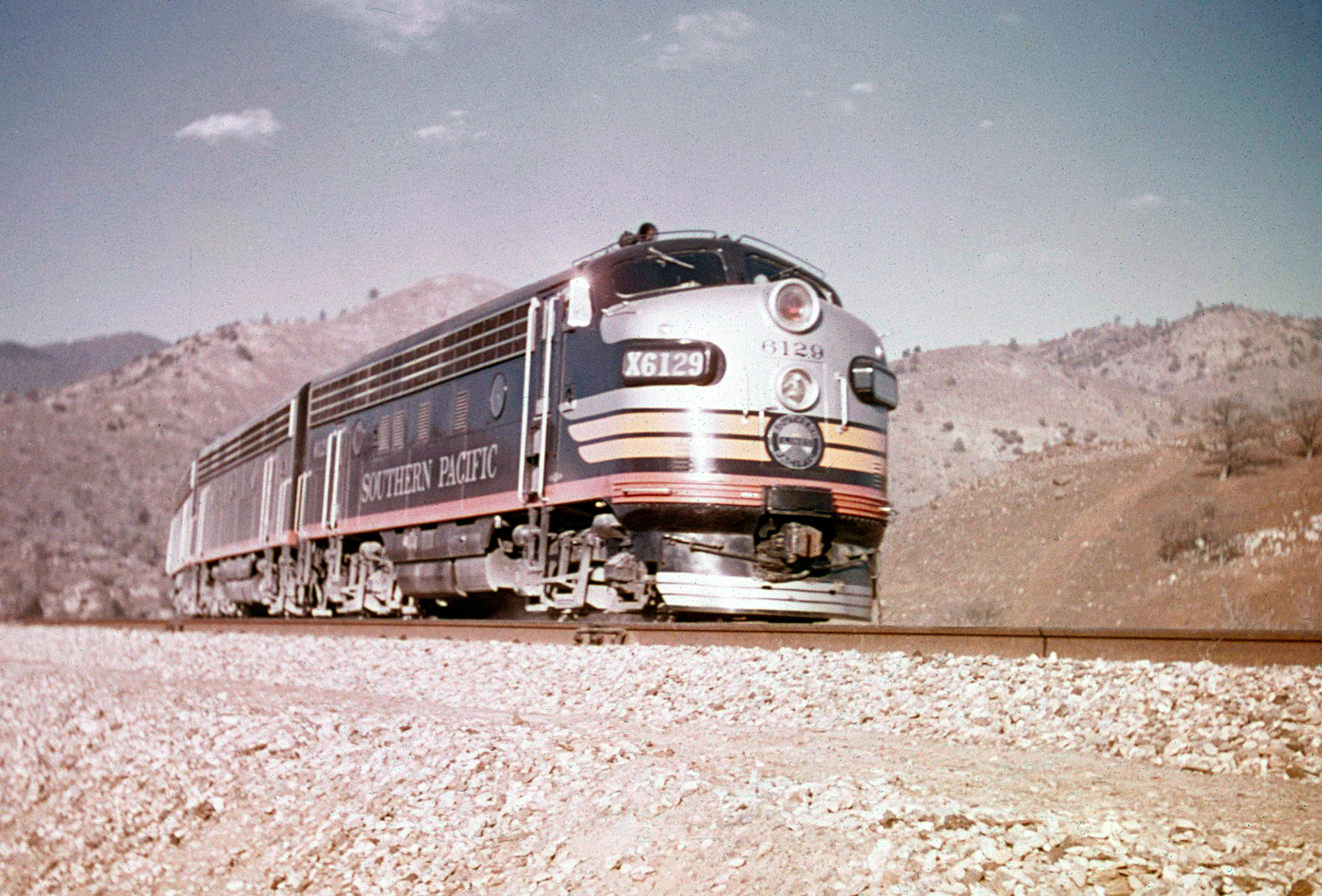 Southern Pacific F7A #6129 leads an eastbound freight near Bakersfield, California during the 1950s. American-Rails.com collection.
Southern Pacific F7A #6129 leads an eastbound freight near Bakersfield, California during the 1950s. American-Rails.com collection.In doing so, the railroad was neglected, a common theme from the holding company era. As service rapidly declined and the country shifted from a manufacturing base to services, business evaporated.
Its once profitable automotive traffic and San Francisco industrial base disappeared as plants either closed or moved overseas.
SP's perishable losses were a direct result of poor service, both of its own making and the disaster unfolding back east where Penn Central's collapse was being felt nationwide. Farmers could ill-afford to lose their cash crops and, as a result, quickly abandoned trains for trucks.
The SP's once sprawling network of branch lines and spurs throughout the valley, seemingly reaching every farm and field, had largely been abandoned by the 1980's.
In barely a decade one of the industry's stars, carrying a network of 15,039 route miles (including the Cotton Belt), was desperately trying to avoid bankruptcy.
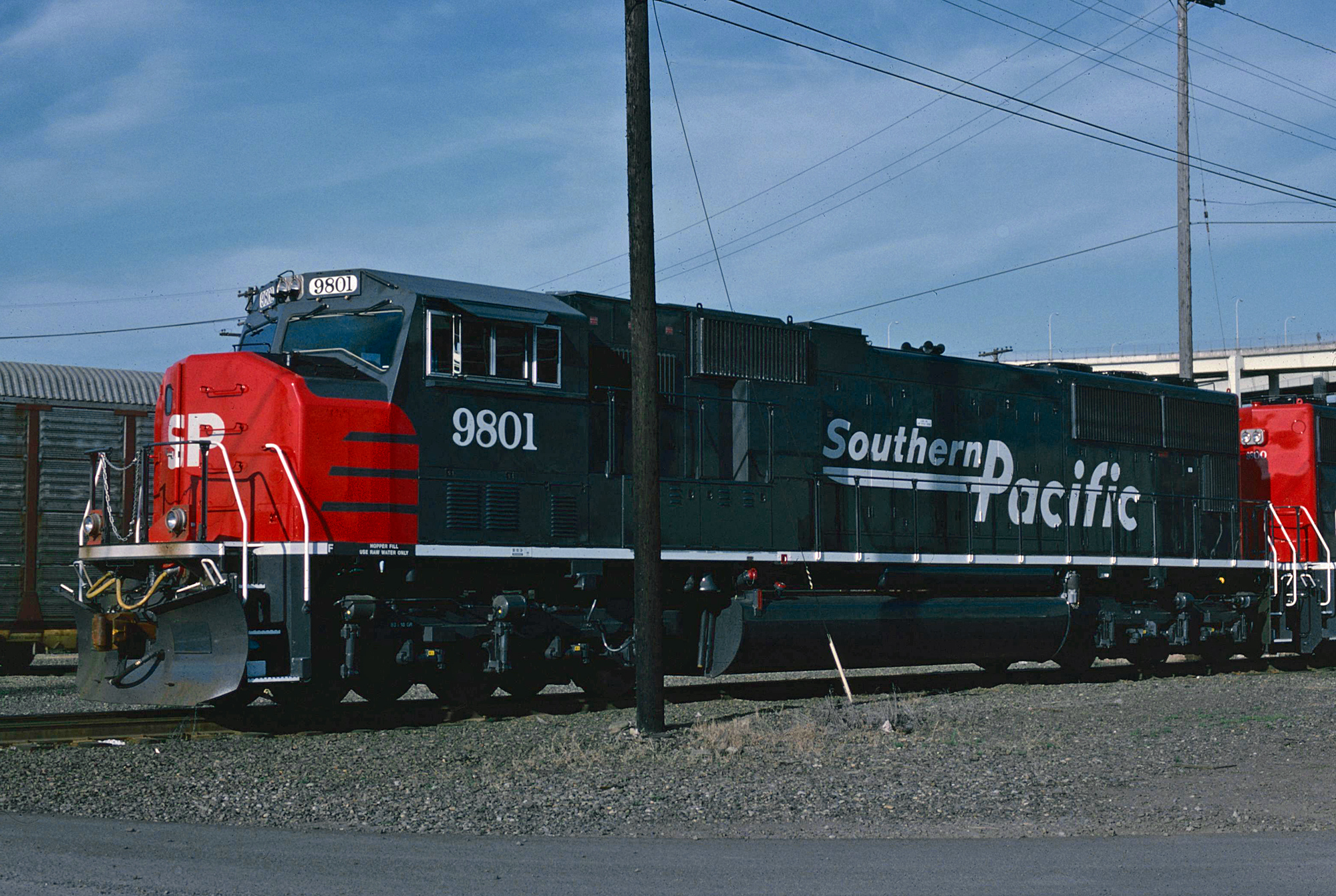 Southern Pacific SD70M #9801, just two months old, was photographed here by Keith Ardinger in Portland, Oregon on June 30, 1994. American-Rails.com collection.
Southern Pacific SD70M #9801, just two months old, was photographed here by Keith Ardinger in Portland, Oregon on June 30, 1994. American-Rails.com collection.To do so, Southern Pacific sought merger with a stronger carrier. It found one in the powerful and world-renowned Santa Fe.
Steve Glischinski notes in his book, "Santa Fe Railway," the Atchison, Topeka & Santa Fe and SP announced on May 15, 1980 they would become one to form the Southern Pacific & Santa Fe Railway.
Within months these talks ended but were renewed just three years later on September 27, 1983. In these latest discussions a merger was approved, which created the Santa Fe Southern Pacific Corporation.
Passenger Trains
Argonaut: (Los Angeles - New Orleans)
Cascade: (Oakland - Portland)
City of San Francisco: Union Pacific's streamliner forwarded by the SP to Oakland, California.
The Daylight Fleet: (San Francisco - Los Angeles)
Del Monte: (San Francisco - Monterey)
Golden State: (Los Angeles - Chicago via Tucumcari in conjunction with the Rock Island)
Imperial: Operated between Los Angeles and Chicago in conjunction with the Rock Island.
Lark: (Oakland/San Francisco - Los Angeles via San Luis Obispo)
Owl: (San Francisco - Los Angeles)
Sacramento Daylight: (Sacramento - Los Angeles)
San Francisco Overland: Until 1955 operated in conjunction with UP and C&NW between Los Angeles and Chicago. Afterward operated only west to St. Louis via the Wabash Railroad.
San Joaquin Daylight: (Oakland - Los Angeles via Bakersfield)
Shasta Daylight: (Oakland - Portland)
Starlight: (San Francisco - Los Angeles)
Sunbeam/Hustler: (Houston - Dallas)
Sunset Limited: (Originally San Francisco - New Olreans, later Los Angeles - New Orleans)
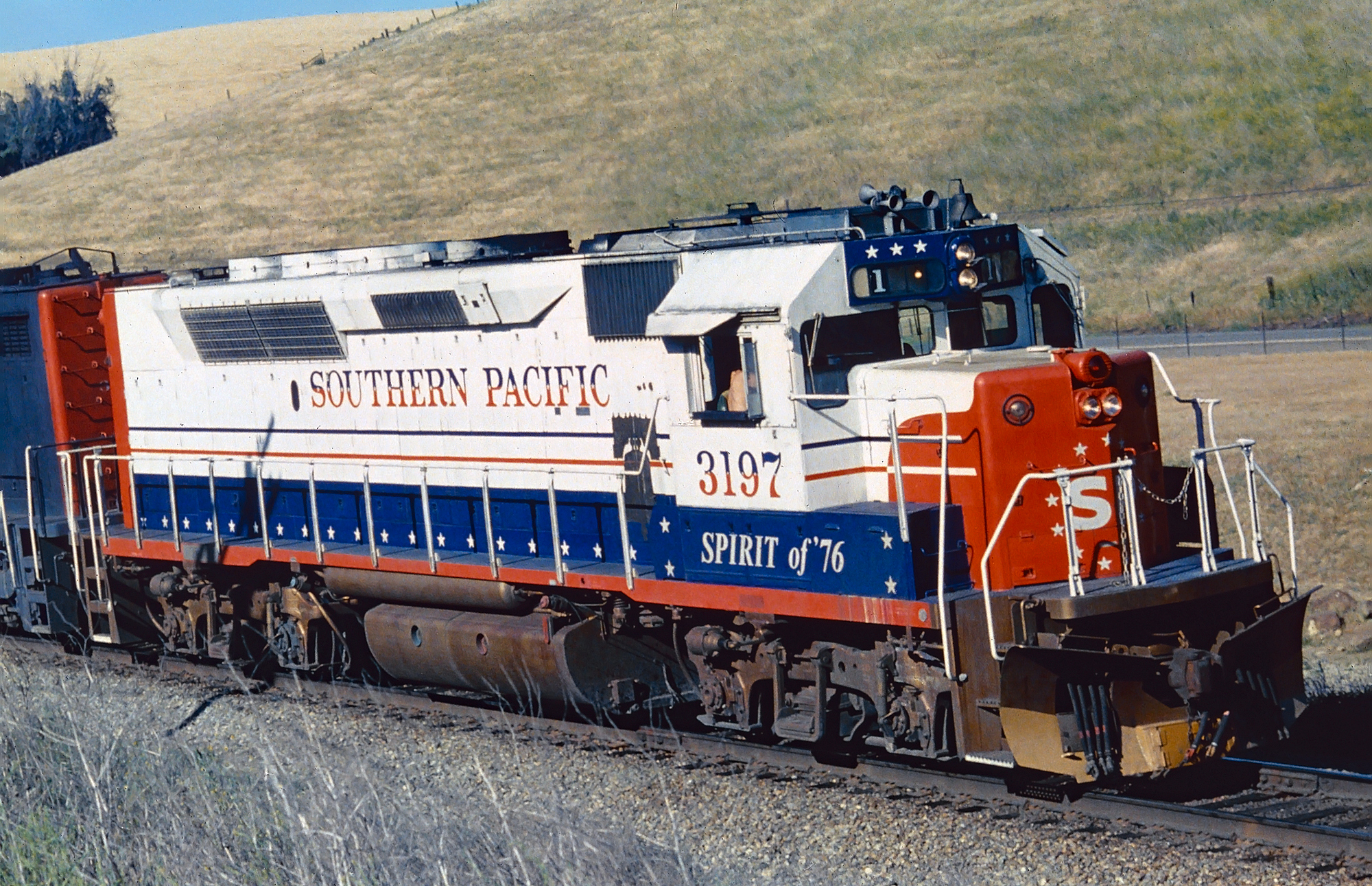 Southern Pacific GP40P-2 #3197, wearing its Bicentennial livery, is seen here in service on Altamont Pass, California, circa 1978. Gary Perrazo photo. American-Rails.com collection.
Southern Pacific GP40P-2 #3197, wearing its Bicentennial livery, is seen here in service on Altamont Pass, California, circa 1978. Gary Perrazo photo. American-Rails.com collection.While the two railroads remained separate their holding companies (Santa Fe Industries and Southern Pacific Company) were joined on December 23, 1983.
In a stunning defeat, the Interstate Commerce Commission announced on July 24, 1986 that it had denied the marriage on monopolistic grounds.
The stillborn railroad had even adopted a new livery of red and yellow (dubbed the "Kodachrome" scheme), which had been applied to some locomotives and equipment. Railfans facetiously dubbed it "Shouldn't Paint So Fast."
Diesel Roster
American Locomotive Company
| Model Type | Road Number | Date Built | Quantity |
|---|---|---|---|
| S1 | 10 (T&NO), 1017-1020 | 1941 | 5 |
| S2 | 30-71 (T&NO), 89-94 (T&NO), 1300-1309, 1330-1370, 1386-1392, 1426-1441 | 1941-1950 | 122 |
| S4 | 95-104 (T&NO), 1464-1485, 1514-1528, 1551-1567 | 1951-1955 | 64 |
| PA-1 | 200A-205A (T&NO), 200B-205B (T&NO), 6005A-6010A, 6005C-6010C | 1948-1949 | 24 |
| HH-660 | 1001-1003 | 1939 | 3 |
| S3 | 1023-1032 | 1951 | 10 |
| S6 | 1033-1090, 4634-4645 | 1955-1956 | 70 |
| C415 | 2400-2409 | 1966 | 10 |
| RSD15 | 4816-4818 | 1959 | 3 |
| C628 | 4845-4869 | 1965 | 25 |
| RSD5 | 5294-5307, 5336-5339, 5445-5448, 5494-5507 | 1953-1956 | 36 |
| RS11 | 5723-5729, 5845-5871 | 1956-1959 | 34 |
| PB-2 | 5918-5924 | 1950-1953 | 7 |
| PB-1 | 6005B-6010B | 1948-1949 | 6 |
| PA-2 | 6019-6045, 6900-6905 | 1950-1953 | 33 |
| RSD12 | 7000-7020 | 1961 | 21 |
| RS32 | 7300-7309 | 1962 | 10 |
| C630 | 7800-7814 | 1966 | 15 |
| C643 | 9018-9020 | 1964 | 3 |
Baldwin Locomotive Works
| Model Type | Road Number | Date Built | Quantity |
|---|---|---|---|
| S12 | 105-107 (T&NO), 1442-1463, 1492-1513, 1539-1550 | 1951-1953 | 59 |
| AS416 | 177-184 (T&NO), 5228-5278 | 1950-1952 | 59 |
| DRS-6-6-1500 (A) | 187-190 (T&NO), 5203-5226 | 1949-1950 | 28 |
| VO-660 | 1021-1022 | 1941 | 2 |
| VO-1000 | 1320-1329, 1371-1385 | 1941-1944 | 25 |
| DS-4-4-1000 | 1393-1402 | 1948 | 10 |
| DRS-6-6-1500 (B) | 5227 | 1950 | 1 |
| DRS-6-4-1500 | 5200-5202 | 1948 | 3 |
Electro-Motive Corporation/Electro-Motive Division
| Model Type | Road Number | Date Built | Quantity |
|---|---|---|---|
| E2A | SF1 | 1937 | 1 |
| E2B | SF2-SF3 | 1937 | 2 |
| E6A | SF4 | 1941 | 1 |
| E6B | SF5-SF6 | 1941 | 2 |
| SW1 | 11 (T&NO), 1000, 1004-1016 | 1939-1941 | 15 |
| SW8 | 12-16 (T&NO), 4604-4623 | 1953-1954 | 25 |
| NW2 | 72-88 (T&NO), 1310-1319, 1403-1425 | 1941-1949 | 40 |
| SW9 | 108-112 (T&NO) | 1953 | 5 |
| SW1200 | 113-118 (T&NO), 123-128 (T&NO), 1597-1606 | 1954-1965 | 22 |
| GP9 | 240-249 (T&NO), 280-283 (T&NO), 400-410 (T&NO), 411-458 (T&NO), 5600-5719, 5730-5844, 5872-5891 | 1954-1959 | 318 |
| F7A | 338-381 (T&NO), 6140A-6169A, 6140D-6169D, 6240-6423, 6440-6445 | 1949-1953 | 288 |
| F7B | 538-553, 6140B-6169B, 6140C-6169C, 8140-8303 | 1949-1953 | 240 |
| E7A | 907A, 6000A-6004A | 1946-1947 | 6 |
| E7B | 908B-909B, 6000B-6004B, 6000C-6004C | 1946-1947 | 12 |
| SW1500 | 2450-2480, 2493-2510, 2523-2578, 2591-2689 | 1967-1969 | 204 |
| MP15DC | 2690-2701 | 1974-1975 | 12 |
| MP15AC | 2702-2731, 2736-2759 | 1975 | 54 |
| SD38-2 | 2971-2976 | 1973 | 6 |
| GP40P-2 | 3197-3199 | 1974 | 3 |
| SDP45 | 3200-3209 | 1967 | 10 |
| TR6 | 4600-4700 (Cow-Calf), 4601-4603 (Cow), 4701-4703 (Calf) | 1950-1951 | 8 |
| SW900 | 4624-4633 | 1954 | 10 |
| GP38-2 | 4800-4844 (Second) | 1980 | 45 |
| SD35 | 4816-4844 (First) | 1963-1965 | 29 |
| SD7 | 5279-5293, 5308-5335 (First) | 1952-1953 | 43 |
| SD39 | 5300-5325 (Second) | 1968 | 26 |
| SD9 | 5340-5444, 5449-5493 | 1954-1956 | 150 |
| E8A | 6018 | 1950 | 1 |
| E9A | 6046-6054 | 1954 | 9 |
| F3A | 6100A-6139A, 6100D-6139D | 1947-1949 | 280 |
| F3B | 6100B-6139B, 6100C-6139C | 1947-1949 | 280 |
| FP7 | 6446-6461 | 1953 | 16 |
| GP20 | 7200-7237 (First) | 1960-1962 | 38 |
| GP40X | 7200-7201, 7230-7231 (Second) | 1978 | 4 |
| GP30 | 7400-7407 | 1963 | 8 |
| GP35 | 7408-7484, 7700-7782 | 1963-1965 | 160 |
| GP40-2 | 7608-7627, 7640-7677 | 1978-1984 | 58 |
| SD40T-2 | 8230-8391, 8489-8573 | 1974-1979 | 247 |
| DD35 | 8400-8402 (First) | 1964 | 3 |
| SD40 | 8400-8488 (Second) | 1966 | 89 |
| SD45 | 8800-8963, 8982-9051, 9069-9151 | 1966-1970 | 348 |
| SD45T-2 | 9166-9313, 9344-9370 | 1972-1975 | 175 |
| SD45X | 9500-9505 | 1970-1971 | 6 |
| GP60 | 9600-9619, 9715-9794 | 1988-1994 | 100 |
| SD70M | 9800-9824 | 1994 | 25 |
Fairbanks Morse
| Model Type | Road Number | Date Built | Quantity |
|---|---|---|---|
| H12-44 | 1486-1491, 1529-1596 | 1952-1957 | 74 |
| H24-66 (Train Master) | 4802-4815 | 1953-1954 | 14 |
General Electric
| Model Type | Road Number | Date Built | Quantity |
|---|---|---|---|
| 50-Tonner (Narrow-Gauge) | 1 | 1954 | 1 |
| AC4400CW | 100-378 | 1995 | 279 |
| 70-Tonner | 5100-5120 (First) | 1949-1955 | 21 |
| B23-7 | 5100-5114 (Second) | 1980 | 15 |
| U28B | 7025-7028 | 1966 | 4 |
| U28C | 7150-7159 | 1966 | 10 |
| U25B | 7500-7567 | 1962-1966 | 68 |
| B36-7 | 7754-7769 | 1984 | 16 |
| B30-7 | 7800-7883 | 1978-1979 | 84 |
| U30C | 7900-7936 | 1968-1969 | 37 |
| B39-8 | 8000-8039 | 1987 | 40 |
| C44-9W | 8100-8200 | 1994 | 101 |
| U50 | 8500-8502 | 1964 | 3 |
| U33C | 8585-8796 | 1969-1975 | 212 |
Steam Roster
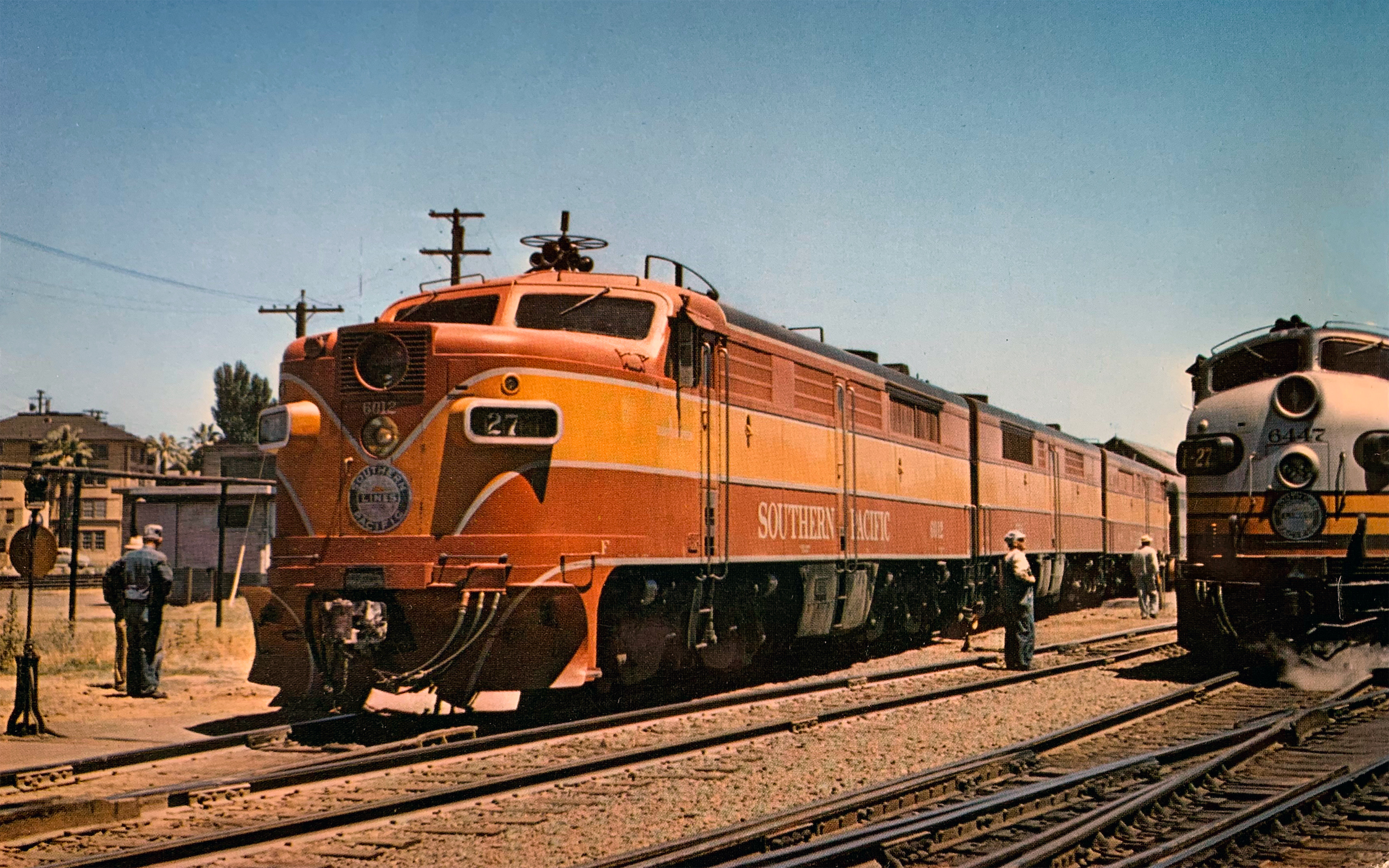 Southern Pacific PA-1 #6012 (built as #6008-C) is paused at Sacramento, California with train #27, the westbound "San Francisco Overland," in 1957. Harold Elmore photo. Author's collection.
Southern Pacific PA-1 #6012 (built as #6008-C) is paused at Sacramento, California with train #27, the westbound "San Francisco Overland," in 1957. Harold Elmore photo. Author's collection.Rio Grande Industries Takeover
Despite this setback, the SP did enjoy one bright spot that decade; in 1980 it acquired the bankrupt Rock Island's Golden State Route from Tucumcari to St. Louis, via Kansas City, operated by subsidiary Cotton Belt.
A few years later Southern Pacific finally found a partner when Rio Grande Industries, parent to the Denver & Rio Grande Western (Rio Grande) purchased the railroad in 1988.
Interestingly, in a nearly unheard of decision, Rio Grande elected to use the much more prominent Southern Pacific name instead of its own. Combined, the two railroads formed a 17,340 mile system.
A mere seven years later, in 1995, Union Pacific announced it would acquire the entire Southern Pacific as a counter-move to the Burlington Northern and Santa Fe merger.
The union was approved by the new Surface Transportation Board (successor to the Interstate Commerce Commission) and a much larger Union Pacific came to be on September 11, 1996.
SP was so large that UP encountered a logistical nightmare that nearly resulted in total gridlock as yards clogged, transit times greatly increased, and operating ratios soared.
Unlike the Penn Central disaster, though, UP managed to work out the kinks. Today, Southern Pacific's legacy lives on in its main lines and Amtrak's operation of its former passenger services.
Union Pacific also paid homage to several predecessors in 2005, including SP, by painting one of its new EMD SD70ACe locomotives into a version of the railroad’s famous Daylight passenger livery; it was numbered 1996 in honor of the year the railroad joined UP's system.
More Reading
Timetables (August, 1952)
Recent Articles
-
Father's Day Train Ride Locations (2025)
Mar 23, 25 02:12 PM
Celebrate dad by train! Several heritage railroads and museums host trips honoring dads. Learn more about which locations offer such excursions. -
B&O 2-8-8-0 Locomotives (Class EL): Specs, Roster, History
Mar 22, 25 11:39 PM
Baltimore & Ohio's Class EL was a large fleet of 2-8-8-0's it acquired for heavy drag service along the West End. -
Mother's Day Train Rides In Iowa (2025): A Complete Guide
Mar 22, 25 08:04 PM
The moms out there can enjoy Mother's Day weekend by train at the Boone & Scenic Valley Railroad which hosts a special brunch train in their honor.
